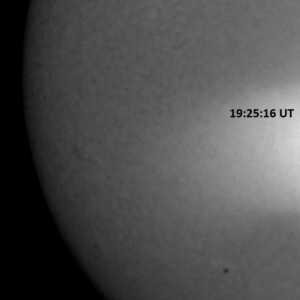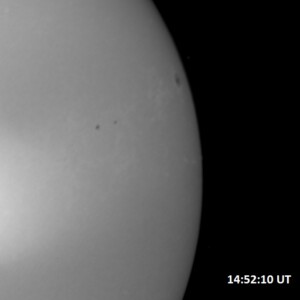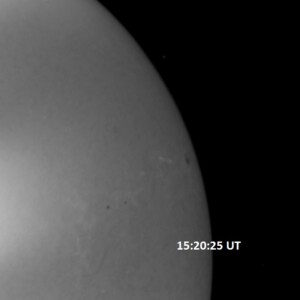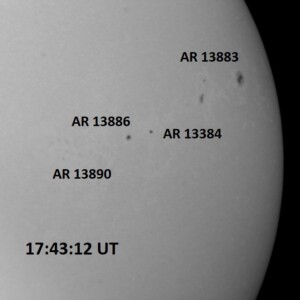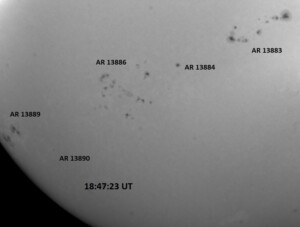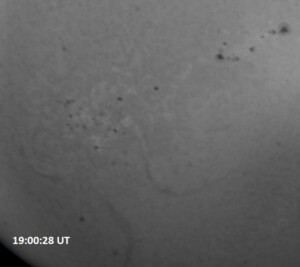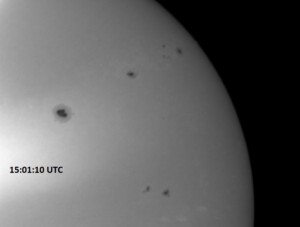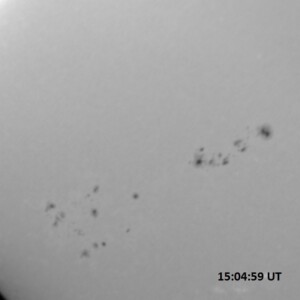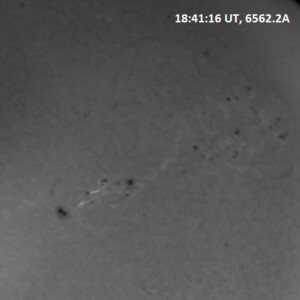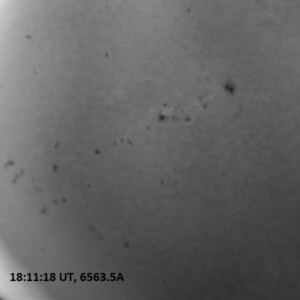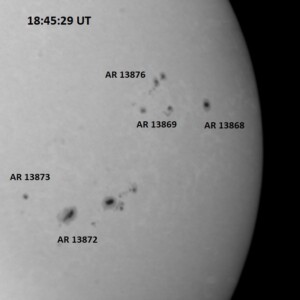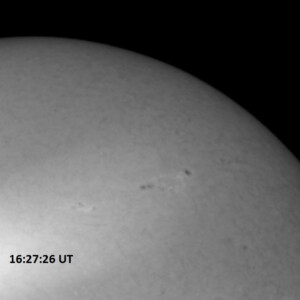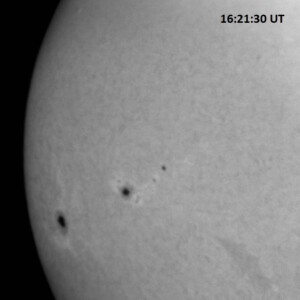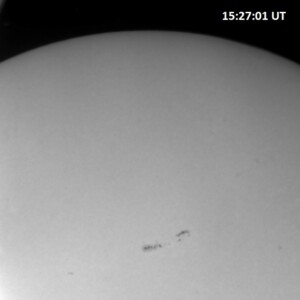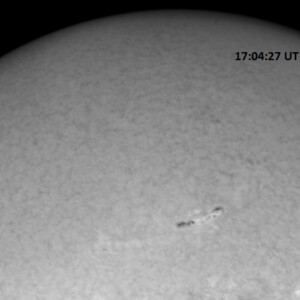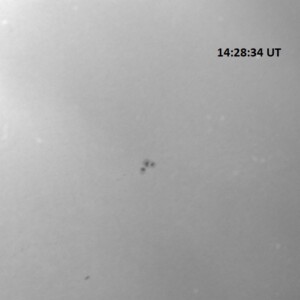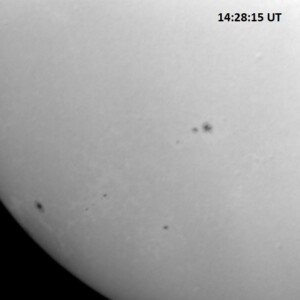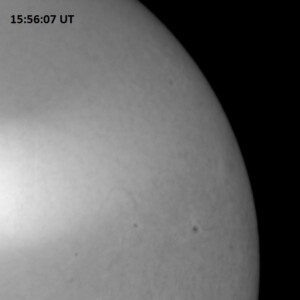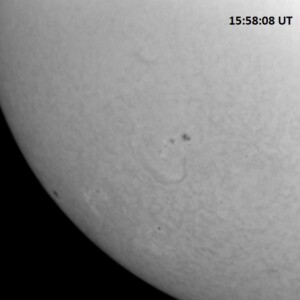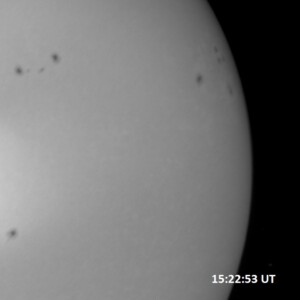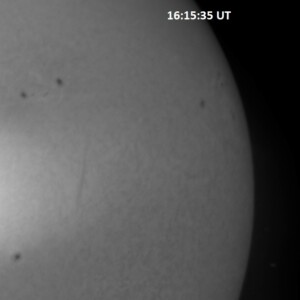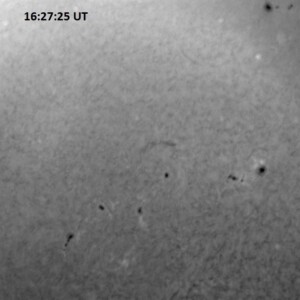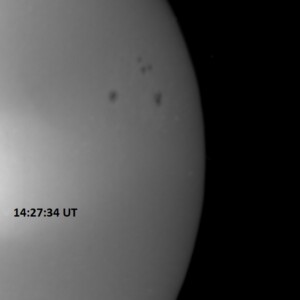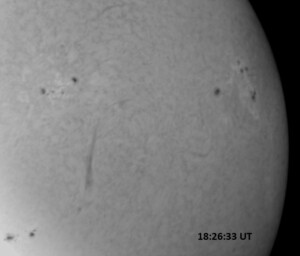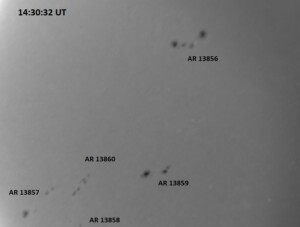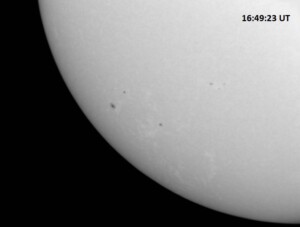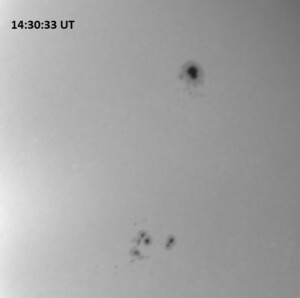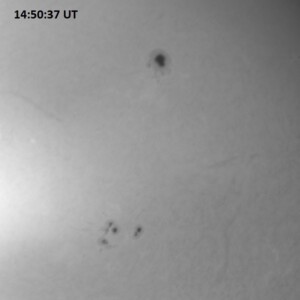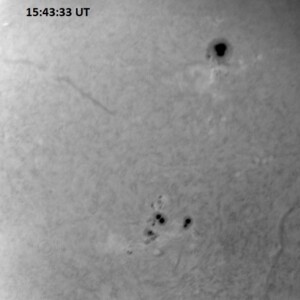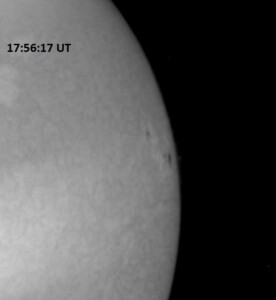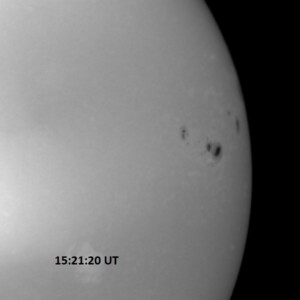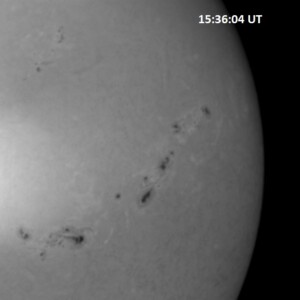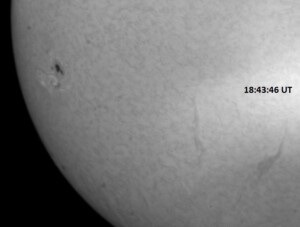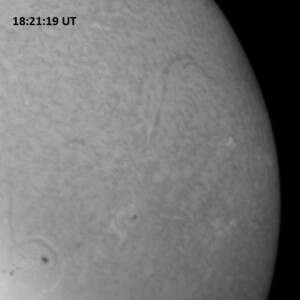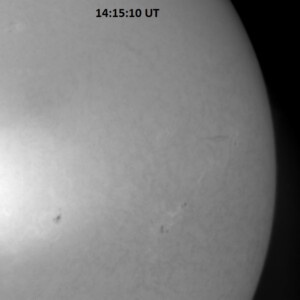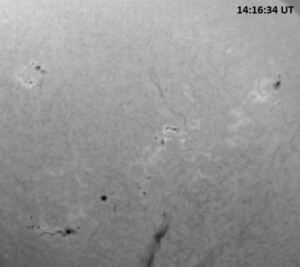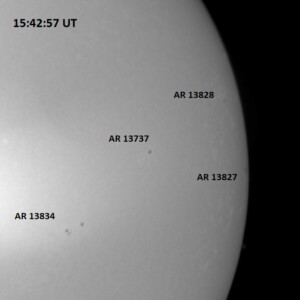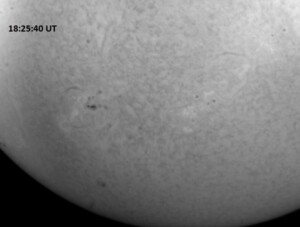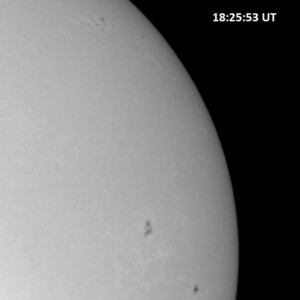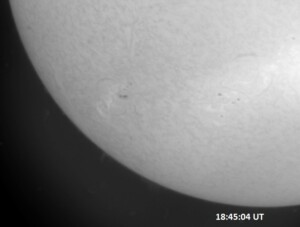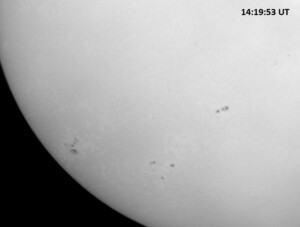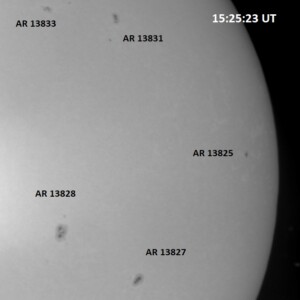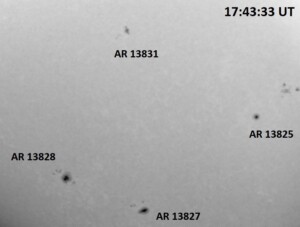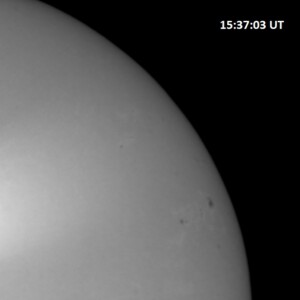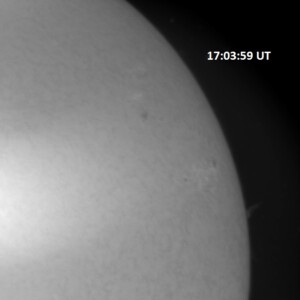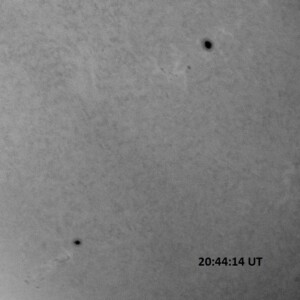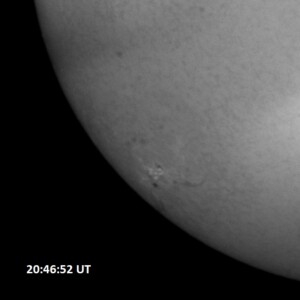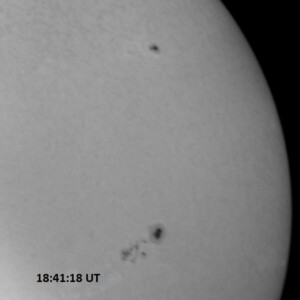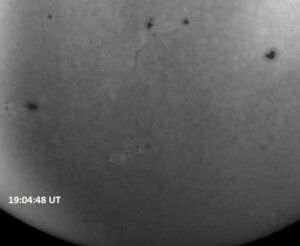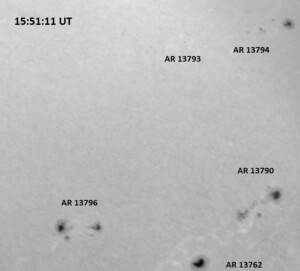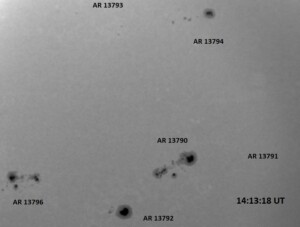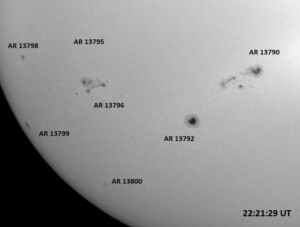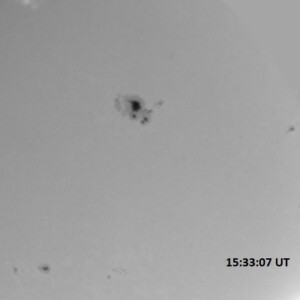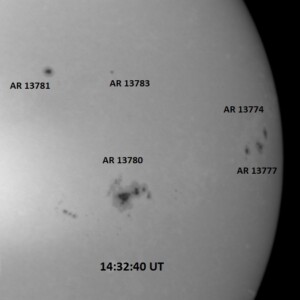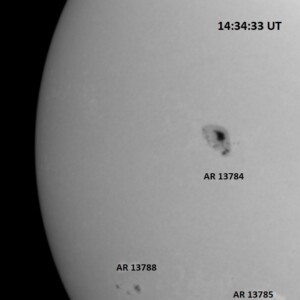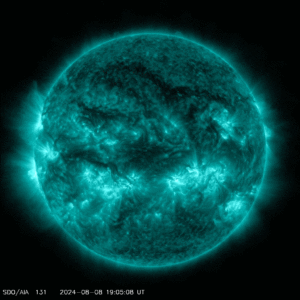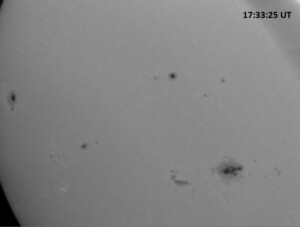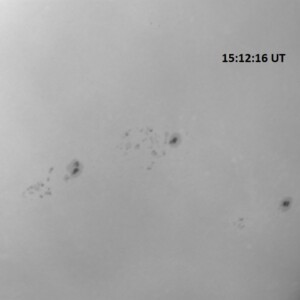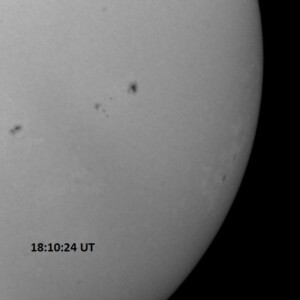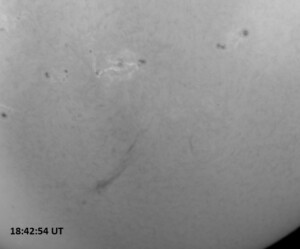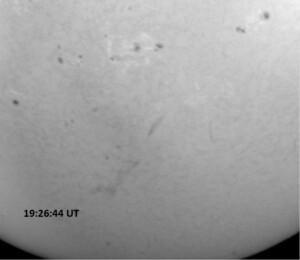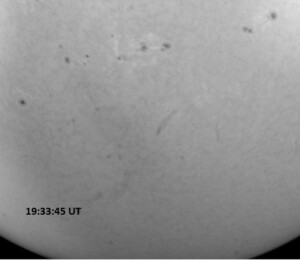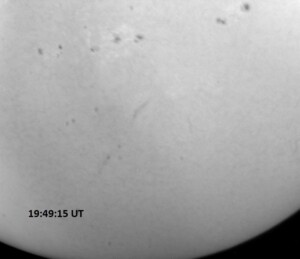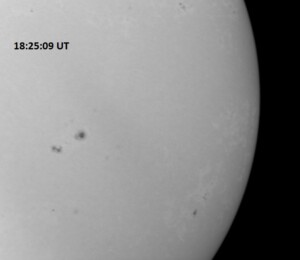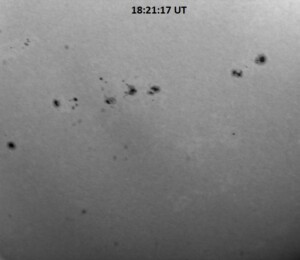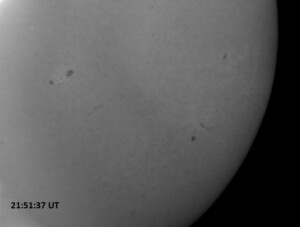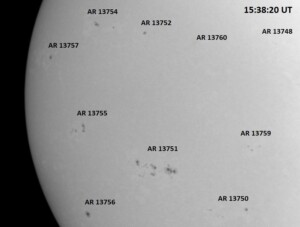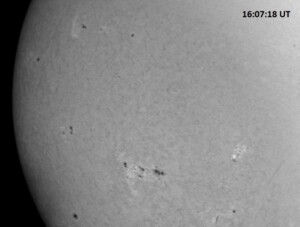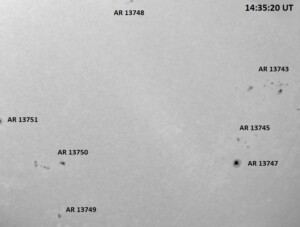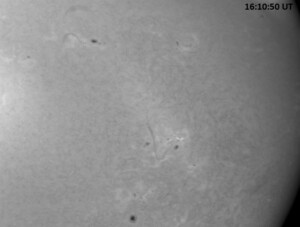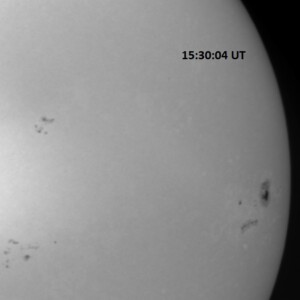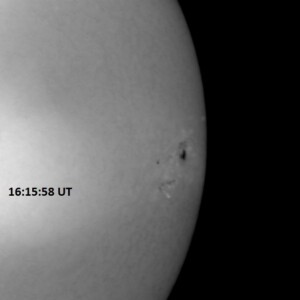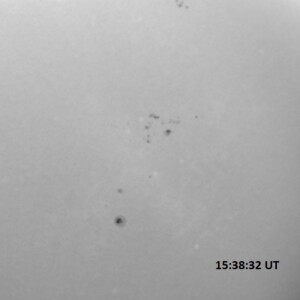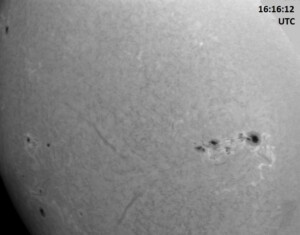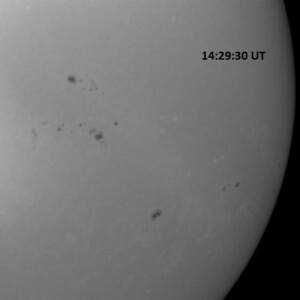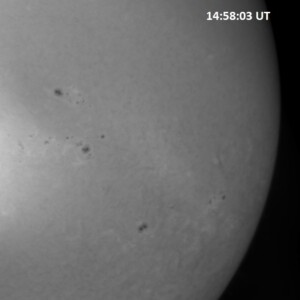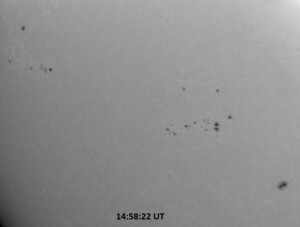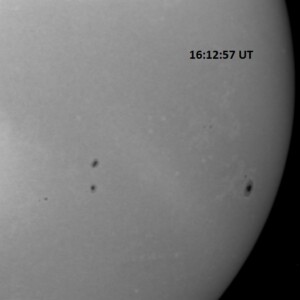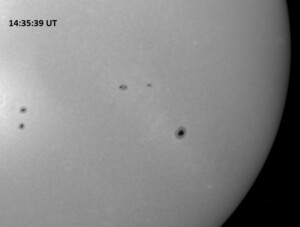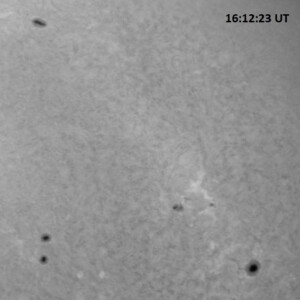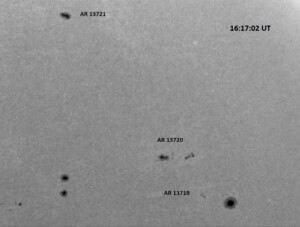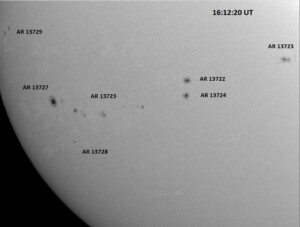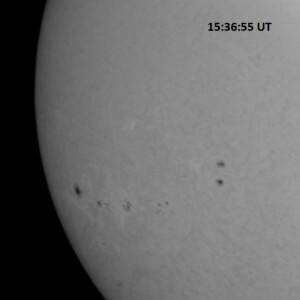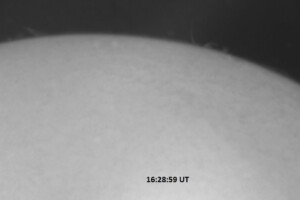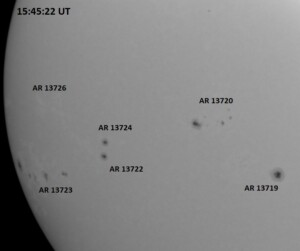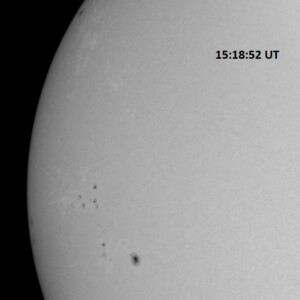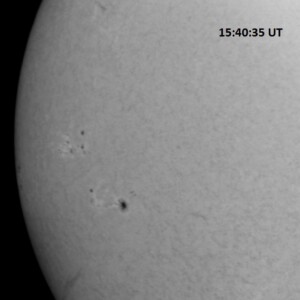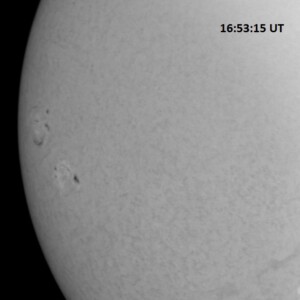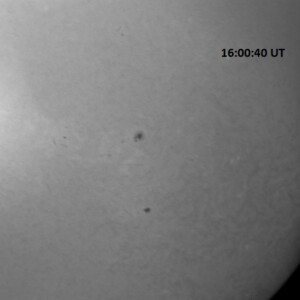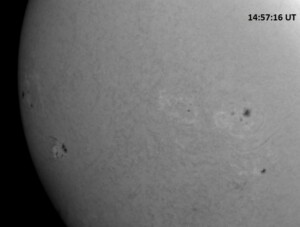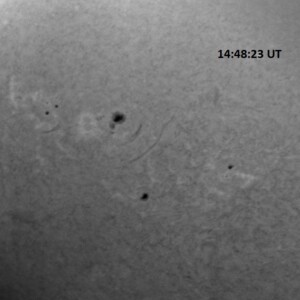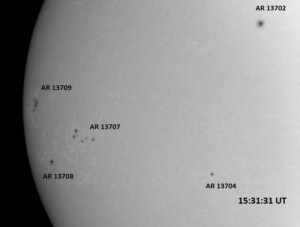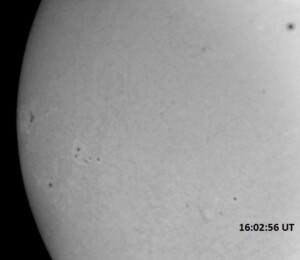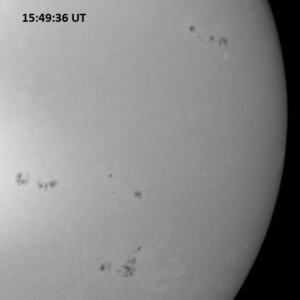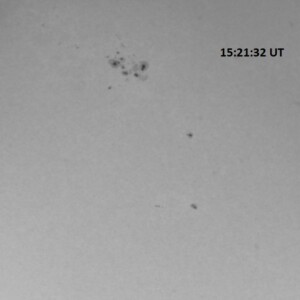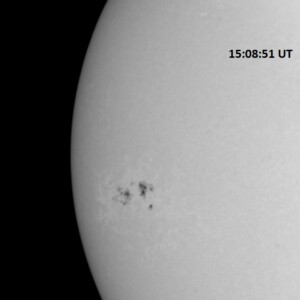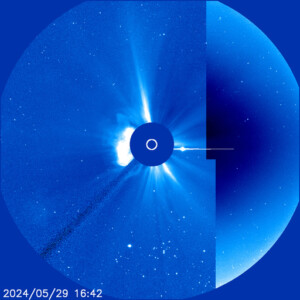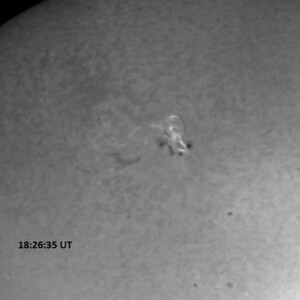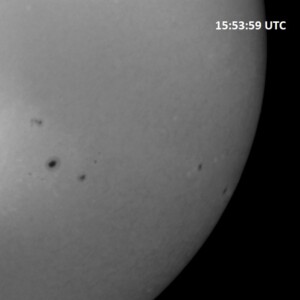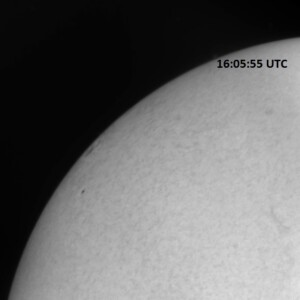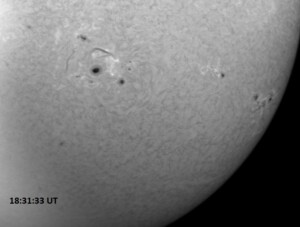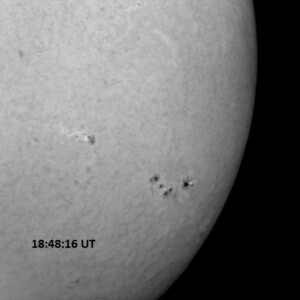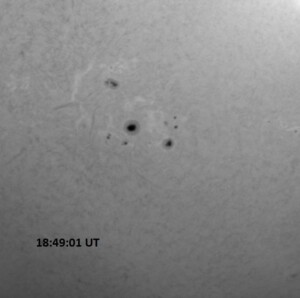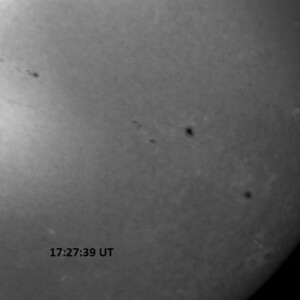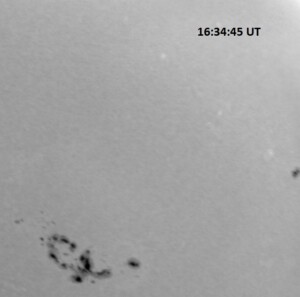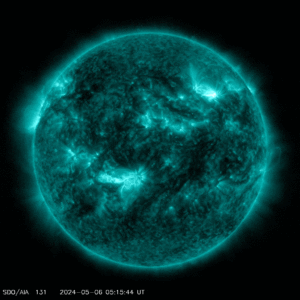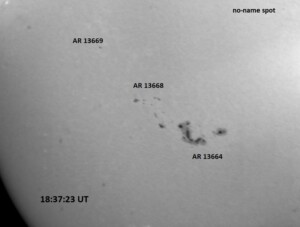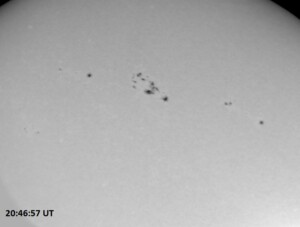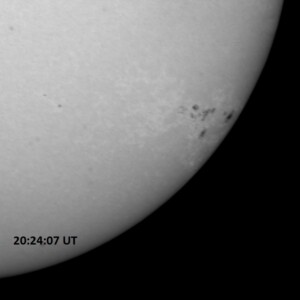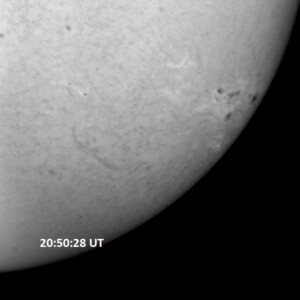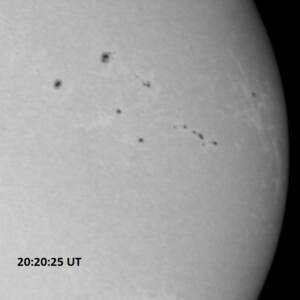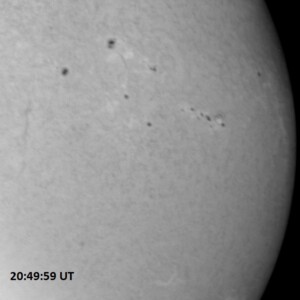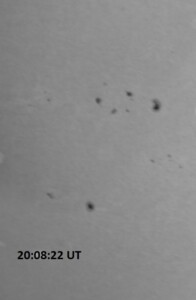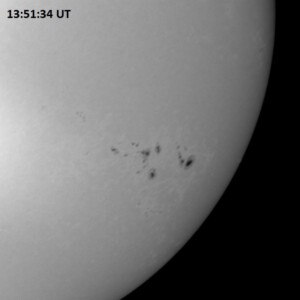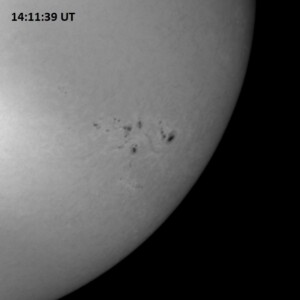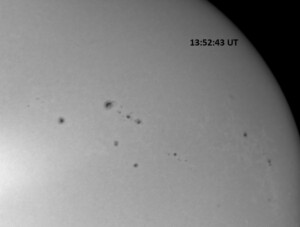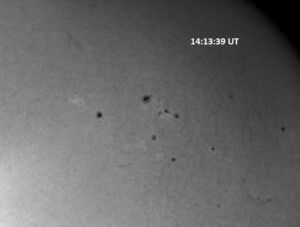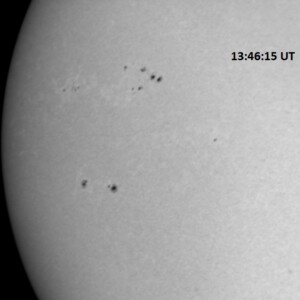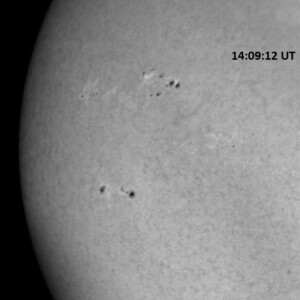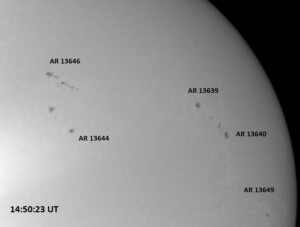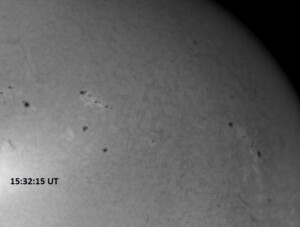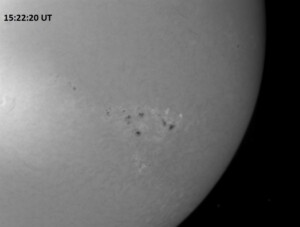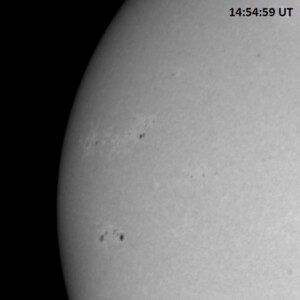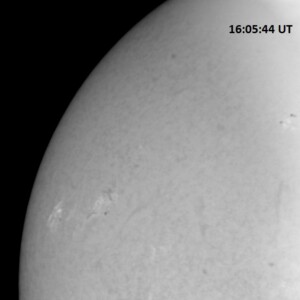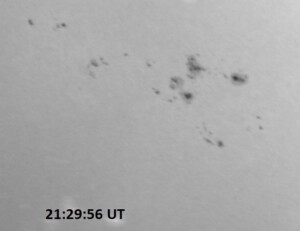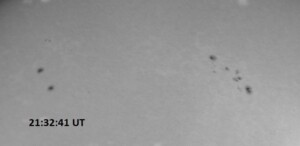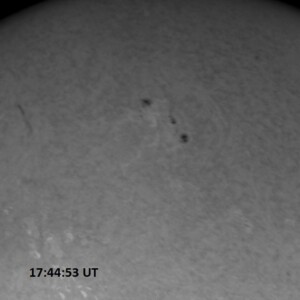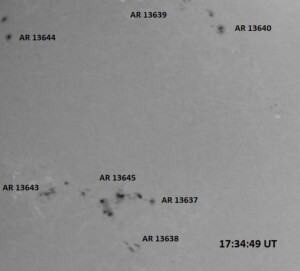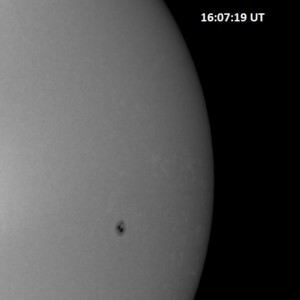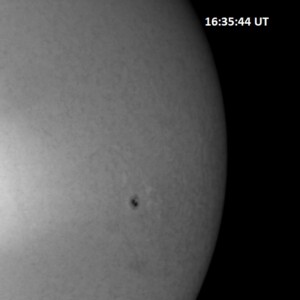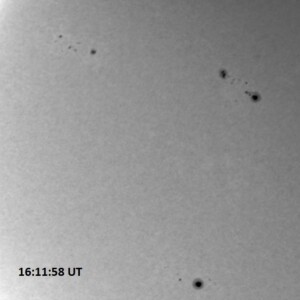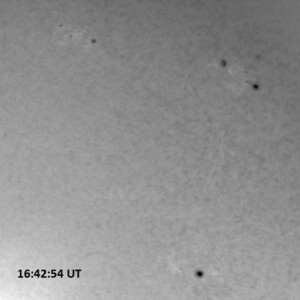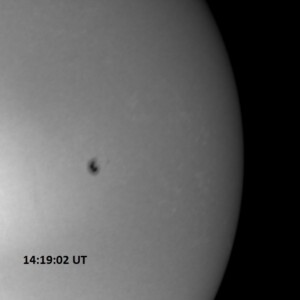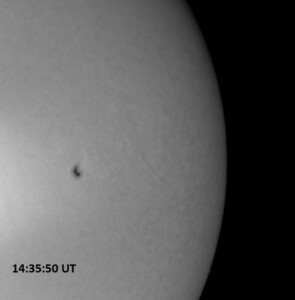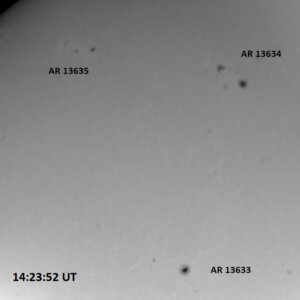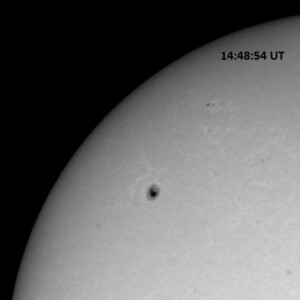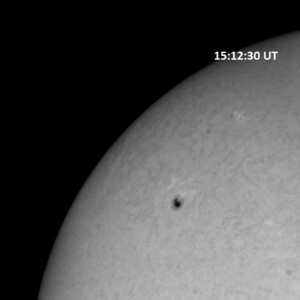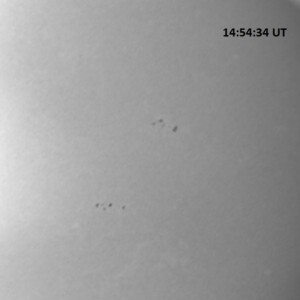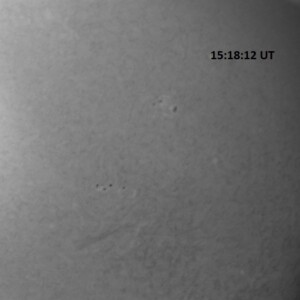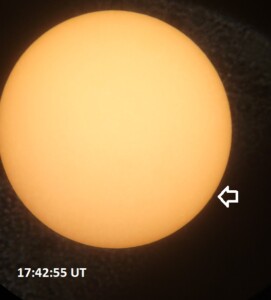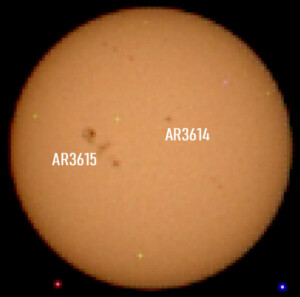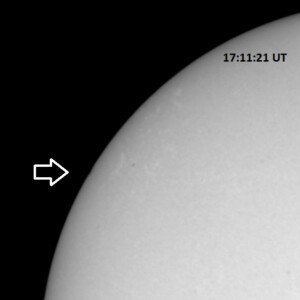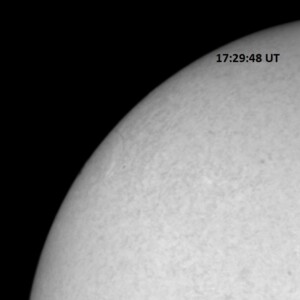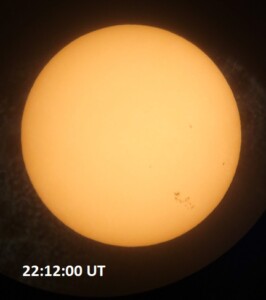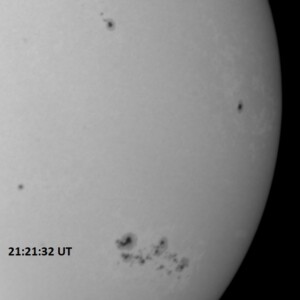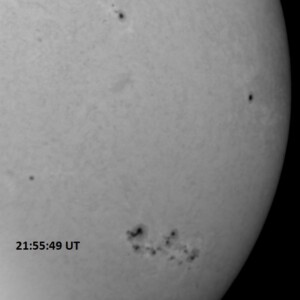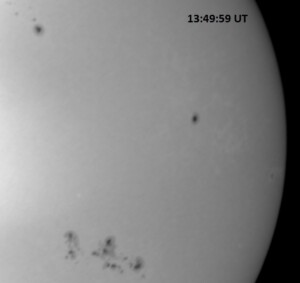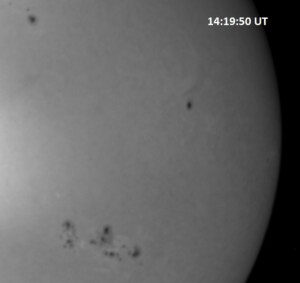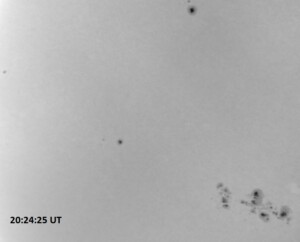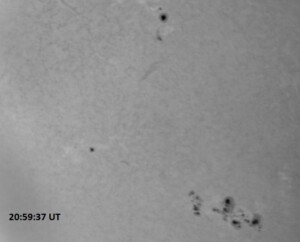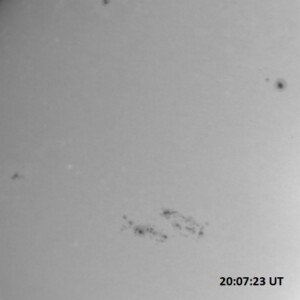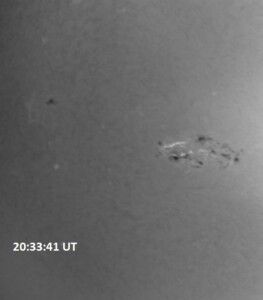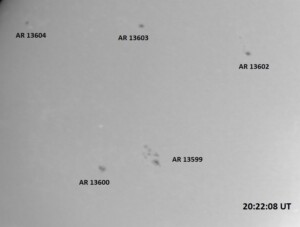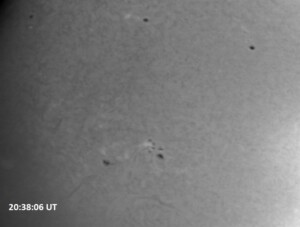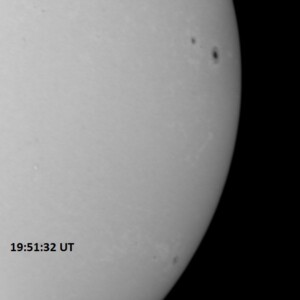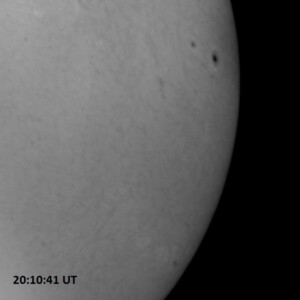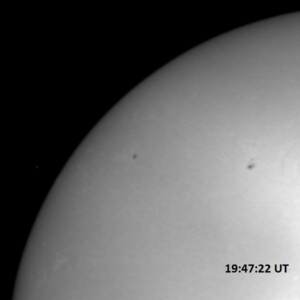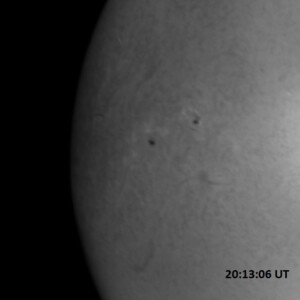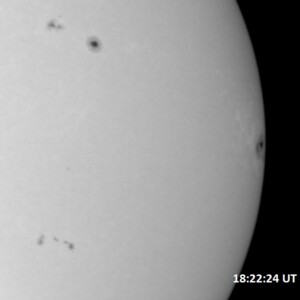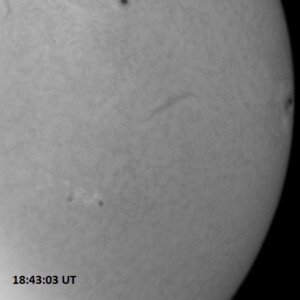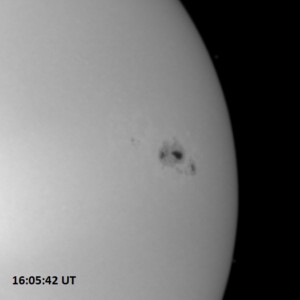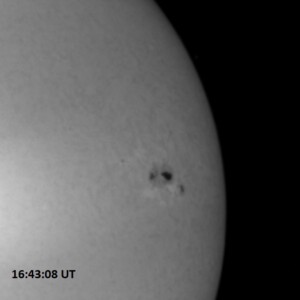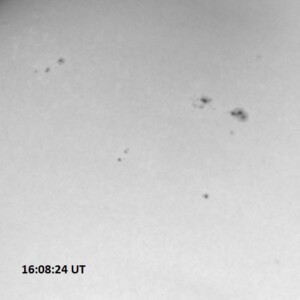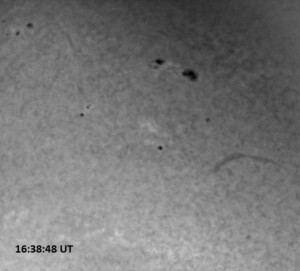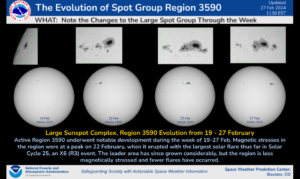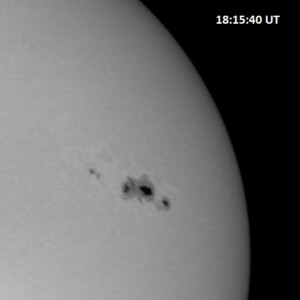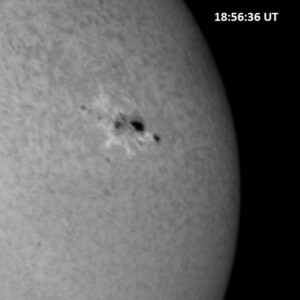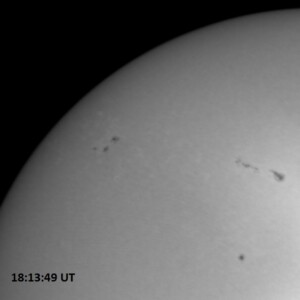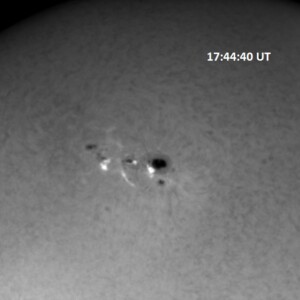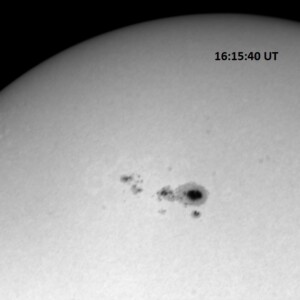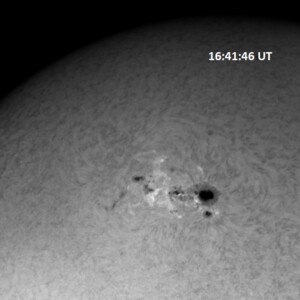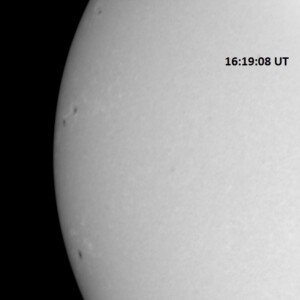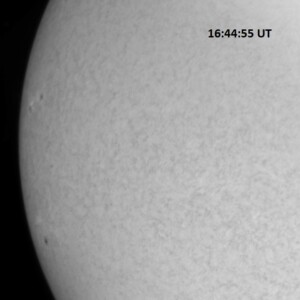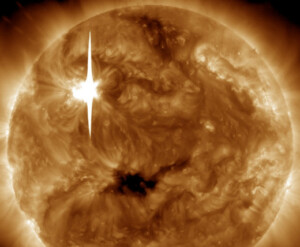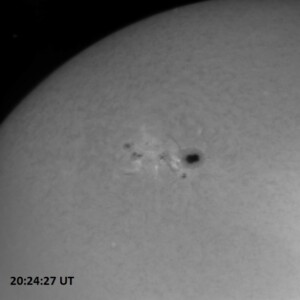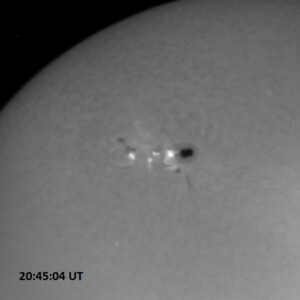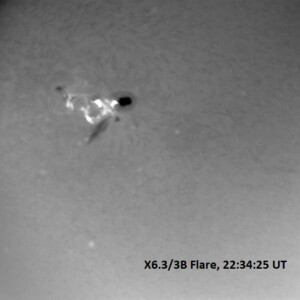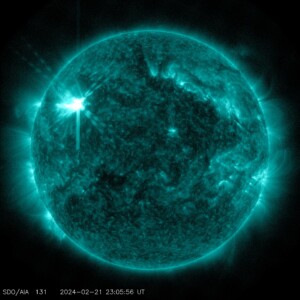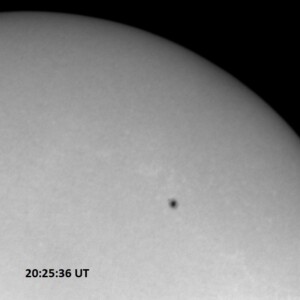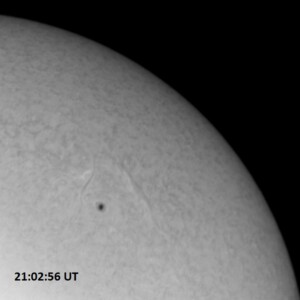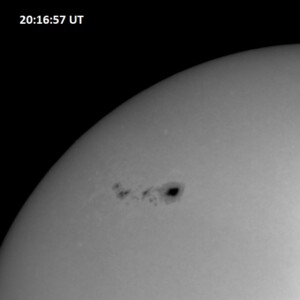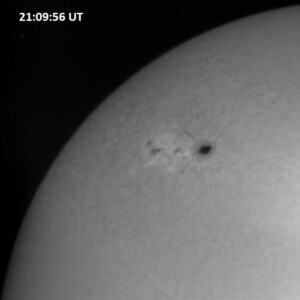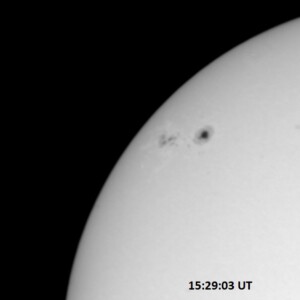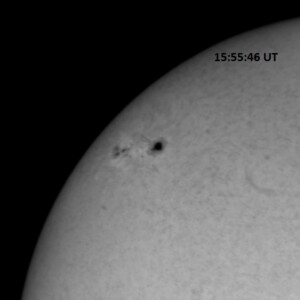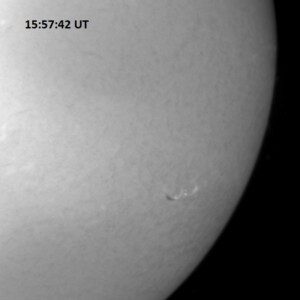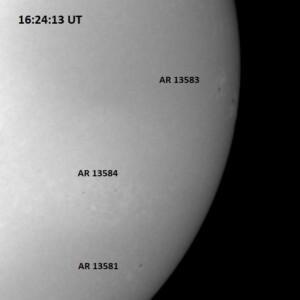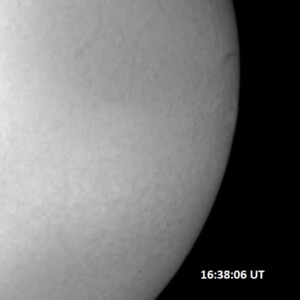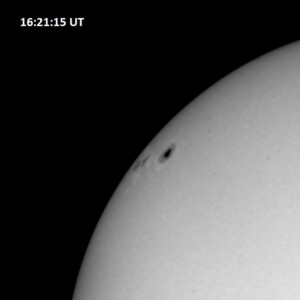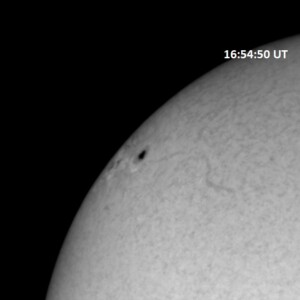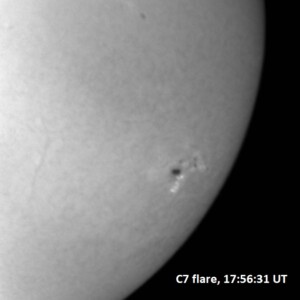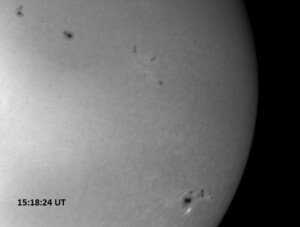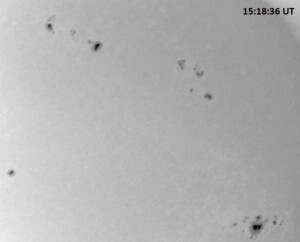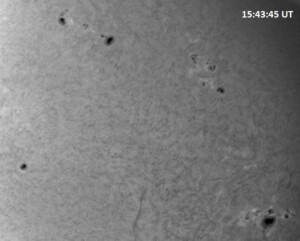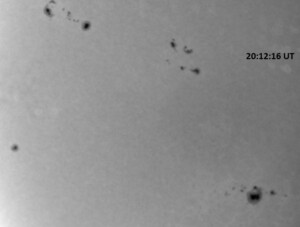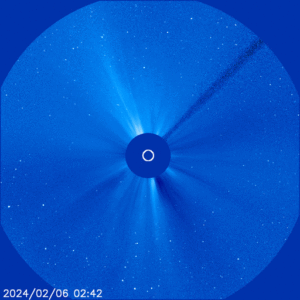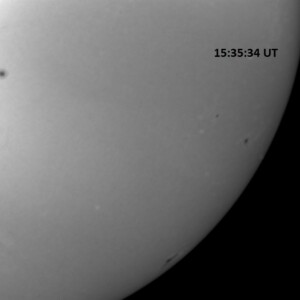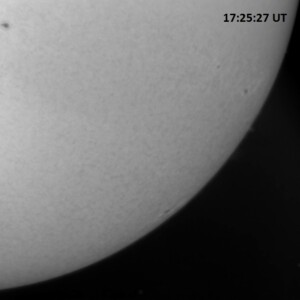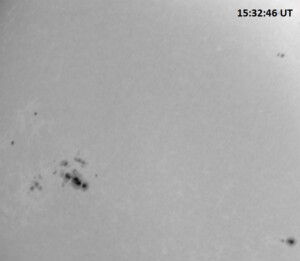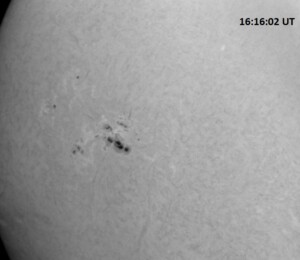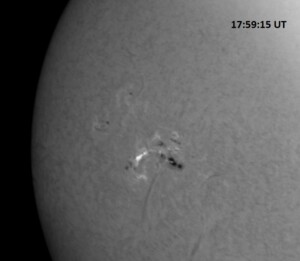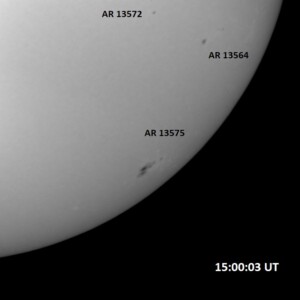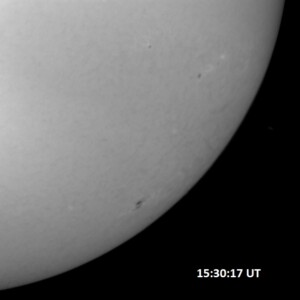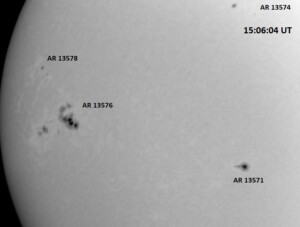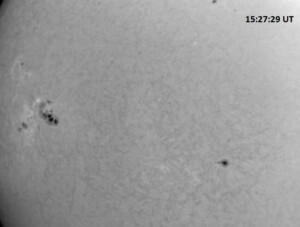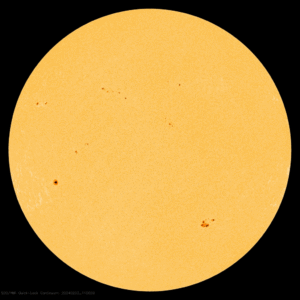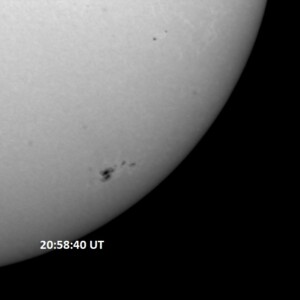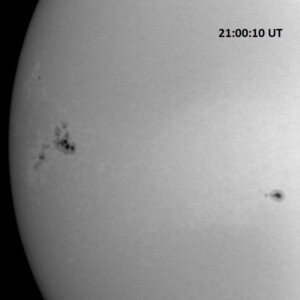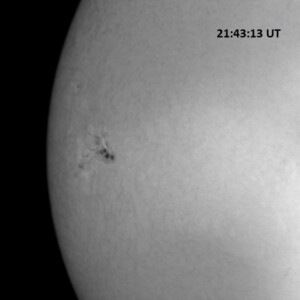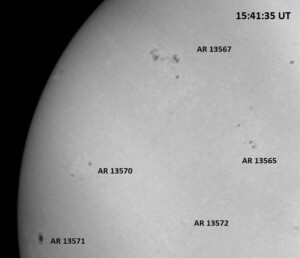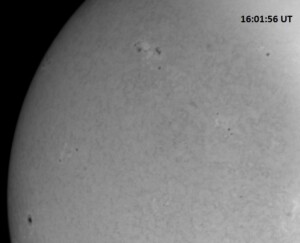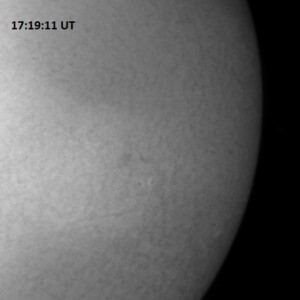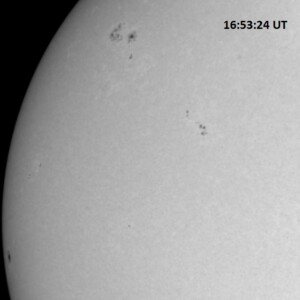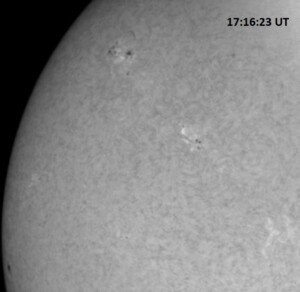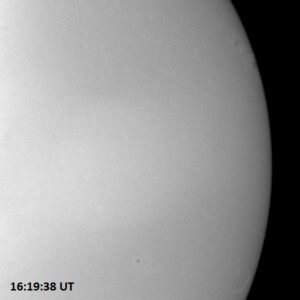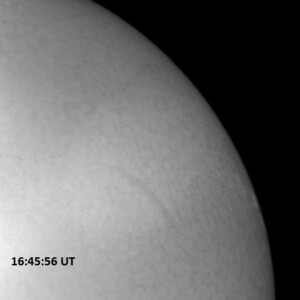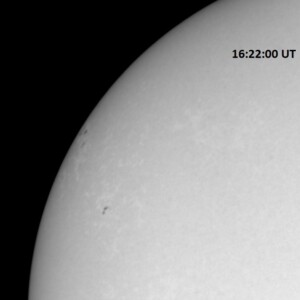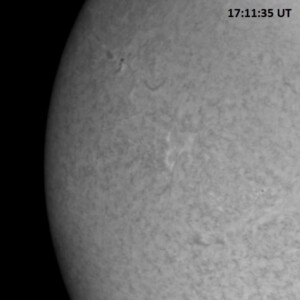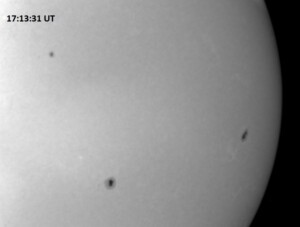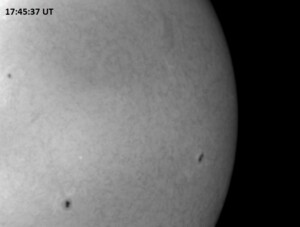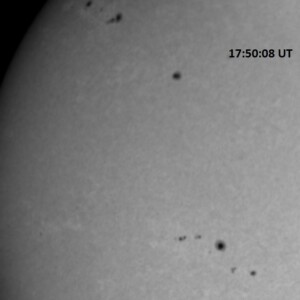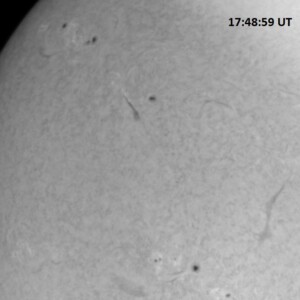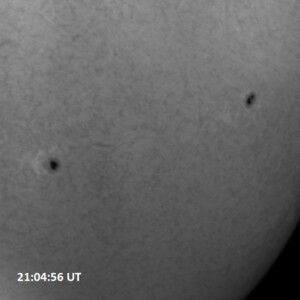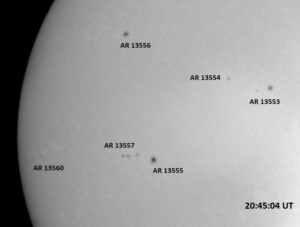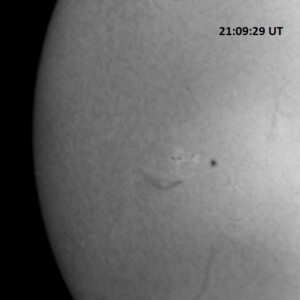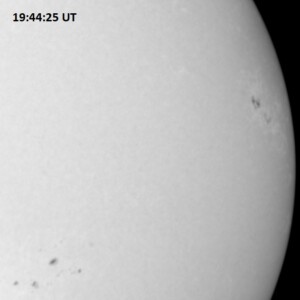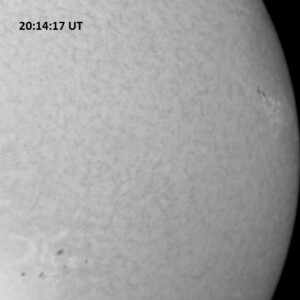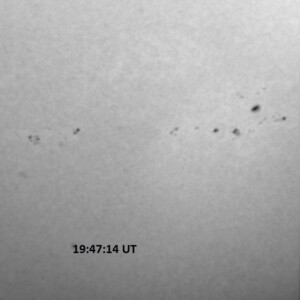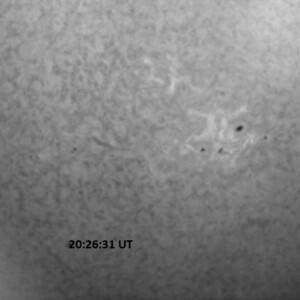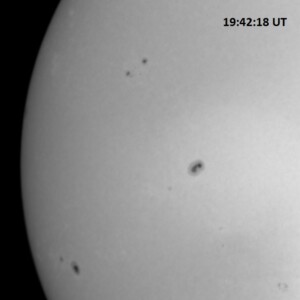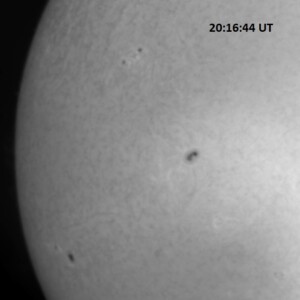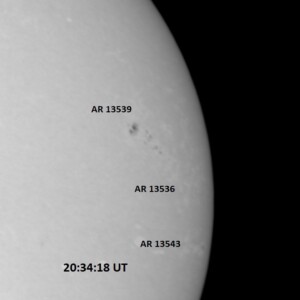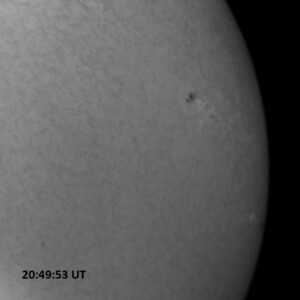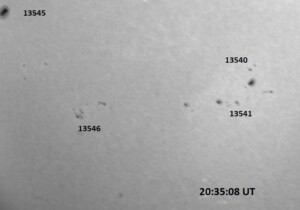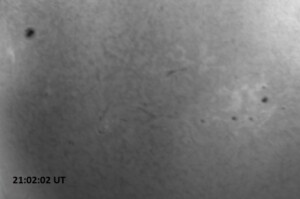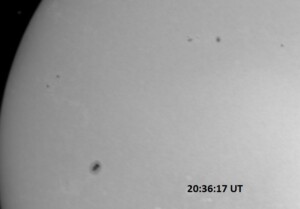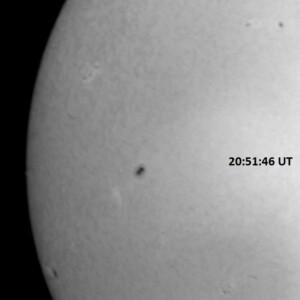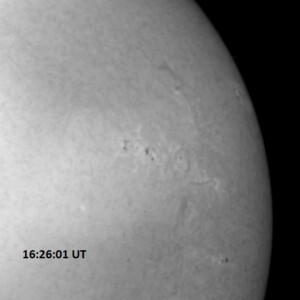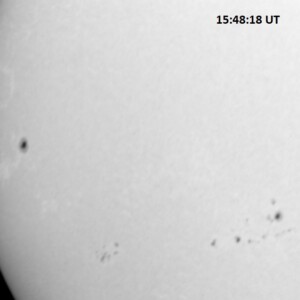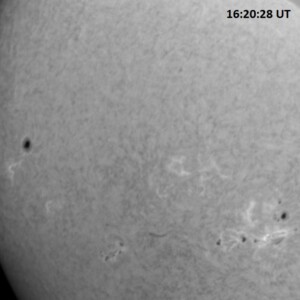The Latest Solar Images
Note: All images on this website © 2018-2024 by Brian Cudnik and Prairie View A&M Physics. All rights reserved.
Observations are happening daily, except for most Saturdays, all Sundays, and holiday periods; and are governed by duty schedule, weather, and solar activity. When the Sun has very low activity (spotless), observations will be limited or non-existent. Whenever the Sun becomes active again, the observing program will become active as well, weather permitting. The Sun is expected to reach the maximum activity level of the current Cycle 25 solar cycle. So we anticipate more events in terms of active region size and number, and solar flares.
One can monitor the Sun via several websites that provide real-time images of the Sun. The website, https://www.solarmonitor.org/, has such images in six different channels. The numbers are the NOAA designations for active regions (with the “1” at the start of the designation removed for convenience). Another website with up-t0-date information on solar activity and other goings-on in the skies is www.spaceweather.com. Additional information about the Sun’s current activity can be obtained from https://www.swpc.noaa.gov/, and real-time full-disk H-alpha images from observatories around the world can be viewed at http://halpha.nso.edu/.
A typical observing run may last from one to four hours, depending on seeing considerations, weather, and other work responsibilities, but will include active region monitoring of available active regions and the collection of frames for high-resolution solar mosaics in H-alpha. Each session includes at least one mosaic, which is a series of images made of all parts of the Sun’s disk that can later be stitched together to form a whole-disk image. At the very least, this ensures that all visible features such as prominences, filaments, and active regions (sunspot groups) are all captured in image form at least once per session. Usually observations are carried out in the late morning hours, but an additional session may occur in the mid-afternoon hours and it will include its own mosaic. If a sunspot group is expected to be active, then it becomes a main focus for observation for extended periods of time.
Solar activity is summarized in each day’s entry below, based on the forecast discussion product issued by the Space Weather Prediction Center each morning, along with observed activity (or lack of) the day of the featured observations. Regions are numbered by the NOAA/SWPC and are often provided in four-digit format (e.g. 3327), although I and other sources use the full five-digit designation (13327). Solar flares are described in terms of their X-ray intensity and optical “importance” (apparent brightness and area covered). One can learn more about the X-ray class of solar flares often discussed below by going to this website: https://www.spaceweather.com/glossary/flareclasses.html. Finally the SWPC 3-day forecast for solar activity is provided at the end of each entry.
More information about solar flares can be found at these websites: https://www.swpc.noaa.gov/phenomena; https://www.space.com/solar-flares-effects-classification-formation; and https://www.spaceweatherlive.com/en/solar-activity/solar-flares.html. I have also found the following website to be very useful: spaceweatherlive.com
The solar images are recorded through a Meade 16-inch f/8 Cassegrain telescope equipped with a 0.3 Å Hydrogen-alpha filter and a 16-bit, 3326×2504 pixel SBIG STF-8300 CCD camera. The aperture of the scope is stopped to 4-7/8 inch by an energy-rejection filter, which renders the system an f/26. A neutral density filter is added to bring the sunlight intensity down by 90%. Each image is automatically dark-subtracted as it is saved and each exposure is 0.1 second long for the red off-band continuum images and 0.5 second for the on-band H-alpha images. Flat field images are taken at periodic intervals throughout the observing session and are obtained by training the telescope to focus near the center of the Sun’s disk. Five images are then taken while dithering the frame 1′ to 5′ N,S,E, and W. The idea is to try to get images that are slightly blurred (either due to seeing or scope motion) and off set from each other. A set of 30 bias images (0-second exposures with the dome closed and scope parked) are taken at the end of each observing session.
Select images are processed for further study and display. A program called MaxIM DL is used to do basic calibration (bias-subtraction and flat field correction), and the levels are adjusted for optimum display contrast. Choice images are then selected for online display. All of the images are archived in their raw FITS format, sorted by date, and backed up twice. At a later time we can mass process these and make them available for scientific use. Inquiries can be made of Brian Cudnik, at bmcudnik@pvamu.edu, or Premkumar Saganti, at pbsaganti@pvamu.edu.]
NOTE: Images of the April 8 solar eclipse are posted at https://www.pvamu.edu/pvso/cosmic-corner/partial-solar-eclipse/.
Observations have been conducted since then at the PVSO, primarily with H-alpha. There was a period of time when magnetospheric data were collected but the work had primarily been regional H-alpha images of active regions and filaments. Regular observations continued through the mid-2000’s, then became more sporadic through 2015. After a five-year pause, regular observations resumed (in their current format) on 8 January 2020.
November 15,2024
Solar activity returned to moderate levels due to an M1.1 at 1:46 UTC on 15 November from AR 13893. There was an M1.0 from the same region at 12:15 UTC on 15 November. Since these two events, the Sun had not produced another M-class or higher events for the rest of the day, only low level C-class flares occurred, mostly from AR 3889. The rest of the spots were either stable or in decay.
A CME was observed associated with a filament that erupted off the east southeast limb of the Sun. This became visible in the SOHO C2 instrument at 20:24 UT on 14 October. A second CME was seen associated with a filament eruption in the southeastern part of the Sun’s disk Both CME’s are being analyzed for an Earth directed component.
The left column displays red continuum images, each with exposures of 0.25 seconds; the right column are the H-alpha exposures, with exposures of 0.5 seconds. Each of the images cover 13.8’x13.8′ on the sky. Celestial north is up, east is left in each image. The white spots on some of the images are artefacts of the processing.
M-class flares are likely, with a chance for an X-class flare, through 18 November.
This will be the last solar blog entry for the rest of the calendar year as we plan to ship the H-alpha filter to the manufacturer to get it refurbished.
November 14,2024
Solar activity dropped back to low levels. In spite of its magnetic complexity, AR 13889 has not produced any further M-class or greater flares (through 22:55 UT on 14 November) since the M1.7 we observed yesterday. reached moderate levels due to an M1.7 flare at 13/1708. This region has grown slightly but has been quiet otherwise. AR 13894 emerged on the east northeast part of the sun’s disk since yesterday. All the other spot groups were stable or in decay.
The M1.7 flare produced a narrow coronal mass ejection that was observed by the SOHO satellite, starting at 17:12 UTC on the 13th (while the flare was still in progress). There is a weak impact on the Earth’s magnetic field possible on 17 November.
The left column displays red continuum images, each with exposures of 0.5 seconds; the right column are the H-alpha exposures, with exposures of 0.5 seconds. Each of the images cover 13.8’x13.8′ on the sky. Celestial north is up, east is left in each image. The white spots on some of the images are artefacts of the processing.
M-class flares are likely, with a chance for an X-class flare, through 16 November.
November 13,2024
Solar activity was at low levels, then returned to moderate levels today midday. The first M-class flare happened after the all-day observation session yesterday: an M1.0/1F from AR 13889 at 0:22 UT on 13 November. Then there was a C8.2 flare at 14:01 UTC yesterday related to a filament eruption on the WNW limb of the Sun. Some decay was noted in AR’s 13883 and 13889, and the rest of the 8 (total) spotted regions were stable or in decay.
An M1.7 was observed from AR 13889 (it appeared to be from a location between 13889 and 13891), peaking at 17:08 UT. The image below shows the event one minute after the X-ray peak.
The left column displays red continuum images, each with exposures of 0.25 seconds; the right column are the H-alpha exposures, with exposures of 0.5 seconds. Each of the continuum images cover 13.8’x18.0′, while the H-alpha images cover 13.8’x13.8′ on the sky. Celestial north is up, east is left in each image. The white spots on some of the images are artefacts of the processing.
M-class flares are likely, with a chance for an X-class flare, through 15 November.
November 12,2024
Solar activity dropped back to low levels. There was a 65% chance for AR 13889 to produce an M-class flare, and a 25% chance for it to produce an X-class flare, but our observing session, which lasted all day, found neither. Instead, AR 13889 produced five C-class flares, all of which occurred before we opened at 14:45 UT. The largest event today was a long-duration C8.2, which did not come from a numbered region. The largest flare that AR 13889 produced, yesterday or today, was a C4.4 at 14:28 UT on 11 November. This quiet continued right through 23:45 UT today.
AR 13890 was the source of a C1.7 flare at 21:19 UT today, and AR 13884 produced a C4.2/SF event at 7:58 UT today. The filament eruption from November 11, 14:28 UT produced a CM that will not hit the Earth.
The left column displays red continuum images, each with exposures of 0.25 seconds; the right column are the H-alpha exposures, with exposures of 0.5 seconds. Each of the images cover 13.8’x13.8′ on the sky. Celestial north is up, east is left in each image. The white spots on some of the images are artefacts of the processing.
M-class flares are likely, with a chance for an X-class flare, through 14 November.
November 11,2024
Solar activity reached high levels yesterday as AR 13889 produced an M9.4/2B flare at 12:06 UT on 10 November. It was also the source of an M4.2/1B at 0:15 UT yesterday and an M4.9 flare at 20:21 UTC yesterday. This region remains the largest and most magnetically complex active region on the visible disk. AR 13889 then produced a pair of M1 flares 17 minutes apart starting at 5:26 UT, 11 November. Since then there were only two C-class flares and, as of 21:55 UT, 11 November, no further M-class or greater flares. So today, solar activity drops back to moderate levels.
A filament erupted in the NE quadrant of the solar disk around 0:00 UT on 11 November. This produced a narrow CME that was observed by SOHO beginning at 1:25 UT. There are several prominent filaments visible on the solar disk today.
The left column displays red continuum images, each with exposures of 0.25 seconds; the right column are the H-alpha exposures, with exposures of 0.5 seconds. Each of the images cover 13.8’x13.8′ on the sky. Celestial north is up, east is left in each image. The white spots on some of the images are artefacts of the processing.
There is a continued likelihood for M-class flares, with a chance for an X-class flare, through 13 November.
November 7,2024
Sky conditions became partly cloudy by midday to allow observations of the Sun and monitoring of several active regions that have the potential of flaring. From yesterday through today, there was a total of 14 M-class flares and the X-class flare mentioned yesterday. No further X-class flares have occurred through 23:00 UT today. AR 13883 continues to grow, while AR 13889 is in the process of rotating into view. The rest of the spotted regions are stable or in slight decay.
A filament in the southeast quadrant of the Sun began to erupt beginning at 5:05 UTC on 7 November. This generated a CME that became visible at 5:53 UT launching off the southwest limb of the Sun. This CME is expected to miss Earth.
The left column displays red continuum images, each with exposures of 0.25 seconds; the right column are the H-alpha exposures, with exposures of 0.5 seconds. The continuum images each cover 13.8’x18.0′ on the sky; the top H-alpha image spans 13.8’x13.8′ on the Sun; the bottom, 13.8×15.4′. Celestial north is up, east is left in each image. The white spots on some of the images are artefacts of the processing.
Solar activity is expected to be moderate with continued M-class flaring and a chance for an X-class flare through 10 November. AR 13883, 13886, and 13889 continue to drive the high flaring probabilities.
November 6,2024
Beautiful clear skies and high flare potential meant for a day long observation session. There was a 35 % probability for an X-class flare to happen from AR 13883. Unfortunately it happened too soon for today’s observing session. It peaked at X2.3 at 13:40 UT, a little over one hour from opening. Also, new AR 13887 produced an M5.8 flare at 8:50 UT today. This region grew quickly over the last day and a half but contained a simple magnetic configuration. AR 13883 had produced M-class flares yesterday and today. Some of the M-class flares came, and continue to come from beyond the SW limb of the Sun. The likely culprit of these is AR 13872. AR 13886 grew some and maintains a fair amount of magnetic complexity.
The above image is a solar dynamics observatory (SDO) still image taken five minutes after the peak of this morning’s flare. All was quiet during our 7 hour observing session, but we may have captured an M1.3 flare which occurred during one of the automated imaging series. It peaked at 20:42UT from AR 13883
The top two frames of the left column displays the red continuum images, each with exposures of 0.25 seconds; the remaining frames are the H-alpha exposures, with exposures of 0.5 seconds. The bottom two images are off-band H-alpha line exposures at -0.6 and +0.7 Angstroms, relative to line center. Each of the images below cover 13.8’x13.8′, except for the top row images, which each cover 13.8’x18.0′ on the sky. Celestial north is up, east is left in each image. The white spots on some of the images are artefacts of the processing.
Solar activity is expected to be moderate with continued M-class flaring and a chance for an X-class flare through 9 November. AR 13883 and 13886 continue to drive the high flaring probabilities.
November 5,2024
After several days with no observations due to inclement weather, the skies appeared to be clearing out around midday. The forecast called for partly sunny so we resumed observations. However, as we were finishing the white light sequence, the sky filled back in with clouds and stayed that way until 21:15 UT when the vigil was ended due to afternoon classes.
Solar activity had been high in recent days due to the large number of M-class flares. There was an M5.5 event from AR 13883 at 15:41 UT on 4 November. This was the main producer of flares over the last couple days with AR 13878 contributing a few C-class and optical sub-flares. AR 13883 has grown a bit after some decay, while its neighboring region, AR 13886 grew. There were twenty (20) M-class flares over the last three days, the largest of these was the M5.5 just mentioned. AR 13883 maintains a magnetic configuration that favors high flare activity. An M4.2 flare happened today at 15:05 UT which came from another location: AR 13869, which had rotated out of view yesterday. AR 13886 has a considerably complex magnetic configuration.
Each of the below images was taken in the red continuum, 0.5 second exposures. Celestial north is up, west right in each image. The first image covers 13.8’x13.8′ on the sky; the second covers 13.8’x18.0′ on the sky.
Solar activity is expected to remain moderate with continued M-class flares and a chance for X-class flares through 8 November. ARs 13883 and 13886 have the highest flare potential of all the visible active regions.
October 31,2024
The skies cleared for a few hours this afternoon allowing for a full observing session. Solar activity reached high levels due to 4 M-class flares and an X-class flare. AR 13872 was responsible for three M-class flares and the X-class flare. There was an M7.2 at 20:53 UT on 30 October, then an M1.1 at 3:30 UT on 31 October, and finally an M1.4 at 9:37 UT on 31 October. This region continues to grow. AR 13878 then produced an X2.0/3B flare at 21:20 on 31 October, which was preceded only 10 minutes earlier by an M4.6. AR 13876 produced aC9.3 flare at 00:51 UT on 31 October, as well as an M1.2 at 13:55 UT on 31 October, an M1.0 at 19:07 UT on 31 October, and several C-class flares. AR 13875 produced an M2.4 at 12:54 UT today. None of the above flares, except possibly the X2.0 event (this remains to be seen) have produced detectable CME’s. All the other regions were either stable or in slow decay.
This multi-color extreme UV image shows the X2 flare in animation form. Click on the image for the animation. In anticipation of more inclement weather, this will be the last observation session until at least 4 November.
The left column displays red continuum images, each with exposures of 0.5 seconds; the right column are the H-alpha exposures, with exposures of 0.5 seconds. Each of the five images below cover 13.8’x13.8′. Celestial north is up, east is left in each image. The white spots on some of the images are artefacts of the processing.
Solar activity is expected to remain moderate, with a chance of X-class flares through 2 November.
October 30,2024
Solar activity has returned to low levels. Observations today made through clouds, with some breaks allowing for some imaging later in the morning.
Since yesterday’s M1 flare, there had been no further M-class flares through 18:40 UT today. The largest event today was a long-duration C7.1 from AR 13876 at 10:17 UT. After this event, this region had produced most of the activity so far today. Prior to this event, AR 13878 was fairly active with C-class and optical sub-flares. Both AR 13876 and 13878 showed growth, as did AR 13874. All the remaining regions were either stable or in slight decay. There are a total of 11 spotted regions on the visible disk of the Sun today.
The left column displays red continuum images, each with exposures of 0.5 seconds; the right column are the H-alpha exposures, with exposures of 0.5 seconds. Each of the five images below cover 13.8’x13.8′. Celestial north is up, east is left in each image. The white spots on some of the images are artefacts of the processing.
Solar activity is expected to remain moderate, with a chance of X-class flares through 1 November.
October 29,2024
Solar activity has been moderate, with three M-class flares since yesterday: two happened yesterday and one today. The two yesterday are already mentioned on the previous day, with the one today coming from AR 13873. It was an M1.1/1F that peaked at 16:29 UT today (before today’s observing session). AR 13878 contributed 3 C-class flares today; AR 13876 produced one, all of these occurring before 13:09 UT. AR 13878 produced an optical sub-flare at 14:37 UT today. Since the M1 flare, solar activity has been low, with no further significant reported flare activity through 22:25 today. AR’s 13874, 13876, and 13872 are all fairly large and magnetically complex but they al remained stable and except for a single C-class flare from 13876, have not produced any flares today. All the other regions are either stable or slowly decaying.
The top row displays red continuum images, each with exposures of 0.25 seconds; the bottom row are the corresponding H-alpha exposures, with exposures of 0.5 seconds. Each of the images cover 13.8’x13.8′ on the sky. Celestial north is up, east is left in each image. The white spots on some of the images are artefacts of the processing.
Solar activity is expected to remain at moderate levels, with a chance for X-flares through 31 October due to the conglomeration of active regions with enhanced magnetic complexities near ARs 13872 and 13873, along with AR 13878.
October 28,2024
Solar activity has been moderate. An X1.8 flare happened on 26 October at 7:19 UT. This came from the area near AR’s 13872 and 13873. So far there has not been another X-class flare (as of 21:15 UT, 28 October) but several M-class flares. AR 13878 produced three M-class flares late yesterday and today: an M2.8 at 23:24 UT on 27 October, an M1.3 at 4:09 UT on 28 October, and an M4.2 at 16:28 UT on 28 October. We observed most of the M4.2 event but clouds hindered some of these observations. AR 13878 was the source of several C-class flares. ARs 13869, 13874, and 13876 all produced C-class flares. ARs 13874 and 13876 were the only regions which show signs of growth. Most of the rest of the spot groups were either stable or in decay.
The top row displays red continuum images, each with exposures of 0.25 seconds; the bottom row are the corresponding H-alpha exposures, with exposures of 0.5 seconds. Each of the images cover 13.8’x13.8′ on the sky unless otherwise indicated. Celestial north is up, east is left in each image. The white spots on some of the images are artefacts of the processing.
Solar activity is expected to remain at moderate levels, with a chance for X-flares through 30 October due to the conglomeration of active regions near ARs 13872 and 13873, along with AR 13878.
October 24,2024
Solar activity rose to high levels due to an X3.3/SF flare from AR 13869. This active region is actually old active region 13842, which has survived its two week passage on the far side of the Sun and has been carried back into our view by the Sun’s rotation. An SDO animation of the event is shown immediately below (click for the animation).
The X3 flare did generate a CME but it will pass to the south and east of the Earth. AR 13869 produced an M1.2/SF at 10:29 UT. Since this event, and through 22:35, there were no further M- and X-class flares. The rest of the solar regions were unremarkable.
The left column displays red continuum images, each with exposures of 0.25 seconds; the right column are the H-alpha exposures, with exposures of 0.5 seconds. The top row images each cover 13.8’x13.8′ on the sky; the bottom row images each cover 13.8’x18.0′. Celestial north is up, east is left in each image. The white spots on some of the images are artefacts of the processing.
Solar activity is expected to be low to moderate with a slight chance of X-class flares through 26 October as more magnetically complex active regions rotate into view. AR 13869 is old region 13842, which produced four X-class flares on its last transit and produced an X3.3 early today.
October 23,2024
The Sun has “officially reached solar maximum”. Read more about this at the NASA website.
Solar activity remains at low levels, with only C-class activity. There was a C5.1 flare at 0:26 UT on 23 October from AR 13869 that is rotating into view over the ESE limb. The largest event of today was a C7.8 at 12:12 UT today from AR 13863. There are eight spotted regions on the visible solar disk, all in the southern hemisphere. All of these were unremarkable but ARs 13859, 13863, 13866, and 13869 each produced C-class flares and/or optical sub-flares. Up through 22:30 UT today, there had bee no M-class flares; the last one was on 19 October around 14:40 UT.
The regions on the west southwest limb have either rotated out of view or decayed to spotlessness. The remaining regions are all visible in a string from the ESE limb to just past the solar disk central meridian. Most of these are shown in the two 13.8’x18.0′ images below. The first image is a red continuum image, a 0.25 second exposure, taken at the time indicated. The right image is an H-alpha image, a 0.5 second exposure taken at the time indicated. Celestial north is up, east is left in each image.
Solar activity is likely to be moderate through 25 October with a slight chance of X-class flares. Solar activity is expected to increase in the next few days with the return of old AR 13842. This region produced four X-class flares during its last appearance on the solar disk.
October 22,2024
Solar activity remains at low levels. The entire visible northern hemisphere of the Sun is almost completely spotless (except for AR 13856 which has rotated mostly out of view). AR 13863 showed some new flux emergence, but all the remaining regions visible on the solar disk were quiet and stable. There are now a total of nine numbered active regions, all very small (the largest two have areas of 220 MSH each-ARs 13859 and 13863; the second largest is the large single spot AR 13868, at 180 MSH).
The left column displays red continuum images, each with exposures of 0.5 seconds and covering 13.8’x13.8′ on the sky; the right column are the H-alpha exposures, with exposures of 0.5 seconds and covering 13.8’x13.8′ on the sky. Celestial north is up, east is left in each image. The white spots on some of the images are artefacts of the processing.
Solar activity is expected to be low, with a chance of M-class flares through 22 October. With the anticipated return of old AR 13842 (which produced M-class and X-class flares on its last transit across the visible solar disk), the chances of M-class flares increase to likely on 23-24 October, with a slight chance for X-class flares.
October 21,2024
Solar activity is at low levels. There was about a 21 hour period from Friday to Saturday where the Sun was more active, with a series of 5 M-class flares. The largest of these was an M6.5 from AR 13854 at 6:56 UT on 19 October. The rest came from AR 13852. Since the last of these flares occurred at 14:55 on the 19th (with these regions rotating out of view), there had been occasional C-class activity. The largest of these was a C6.2 peaking at 10:01 UT on 21 October from an active region just beyond the SE limb. A large spot had rotated into view as of this morning (14:00 UT) but the source may be further east of this. A C5.0 flare came from AR 13863 at 22:35 UT on 20 October. The Sun seems to be returning to a regime with large numbers of small active regions, as I had observed eleven of them on the solar disk during this morning’s sunspot count. Most of the visible active regions were stable and quiet.
The left column displays red continuum images, each with exposures of 0.25 seconds and covering 13.8’x13.8′ on the sky; the right column are the H-alpha exposures, with exposures of 0.5 seconds and covering 13.8’x13.8′ on the sky. Celestial north is up, east is left in each image.
Solar activity is expected to be low, with a chance of M-class flares through 23 October.
October 18,2024
Solar activity returned to moderate levels today with an M1.1 flare from AR 13854 at 17:36 UT. Then AR 13854 produced an M4.9 flare at 19:38 UT this afternoon. Prior to these, it has been the source of two C-class flares. AR 13852 has shown little change, while AR 13856 showed some growth. AR 13857 and 13860 also showed some growth. A new active region is rotating into view over the ESE limb of the Sun.
The left column displays red continuum images, each with exposures of 0.25 seconds and covering 13.8’x13.8′ on the sky; the right column are the H-alpha exposures, with exposures of 0.5 seconds and covering 13.8’x13.8′ on the sky. Celestial north is up, east is left in each image.
Solar activity is expected to be low, with moderate levels of activity likely, and a slight chance for X-flares through 20 October.
October 17,2024
Solar activity dropped to moderate levels as the skies had cleared since last evening, allowing for more observations today. Atmospheric seeing (the amount of blurring that the unsteady atmosphere makes an astronomical image) was fair to poor early (hence the fuzzy continuum images below); this improved to good seeing after noon. There were two M-class flares early today: an M1.0 from AR 13856 at 2:22 UT, and an M2.4 (the largest so far today) at 5:05 UT from AR 13852. Since the M2.4, there had been no M-class or larger flares through 22:25 UT. AR 13854 continues to grow and has become more magnetically complex, prompting a closer watch today for large flares. ARs 13857, 13858, and 13859 all grew, with AR 13860 emerging since yesterday. AR 13852 and 13858 had shown some slight decay.
The left column displays red continuum images, each with exposures of 0.25 seconds and covering 13.8’x18.0′ on the sky; the right column are the H-alpha exposures, with exposures of 0.5 seconds and covering 13.8’x16.2′ on the sky. Celestial north is up, east is left in each image.
Solar activity is expected to be moderate to high due to occasional M-class flares through 18 October, along with a slight chance for X-class flares. On 19 October, activity is likely to be moderate as activity decreases.
October 16,2024
Solar activity was at high levels due to the frequency of occurrence of M-class flares. AR 13848 produced an M1.7 at 18:18 UT on 15 October. AR 13854 produced an M2.1/SN at 18:33 UT also on 15 October. AR 13852 produced most of the flare activity, including an M3.0 at 3:19 UT on 16 October, an M3.7 just 27 minutes later, and an M2.8/1N at 5:15 UT. Since these events, AR 13852 produced three more M-class flares: an M1.5/1B flare at 13:27UT, an M1.3/1N at 14:42, and an M1.3 at 15:00. Since then, only C-class activity has occurred. AR’s 13854 and 13856 have also contributed a few C-class and SF’s (optical sub-flares) during the day on the 16th.
Our observing location was cloudy all day due to the passage of a strong cold front bringing clouds to the region. A clearing started to happen just before 20:00 UT (3 pm CDT), so observations started. However, the sky closed back up less than 25 minutes later, enabling us to only obtain white-light images.
The red continuum images below are each 0.5 second exposures taken at the times indicated on the image. Each are cropped to 13.8’x13.8′ on the sky and have celestial north up, west right.
Solar activity is likely to be moderate due to the expected regular occurrence of M-class flares through 18 May. There is also a slight chance for an X-class flare through 18 October
October 15,2024
The Sun has quieted back down over the last five days, but it does reach moderate levels of activity from time to time. M-class flares have occurred regularly since 10 October, with a two day pause in M-flares on 12 and 13 of October. AR 13848 produced an M3.4/SF at 0:17 UT on 14 October. It also generated an M1.8 flare at 13:37 UT on 14 October. AR 13852 produced some M-class activity itself. Then AR 13848, as it rotated over the west limb of the Sun, produced an M-class flare: M1.7 at 18:17. AR 13854 then produced an M2.1 flare minutes later, at 18:33 UT. The rest of the regions were mainly quiet.
The left column displays red continuum images, each with exposures of 0.25 seconds and covering 13.8’x18.0′ on the sky; the right column are the H-alpha exposures, with exposures of 0.5 seconds each and covering 13.8’13.8′ on the sky. Celestial north is up, east is left in each image.
Solar activity is likely to be moderate due to isolated M-class flares; there is a slight chance for isolated X-class flares through 17 October.
October 10,2024
Aurora Borealis Observed at Prairie View Solar Observatory
The end point of a solar event: AR 13848 produced an X1.8 flare at 1:56 UT on 8 October when it produced an X1.8 flare. This powerful event lasted more than five hours and launched a massive CME straight toward the Earth. This CME was bright and fast moving and directly struct the Earth’s magnetic field, producing a severe G4-class geomagnetic storm.
The evening of October 10, local time, I went to the roof of the Solar Observatory complex to watch out for any auroral event. The earliest glow was sighted around 8:10 pm CDT (1:10 UT, 11 October). This subsided before resurging about45 minutes later. For the better part of an hour, especially between 9:05 and 9:20 pm CDT (2:00 to 2:20 UT, 11 October), the display was visible as red glows slowly moving about along the northern horizon, extending as high as 30 degrees. The times given are UT on 11 October (CDT = UTC – 6h).
 2:05:58 2:05:58 |
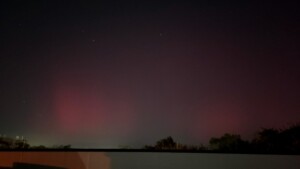 2:10:50 UT 2:10:50 UT |
 2:16:30 UT 2:16:30 UT |
 21:18:53 UT 21:18:53 UT |
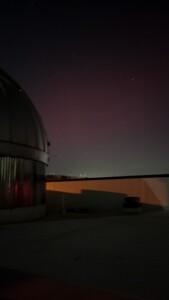 2:27:58 UT 2:27:58 UT |
 2:30:56 UT 2:30:56 UT |
The glow shown in the last image persisted as a faint pink glow for nearly one half hour after the image was taken. Each exposure was a 2 second exposure, at ISO 800, using a Samsung Galaxy S21 phone.
Daily Solar Observations from 10 October
Solar activity remained at high levels. There was an M7.7 flare at 23:12 UT on 9 October from AR 13842. Since then there had been several M-class flares, keeping solar activity in the moderate range. The largest event since yesterday’s M7 was an M3.0, peaking at 22:28 UT from AR 13842, which had just rotated over the west limb. We were observing at the time and was unable to locate an optical signature with this event. There are currently seven active regions visible on the solar disk, six of which are numbered. There was a pair of spots seen in this morning’s sunspot count that were not numbered. The spots are southwest of AR 13848, near N03W65. ARs 13848, 13849, and 13852 each have grown slightly but were relatively quiet. AR 13853 emerged onto the disk and 13854 emerged and grew rapidly.
The left column displays red continuum images, each with exposures of 0.25 seconds; the right column are the H-alpha exposures, with exposures of 0.5 seconds each, and each image covers 13.8’13.8′ on the sky. Celestial north is up, east is left in each image.
Solar activity is expected to be moderate with a chance for isolated X-class flares through 12 October.
October 9,2024
The Sun continues to exhibit high solar activity late yesterday and into today. AR 13848 produced an X1.8 flare at 1:56 UT on 9 October. This event produced a coronal mass ejection (CME) which is Earth Directed and may arrive tomorrow mid- to late day. Then at 15:47 UT, 9 October, AR 13842, on the Sun’s edge, produced an X1.4/1N flare. This was documented almost in its entirety and was a quick event. AR 13848 has become magnetically complex, as has AR 13849, both of them growing in size and complexity. AR 13849 produced an M1.6 flare at 5:46 UT on 9 October. AR 13852 showed growth in its spots and became more complex magnetically.
 |
 |
The image above and left is a SDO animated GIF image of the first X1 flare. The second is a PVSO image of the second X1 flare, taken near X-ray maximum. Click on the first image for the animation.
The left column displays red continuum images, each with exposures of 0.25 seconds and each is 13.8’x18.0′ on the sky. The right column are the H-alpha exposures, with exposures of 0.5 seconds each, and each image covers 13.8’13.8′ on the sky. Celestial north is up, east is left in each image.
Solar activity is expected to be moderate with a chance for isolated X-class flares through 11 October.
October 8,2024
The Sun’s activity had been high due to an X2.1/2B flare at 19:13 UT on 7 October from AR 13842. The X-ray flux remained higher than M5 through 22:28 UTC on 7 October. After the X-ray flux finally dropped below M1.0 at 2:14 UT today, there was only a single M-class flare (M1.5/SF) from AR 13842 at 8:51 UT. This was followed by 3 C-class flares from AR 13844 (C5.4 at 11:53, C5.8 at 17:50, and c4.1 at 19:08 UT). Then AR 13849 produced a C8.0/1N flare at 20:29 UT (just after closing of today’s observing session).
A thick, 35 long filament in the southwestern quadrant of the solar disk (this was observed yesterday intact) started lifting off the Sun around 2:30 UT on 8 October. There was a post eruptive arcade visible in images of the Sun thereafter. A Coronal Mass Ejection from this event was seen beginning at 3:06 UT. It is not yet certain if this is headed toward Earth.
There are a total of five spotted active regions on the Sun, and all of them, except what was mentioned above, were quiet.
The left column displays red continuum images, each with exposures of 0.25 seconds. The right column are the H-alpha exposures, with exposures of 0.5 seconds each. Each image covers 12.7’13.8′ on the sky. The white splotches on some of the images is from the presence of large spot groups in the flat field images. We were not able to avoid these. Celestial north is up, east is left in each image.
Solar activity is expected to be moderate with a chance for isolated X-class flares through 10 October.
October 7,2024
The Sun’s activity returned to moderate levels with four low-level M-class flares, one from near AR 13839, 13842, and 13844. All of these happened yesterday and were each between M1.3 and M1.5. Solar activity returned to low levels today, with only C-class activity. Then AR 13939 produced an M1.3 event at 18:38 UT today. This was followed by an X2.1 from AR 13842, which sent solar activity back to high levels. This event decayed normally at first, but leveled off at M6.9 levels by 19:48 UT before slowly rising back to X1.0 levels by 21:00 UT. This event appears to involve an exploding filament. Due to the decreased probabilities of M- and X-class flares today, solar observations returned to “quiet sun mode” and closed by 18:00 UT, before all the “action” began. AR 13842 is showing some decay but maintained a complex delta magnetic configuration. AR 13844 also has seen decay recently.
Large AR 13848 remains quiet as it crosses the center of the disk. It is slowly growing and seems to be gaining some mixed magnetic polarity in the large penumbra field. AR 13849 was actually two active regions close together. The larger of the two retained the AR 13849 designation and the smaller became AR 13850. These regions were unremarkable. Another fairly large active region is rotating into view, following the AR 13849/13850 pair.
The left column displays red continuum images, each with exposures of 0.25 seconds. The right column are the H-alpha exposures, with exposures of 0.5 seconds each. Each image covers 13.8’13.8′ on the sky. Celestial north is up, east is left in each image.
Solar activity is expected to be moderate with a chance for isolated X-class flares through 9 October.
October 4,2024
The Sun has dropped back to moderate activity levels today. The largest event so far today (through 20:40 UT) was an M4/1N flare from AR 13842. This region and AR 13844 continued to grow some, while AR 13841 has decayed some. Despite this, AR 13841 produced an M1.2/SF at 0:17. There were no significant changes in AR 13848 and 13849. Departing AR 13836 produced an M1.2 flare at 11:03 UT. AR 13848 continues to be quiet, for its size, producing only two optical sub-flares so far.
The left column displays red continuum images, each with exposures of 0.5 seconds. The right column are the H-alpha exposures, with exposures of 0.5 seconds each. Each image covers 13.8’13.8′ on the sky. Celestial north is up, east is left in each image.
Solar activity is expected to be moderate with an increasing chance for X-class flares through 6 October.
October 3,2024
Solar activity continued to be at high activity due to multiple low-level M-class flares from ARs 13841 and 13842. There was an M3.3 flare at 20:51 UT on 2 October from AR 13842 (which was observed onsite). ARs 13841, 13842, 13843, 13844 continue to grow. In addition, AR 13843 and 13844 also produced C- and M-class flares today. AR 13842 produced an X9.0 flare at 12:18 UT today, the largest flare of Solar Cycle 25. It remained relatively quiet for the rest of the day, except for an M6.7/2B at 20:28 UT, which was imaged from start to finish at the PVSO. AR’s 13841 and 13841 were relatively stable yesterday and today.
Two filaments erupted yesterday, an approximately 10 degree long filament which lifted off the surface at 4:49 UT on 3 October. It was located in the northeast quadrant of the solar disk. This event produced a CME that was first observed at 7:48 UT. The second was the filament we’ve been watching all week: an approximately 13 degree long filament in the southwestern quadrant of the Sun lifted off at 9:09 UTC on 3 October. This event produced a CME that was first observed off the SSW limb at 9:48 UT. The X9.0 and M6.7 also produced CMEs which are headed towards Earth.
The left column displays red continuum images, each with exposures of 0.25 seconds. The right column are the H-alpha exposures, with exposures of 0.5 seconds each. The upper right and lower left image each cover 13.8’x13.8′ on the sky. The upper left and lower right image each measure 13.8’x18.0′. Celestial north is up, east is left in each image.
The following are two images of the M6.7 flare. Each image is 13.8’x13.8′ in size.
 This image was recorded near the optical peak (“2B”) of the flare. This image was recorded near the optical peak (“2B”) of the flare. |
 This image was taken near the X-ray maximum (“M6.7”) of the event. This image was taken near the X-ray maximum (“M6.7”) of the event. |
Solar activity is expected to be moderate with a chance for X-class flares through 5 October.
October 2,2024
Solar activity was high with the X7.1/2B flare yesterday at 22:20 UT from AR 13842. This event launched a CME which was first observed by satellite at 23:12 UTC on 1 October. Most of the debris has been launched off the SE limb of the Sun. The CME is expected to arrive on 5 October. There was an M3.6 this morning at 5:38 UT from AR 13842; this also produced a CME that was first observed by satellite at 6:24 UT today.
There were a total of 9 M-class flare events (all but three prior to opening of observations this morning) from various regions: AR 13841, 13842, and 13848. A double M-flare was observed this afternoon: the first peak (M1.4) was at 20:15, and the second (M3.3) was at 20:51. The first came from the space between AR 13842 and 13839, and the second was north of the lead spot of AR 13842.
The left column displays red continuum images, each with exposures of 0.25 seconds. The right column are the H-alpha exposures, with exposures of 0.5 seconds each. Each of the images measure 13.8’x13.8′, except the red continuum at the bottom of the first column, which measures 13.8’x18.0′. Celestial north is up, east is left in each image.
Solar activity is expected to be moderate with a chance for X-class flares through 4 October.
October 1,2024
Solar activity is now high, with an M7.6/2N flare from AR 13842 at 23:59 UT on 30 September. This region, the most complex active region on the visible solar disk, magnetically, has shown moderate growth. ARs 13841, 13843, and 13844 also have grown significantly. A large new sunspot group is rotating into view over the eastern limb.
The Sun was relatively quiet throughout the day but stayed at moderated levels of activity with an M1.0 flare from AR 13839 at 14:52 UT; then there was an M1.5 at 19:17 UT from AR 13839. ARs 13839, 13842, and 13843 contributed all of today’s flare. Then at 22:20 UT, AR 13842 produced an X7.1 flare, the second largest of the current activity cycle. We were able to capture the decay portion of this event. The below image is from the Solar Dynamics Observatory, displayed on spaceweather.com. Click on the image for the animation.
This was an image obtained from the Solar Observatory about 9 minutes after the flare peak.
The left column displays red continuum images, each with exposures of 0.25 seconds. The right column are the H-alpha exposures, with exposures of 0.5 seconds each. Each of the continuum images in the left column covers 13.8’x18.0′ on the sky, and each of the H-alpha images cover 13.8’x13.8′. Celestial north is up, east is left in each image.
Solar activity is expected to be low with M-class flares likely and a slight chance for X-class flares through 3 October.
September 30,2024
The Sun returned to moderate levels of activity with an M1.7/1F flare from AR 13842 at 14:24 UT on 29 September. This region, along with ARs 13843 and 13841 are growing with the remaining regions either stable or in gradual decay. Solar activity remained low from that point on through 2300 UT on 30 September. There was an active filament in the southern central part of the solar disk that showed signs of potentially lifting off the Sun (it did not but another nearby filament did).
The left column displays red continuum images, each with exposures of 0.25 seconds. The right column are the H-alpha exposures, with exposures of 0.5 seconds each. Each image in the top row covers 13.8’x13.8′ in the sky, the bottom left image covers 13.8’x18.0′ on the sky and the bottom right extends 13.8’x15.4′ on the sky. Celestial north is up, east is left in each image.
Solar activity is expected to be low with M-class flares likely and a slight chance for X-class flares through 2 October.
September 27,2024
Solar activity continues to be moderate with an M0.9 flare from AR 13839 at 8:00 UT this morning. This region also produced an M1.4 flare at 23:12 UT on 26 September. With the exception of a sub flare from AR 13835, all of the flaring events (through 14:30 UT at least) have been from AR 13839. AR 13836 is the most complex region on the visible disk and also the largest, at 200 MSH. The remaining active regions showed only minor changes. The Sun continues to favor its southern hemisphere as its main source of activity. There is a loose string of sunspot groups going across the southern part of the Sun, from AR’s 13827 and 13828 currently rotating over the limb; to AR 13839 and possibly another behind it, on the east southeastern limb.
The left column displays red continuum images, each with exposures of 0.25 seconds. The right column are the H-alpha exposures, with exposures of 0.5 seconds each. Each image in the top row covers 13.8’x13.8′ in the sky, the bottom left image covers 13.8’x18.0′ on the sky and the bottom right extends 13.8’x16.3′ on the sky. Celestial north is up, east is left in each image.
Solar activity is expected to be low with M-class flares likely and a slight chance for X-class flares through 28 September.
September 26,2024
Solar activity moved to moderate levels again with an M1.3/1F flare from AR 13828 at 23:12 UT on 25 September. This region has started to rotate toward the western limb. AR 13836 produced a long duration C9.6 flare yesterday at 15:55 UT; this region has shown some slight signs of decay. AR 13833 appears to be in decay phase again, but it is in the process of rotating out of view so it is difficult to see this one clearly. It did produce one sub-flare today. AR 13836, then later, AR 13839 produced all the rest of the observed flare activity (through 22:35 UT, 26 September), to include a C2.9/SF from 13836 and three C-class flares from AR 13839: a C3.8 at 11:31 UT, a C5.0 at 19:49 UT (part of which was observed through clouds) and a C8.1 (the largest event since yesterday’s M1.3) at 20:39 UT. The rest of the spotted regions were unremarkable. There are a total of nine spotted active regions, all small and all (except two) are in the southern solar hemisphere.
The left column displays red continuum images, each with exposures of 0.25 seconds. The right column are the H-alpha exposures, with exposures of 0.5 seconds each. Each image in the top row covers 13.8’x13.8′ in the sky, and each in the bottom row covers 13.8’x18.0′ on the sky. Celestial north is up, east is left in each image.
Solar activity is expected to be low with M-class flares likely and a slight chance for X-class flares through 28 September.
September 25,2024
Solar activity is now back to low levels and remains to this writing (21:15 UT). AR 13836 produced a C9.6/SF at 15:55 UT today (while the observatory was under a deck of clouds). AR 13828 generated a C6.9 at 11:46 UT on 24 September. AR 13835 produced multiple C-class flare events yesterday but was silent today. AR 13836 is the most complex visible active region, magnetically speaking, and is the second largest on the solar disk, 150 MSH; AR 13828 is marginally larger at 160 MSH. The morning sunspot count found AR 13831 has grown markedly since yesterday, adding spots as it prepares to rotate out of view.
The left column displays red continuum images, each with exposures of 0.25 seconds. The right column are the H-alpha exposures, with exposures of 0.5 seconds each. Each image in the top row covers 13.8’x13.8′ in the sky, and each in the bottom row covers 13.8’x18.0′ on the sky. Celestial north is up, east is left in each image.
Solar activity is expected to be low with a chance for M-class flares and a slight chance for X-class flares through 27 September.
September 24,2024
Solar activity reached moderate levels yesterday with an M1.3 flare from AR 13835 yesterday at 14:56 UT. This was the largest event since the M3 late on 22 September. Since yesterday’s M1 flare, there had been no further M-class flares through 23:00 UT on 24 September. So for today, solar activity was low. Slight growth occurred in AR 13835, but all the other regions were stable or in slight decay. Today’s largest region was AR 13828 at 180 MSH, followed by 13827 at 120 MSH. AR 13825 has shrunk to 80 MSH as it rotates out of view. AR’s 13828, 13833, 13835, and 13836 were the source of flares today, with the largest being a C6.9 from AR 13828.
The left column displays red continuum images, each with exposures of 0.5 seconds. The right column are the H-alpha exposures, with exposures of 0.5 seconds each. Each image covers 13.8’x13.8′ in the sky, except for the lower left image in the continuum row, which covers 13.8’x18.0′ on the sky. Imaging was done through cirrus clouds of varying thicknesses. This resulted in decreased contrast, especially for the H-alpha images. Celestial north is up, east is left in each image.
Solar activity is expected to be low with a chance for M-class flares and a slight chance for X-class flares through 26 September.
September 23,2024
After over a week at low levels, solar activity moved into moderate levels with an M3.7/2N flare from AR 13835 yesterday at 21:39 UTC. This region is developing as it rotates onto the solar disk. AR 13836 produced an M1.3 flare this morning at 14:56 UT, just prior to the start of our cloud-riddled observing session. AR 13825 has been mainly quiet, but was the source of a C4.5 X-ray flare event at 10:06 UT today, 23 September. AR 13833 and 13828 also produced a little activity each. AR 13828 is the largest region on the visible disk right now, with an area of 150 millionths of a solar hemisphere (MSH). It’s neighbor, AR 13827, is second largest at 120 MSH. Both of these regions were stable, as were the rest of the eight visible spotted active regions.
The first row of images are from yesterday’s M3.7 flare event. The first is a full disk image from GONG/BBSO and the second is an SDO composite full disk image showing the surge off the southeastern limb. The rest of the images are set up so that the red continuum images, each 0.25 second exposures, are in the left column. The right column contains H-alpha regional images, each 0.5 second exposure. Each of the region images cover 13.8’x13.8′ on the sky and are oriented so that celestial north is up, east is left.
There continues to be a chance for M-class flares through 25 September.
September 20,2024
Solar activity continues at low levels as the Sun has appeared to have entered into a dormant phase. The GOES X-ray flux plot has been essentially flat since about 22:45 UT, 19 September; it remains so (except for a C4 event mentioned below) through 19:25 UT today. The last X-ray solar event of significance was over 6 days ago, and there had been no further X- or M-class flares since 14 September. There are currently seven spotted active regions on the visible disk, with three more being on or just over the western limb. Four of the seven regions have numbers, and all of the numbered regions have shown some signs of minor evolution. Only low-level C-class flares have occurred over the last few days, the most recent being a C3.9 event from an unspecified location.
The left column displays red continuum images, each with exposures of 0.25 seconds. The right column are the H-alpha exposures, with exposures of 0.5 seconds each. Each image covers 13.8’x13.8′ in the sky, except for the lower image in the continuum row, which covers 13.8’x18.0′ on the sky. North is up, east is left in each image.
There is a chance for M-class flares, with a slight chance for X-class flares, from now through 22 September.
September 19,2024
Solar activity remains at low levels, with only occasional low-level C-class activity. AR 13828 showed some growth but was inactive. AR 13825, with its complex (beta-gamma-delta) magnetic configuration, was stable and was the source of a C2.6/SF event at 15:17 UT today. AR 13824 is about to rotate out of view over the limb; this region was the source of a C2.4 flare at 8:04 UT today. AR 13831 emerged overnight and was visible this morning, but remained inactive. The rest of the spotted active regions were unremarkable.
The left column displays red continuum images, each with exposures of 0.25 seconds. The right column are the H-alpha exposures, with exposures of 0.5 seconds each. Each image covers 13.8’x13.8′ in the sky, except for the first image, which is labeled, and which covers 13.8’x18.0′ on the sky. North is up, east is left in each image. The times of each (in UT) are embedded with the image.
There is a chance for M-class flares, with a slight chance for X-class flares, from now through 21 September.
September 18,2024
The Sun remains in a low activity state, with only C-class flares yesterday and today (through 19:50 UT). Solar activity was at low levels. The largest flare was a C4.1 at 3:44 UT on 18 September; this flare came from AR 13828. AR 13825 remains the most complex active region on the visible disk, yet it is rather small and simple compared to some recent active regions. AR 13824 appears to be decaying some. Everything else is quiet and stable.
The left column displays red continuum images, each with exposures of 0.25 seconds. The right column are the H-alpha exposures, with exposures of 0.5 seconds each. North is up, east is left in each image. The times of each (in UT) are embedded with the image, and the image size is given in the caption.
Solar activity is still likely to reach moderate with a slight chance for X-class flares through 19 September. On 20 September, this will drop to likely probability as AR 13824 rotates over the western limb.
Special: Partial Lunar Eclipse, September 17/18,2024
A partial lunar eclipse occurred during the evening of September 17, 2024 (early 18 September 2024, UTC). Some 50 individuals visited the Solar Observatory for the eclipse viewing where four small telescopes were set up for their viewing and imaging. The Solar Dome Scope was configured to observe the Moon by removing the H-alpha filter, but leaving the red Energy Rejection Filter at the main aperture in place, along with the neutral density filter. Both of these served to control the glare from the Full Moon. Each of the below images cover 13.8’x18.0′ on the sky, so since the Moon was 33.8′ across during the eclipse, it was not able to fit in the field of view. So we focused on the region where the shadow would appear to skim the lunar limb. The faint, dusky shade of the Penumbra was visible as early as 1:25 UT (8:25 pm CDT) as an amorphous gray shading. Partial eclipse begain at 2:12 UT (9:12 pm CDT) as the Moon started encountering the inner umbra shadow. Maximum eclipse happened at 2:44 UT (9:44 pm CDT), when 8.5 % of the Moon’s disk was in the shadow. Then the reverse came: partial eclipse ended at 3:15 UT (10:15 pm CDT), with the last penumbra visible around 11:15 pm CDT; the eclipse formally ended at 4:47 UT (11:47 pm CDT) when the Moon exited the outer penumbral shadow.
 |
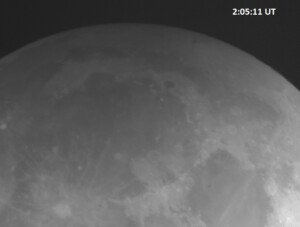 |
 |
 |
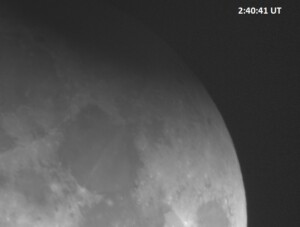 |
 |
 |
 |
 |
The next lunar eclipse will be a total eclipse that will occur over the Spring Break, specifically on March 13/14, 2025.
September 17,2024
Solar activity is currently at low levels. Since the last observing session 13 September, solar activity had reached high levels with an X4.5/2B flare from AR 13825 at 15:28 UT on 14 September from AR 13825. Since that event, there had been no further X- or even M-class flares as AR 13825 had quieted down considerably since then. The largest flare since the X4 was a C9.6 at 23:57 UT on 16 September from AR 13825. There has, more recently, been slight growth in 13825 but the region has been quiet overall. AR 13824 is nearing the western limb and is slowly decaying. The Sun is largely devoid of active regions, especially in the northern hemisphere, with only isolated spots and two relatively complex regions, five visible regions total. No Earth directed CME’s have occurred in the last 24 hours or so.
Each of the images below is a 0.5 second exposure, oriented with celestial north up, west right. The red continuum images are displayed in the left column of the below table; the H-alpha line center images in the right column; angular coverage of each image is indicated in each image caption.
Solar activity is likely to reach moderate with a slight chance for X-class flares today, 17 September. Starting tomorrow and into 19 September, the flare probabilities decrease to a chance of M-class flares as AR’s 13814 and 13822 rotate over the NW solar limb.
September 13,2024
As solar observations resume, the Sun is coming off of a period of high solar activity, with frequent M-class flare activity. Over recent days, the overall spot number has gone down, but a large active region, AR 13825, has rotated into view and released an X1.3 flare at 9:40 UT on 12 September. Following this were multiple M-class flares, the largest of these were an M6.8 at 14:44 UT from AR 13811 as it rotated over the western limb. AR 13814 produced an M2.9 flare at 8:37 UT on 13 September, but the region has started to decay. AR 13822 appears stable and AR 13824 appears to be growing in length while remaining quiet. AR 13825 produced an M1.6 flare at 6:56 UT on the 12th, and was in the early stages of an M1.1 flare during our observation presented below.
In addition to all this, two CME’s were observed: the first emerged from just over the eastern limb at approximately 20:24 UT on 12 September; and the second originated from just over the southwestern limb, being first observable at 1:36 UT on 13 September. None of these appear to be heading toward Earth.
Each of the below images is a 0.5 second exposure taken at the time indicated on the image. The red continuum images are in the first column, and the H-alpha images are in the second. Each of the images cover 13.8’x13.8′ on the sky and is oriented so that celestial north is up and east is left.
Solar activity is expected to remain at moderate to high levels on 13 September as additional M-class flare activity is expected. M-class flare likelihood is anticipated to decrease on 14 to 15 September as multiple active regions rotate out of view. By then, M-class flares become likely.
August 23,2024
Solar activity returned to high levels later today after being at moderate levels due to a series of M-class flares. The boost to high came from an M5.1/1N flare that came from AR 13800 (shown below). AR 13801 also produced an M3.4 at 3:41 UT early today. This region grew slightly. Earlier, AR 13800 produced an M1.0 flare at 4:18 UT today and it also is growing slightly. AR 13790 is the largest spot group on the visible disk but it stayed quiet. AR 13796 grew in spot number. There were eight M-class flares, produced by AR’s 13796, 13800, and 13801 today, with three of them occurring over a 45 minute period, which was observed during the afternoon session this afternoon.
AR 13794 produced a C5.9 flare at 2:03 UT. Starting 21 minutes later, at 2:24 UT, a Coronal Mass Ejection was observed lifting off the west part of the solar disk. This is a slow-moving cloud of material that is expected to graze the Earth’s magnetic field sometime over 27-28 August.
Each of the below images is an H-alpha image (unless otherwise indicated) which covers 13.8’x18.0′ on the Sun (unless otherwise indicated). Each is a 0.5 second exposure and is presented so that celestial north is up, east is left. Solar north is rotated counterclockwise (left) by 18.9 degrees.
Solar activity is expected to remain at moderate levels, with M-class flares likely along with a slight chance for X-class flares, through 25 August.
PROGRAM NOTE: This will be the last entry for a bit as we begin a new semester with all of its obligations, etc.
August 22,2024
Solar activity returned to moderate levels after yesterday’s M5 flare. Since then, there has only been one more M-class flare (up to 21:45 UT today), an M1.5/1N from AR 13796 at 10:39 UT today. The next largest was a C8.3 from the same region at 6:16 UT. AR 13801, as it is rotating into view, produced a C7.8/1N flare event at 15:28 UT. It also produced a C6.1 at 21:30 UT. Lesser C-class flares came from AR’s 13799, 13796, and 13789. ARs 13790 and 13792 are growing slowly, but in spite of their impressive appearances, had little in the way of activity today. The rest of the visible regions were mostly quiet.
Each of the below images is a 0.5 second exposure taken at the time indicated on the image. The red continuum images are in the first column, and the H-alpha images are in the second. Each of the images cover 13.8’x15.2′ on the sky and is oriented so that celestial north is up and east is left.
Solar activity is expected to remain at moderate levels, with M-class flares likely along with a slight chance for X-class flares, through 24 August.
August 21,2024
Solar activity jumped to high levels late in the day with an M5.1/2N flare at 22:01 UT today from AR 13796. Today’s observing session was in the early morning hours so we missed this one. This region produced most of the C-class flares today. Prior to this event, a pair of M1 flares from AR 13785 (at 17:08 UT, yesterday, 20 August,as it departs by rotating over the western solar limb) and AR 13796 (at 6:02 UT today, 21 August) occurred. These kept solar activity moderate prior to the late afternoon M5 flare event. AR’s 13784 and 13790 also produced a few3 C-class flares. AR’s 13785, 13790, 13794, and 13796 have grown some while the rest were either stable or in decay.
The first image is a red continuum image showing the largest visible active regions (labelled) currently visible on the Sun; the second is H-alpha of the same zone on the Sun. Each image is a 0.5 second exposure at the UT indicated, covers the area indicated in the captions, and is oriented so that celestial north is up, east is left.
Solar activity is expected to remain at moderate levels, with M-class flares likely along with a slight chance for X-class flares, through 23 August.
August 20,2024
Solar activity remains at moderate levels thanks to ongoing, occasional low-level M-class flares. AR 13796 grew slightly and produced an M3.7 flare at 21:48 UT on 19 August. AR 13790 produced a C9.8/SF event at 20:16 UT on 19 August and it also showed some growth. Several other regions were the source of low-level C-class flares, which occurred regularly throughout the day. Most of the visible spot groups showed at least slight growth.
Each of the below images is a 0.5 second exposure taken at the time indicated on the image. The red continuum images are in the first column, and the H-alpha images are in the second. Each of the images cover 13.8’x18.0′ on the sky except for the last one (H-alpha image on the second row), which covers 13.8’x14.6′. Each are oriented so that celestial north is up and east is left.
M class flares are likely with a slight chance for X-class flares through 22 August.
August 19,2024
Solar activity was at moderate levels with AR 13796 being the source of two M-class flares, one at 21:07 UT on 18 August, and another at 00:00 UT on 19 August. There was also an M1.3 at 9:36 UT from AR 13785, and a C9.8 at 20:16 UT today from AR 13790. AR’s 13793, 13796, and 13797 are growing in spot number and size. The remaining regions, including departing AR 13784, were stable or in decay.
Each of the below images is a 0.5 second exposure taken at the time indicated on the image. The red continuum images are in the first column, and the H-alpha images are in the second. The images in the first row each cover 13.8’x18.0′ and those in the second row each cover 13.8’x14.5′ on the sky, and each have celestial north up, east left.
M class flares are likely with a slight chance for X-class flares through 21 August.
August 16,2024
Solar activity is mainly at low levels, with occasional isolated M-class flares briefly boosting it to moderate levels. Since the M1.1 flare early yesterday (3:48 UT, 15 August), there has only been C-class flare activity. This continued until an M1.3 flare came from departing AR 13780 at 13:24 UT today. Since then, through at least 21:30 UT today, the Sun returned to low activity levels with only C-class activity. Some growth occurred in ARs 13785, 13789, and 13790. AR 13780 appears to have decayed a bit but is currently rotating out of view; AR 13784 seems to have shrunk a bit, but as of 0:30 UT today, each of these continued to have a “beta-gamma-delta” magnetic configuration, meaning they continue to have complicated magnetic fields associated with them. The rest of the regions were either stable or in decay.
Each of the below images is a 0.5 second exposure taken at the time indicated on the image. The red continuum images are in the first column, and the H-alpha images are in the second. Each image covers 13.8’x13.8′ on the sky, unless otherwise indicated, and have celestial north up, east left.
Solar activity is expected to be low to moderate, with M-class flares likely and a slight chance of X-class flares through 18 August.
August 15,2024
AR 13784 produced an X1.1 flare at 6:40 UT on 14 August, the largest in the last seven days. There were also six M-class flares over the last two days. The most recent three came from AR’s 13784 (two of them) and 13780 (the remaining one). AR 13784 produced an M1.1/SF at 13:24 UT on 14 August. This was quickly followed by an M5.2/SF 2 hours 25 minutes later, at 15:49 UT on 14 August. Then AR 13780, as it begins to rotate out of view today, produced an M1.1/SF at 3:48 UT 15 August. This was the last M-class flare produced (up to 22:45 UT today) as since this event, only C-class activity was noted. AR 13786 is growing but stayed inactive; the remaining spot groups (including the unnumbered one that just rotated into view over the ESE limb) were mainly stable and quiet.
The image on the left is a red continuum image taken at the time indicated. It covers 13.8’x18.0′ on the sun and is a 0.25 second exposure. The image on the right is an H-alpha image of the same zone on the Sun. It also covers 13.8’x18.0′ and is a 0.5 second exposure. Celestial north is up, east left in each image.
 |
 |
Solar activity is expected to remain at moderate levels, with M-class flares expected and a chance for X-class flares through 17 August. This elevated activity level is due to ARs 13780 and 13784 maintaining their complicated magnetic field configurations.
August 13,2024
Solar activity remained at moderate levels, but overall seems to be decreasing. There was an M1.2 flare from AR 13784 yesterday at 22:57 UT after over 16 hours without M-flares. AR 13784 produced another M1.0 flare at 17:29 UT (while we were observing an optical sub-flare from AR 13780 at the same time). AR 13784 is growing in spot number and magnetic complexity. It also was the source of a few C-class flares. AR 13780 continues to be the largest region on the visible disk, growing in spot number. However, it remained mostly inactive, only producing C-class and optical subflares. AR 13785 and 13788 grew slightly but were mostly inactive. All the other spotted regions were quiet and stable.
A filament observed during yesterday’s session erupted today approximately at 8:00 UT. It was an 8 degree long feature located in the southwestern part of the solar disk. It launched a CME that is likely to miss the Earth, passing too far south (but further analysis is pending at SWPC).
Each of the below images is a 0.5 second exposure taken at the time indicated on the image. The red continuum images are in the first column, and the H-alpha images are in the second. Each image covers 13.8’x13.8′ on the sky and have celestial north up, east left.
Solar activity is expected to remain at moderate levels, with M-class flares expected and a chance for X-class flares through 15 August.
August 12,2024
Solar activity stayed at moderate levels with three M-class flares since midday yesterday. AR 13780 produced an M1.3 flare yesterday at 23:58 UTC. This region has begun to decay. AR 13777 produced an M1.7 flare at 20:18 UT yesterday and an M1.0 flare at 8:48 UT today. This was the last M-flare today, only C-class activity continued since then, through 22:35 UT. AR 13784 has shown some growth and has been the source of two C-class flares and several optical subflares. All the other regions remained stable today. ARs 13774, 13777, 13783, and 13786 all had at least some minor flaring events.
Each of the below images is a 0.5 second exposure taken at the time indicated on the image. The red continuum images are in the first column, and the H-alpha images are in the second. Each image covers 13.8’x13.8′ on the sky and have celestial north up, east left.
Solar activity is expected to be moderate to high, with M-class flares expected and a chance for X-class flares through 14 August due to the flaring potential of AR 13780 and 13784.
August 9,2024
Solar activity remains high with five M-class flares and an X1 flare since yesterday mid-day. All the M-class flares were below M5 level and came from AR 13777 (3 events), 13780 (2 events) and 13781 (1 event). The most recent was an M4.5 from AR 13777 at 21:23 UT today. Yesterday’s X1.3 came from the leader spot of AR 13777; since this event, the region’s spots started to break up and the region as a whole started to decay. A faint CME came from an M1.3 event from AR 13777 at 4:41 UT on 8 August. The X1.3 also produced a CME which could arrive around 12 August. The image below shows the extreme ultraviolet sequence of yesterday’s X1 flare as imaged by Solar Dynamics Observatory. Click the image for the animation.
AR 13780 has grown again to 1250 MSH, up from yesterday’s 1110 MSH. Of the nine spotted active regions (8 are numbered), six are magnetically complex (four with delta spot/magnetic configurations), and these are each larger than 160 MSH (two are as large as 400 MSH). All of this continues to be carried across the solar disk by the Sun’s rotation.
Each of the below images is a 0.5 second exposure taken at the time indicated on the image. The red continuum images are in the first column, and the H-alpha images are in the second. Each image covers 13.8’x18.0′ on the sky and have celestial north up, east left.
Solar activity is expected to be moderate to high, with continuing M-class flares and a chance for X-class flares through 10 August due to half the visible active regions maintaining complex magnetic fields.
August 8,2024
Solar activity reached high levels with 10 M-class flares since yesterday morning, and an X-class flare this afternoon, the first since the pair on the morning (local time) of August 5). AR 13777 produced an M5.0/2B flare yesterday at 18:54 UT. It also produced an X1.3/2B flare this afternoon at 19:35 UT, right as we were acquiring the region as the H-alpha filter had just come online. There were several coronal mass ejections (CME’s observed yesterday and today, four in total (plus another possibly related with the recent X1 flare). At least two of these are heading toward Earth and one will miss; analysis is pending on the other(s).
AR 13780 had shrunk a bit to 1110 MSH from yesterday’s 1220 MSH. It only produced a few C-class flares today. It just produced an M1.2 flare at 22:51 UT. Of the nine numbered active regions on the visible disk currently, six are magnetically complex and capable of at least M-class flare activity. Aside from the aforementioned M-class and X-class events, ARs 13777 and 13781 produced M-class flares today- three from the former and two from the latter.
Each of the below images is a 0.5 second exposure taken at the time indicated on the image. The red continuum images are in the first column, and the H-alpha images are in the second. Each image covers 13.8’x13.8′ on the sky unless indicated otherwise.
Solar activity is expected to be moderate to high, with continuing M-class flares and a chance for X-class flares through 10 August due to the large number of magnetically complex regions on the visible solar disk.
August 7,2024
Solar observations resumed today as the Sun is in an extended period of elevated solar activity. It is interesting to note that earlier this year there were large numbers of sunspot groups, each with only a few spots, usually with one or two notable exceptions. Now we are seeing more and larger active regions on the solar disk. Over the past seven days, there were a total of 45 M-class flares plus two X-class flares, which occurred less than two hours apart from opposite sides of the solar disk on 5 August. The frequency of M-flares seems to have subsided but they are expected to continue as there are several large sunspot groups capable of producing M-class flares on the solar disk.
The current solar cycle has surged in activity level in recent weeks, with the sunspot number reaching levels comparable to Solar Cycle 23. It was originally predicted that this cycle would be like Cycle 24, which was more of a low-key cycle. Observations began at PVSO in 1999, and the plot below shows the Sun’s activity cycle in terms of sunspot number since the start of solar observations at PVSO to the present time. The jagged black curve are actual sunspot numbers, averaged for each month. The blue curve is the smoothed monthly values; the red curve is the predicted sunspot number for the rest of Solar Cycle 25, and the gray zone is the range of predicted values for this current cycle.

(image courtesy of NOAA Space Weather Prediction Center)
Currently the sun is operating at moderate activity levels with four M-class flares today (through 23:00 UT on 7 August) and one M-class flare early yesterday. AR 13774 produced an M1.8/1N flare today at 2:30 UT. This region is slowly growing and has developed a small magnetic delta configuration, increasing the probability of its flaring some more. AR 13781 produced an M1.1/1N shortly after this, at 4:57 UT today. This region also developed a delta magnetic field configuration and is growing. Neither of these flares generated CME’s. AR 13777 is magnetically complex and has grown significantly since 18:00 UT yesterday, with spot area and number increasing and a delta configuration in its trailer spots. This region was the source of an M5.0 at 18:54 UT today (about 50 minutes after the close of today’s observing session…). The fourth M-class flare, an M4.5/SF at 13:50 UT today, which came from AR 13774.
AR 13780 has grown to 1220 millionths of a solar hemisphere. This is bringing it closer to the “top 25” list of the largest solar active regions, by areal coverage, since 1996 (for the full list, go to https://www.spaceweatherlive.com/en/solar-activity/top-25-sunspot-regions.html). The number one region in terms of size is AR 12192, which, on 27 October 2014, reached a maximum size of 2750 MSH. We observed this spot (images below) during the 23 October 2014 partial solar eclipse, when it was large, but not quite this large.
Each of the below images cover 13.8’x13.8′ on the sky, with celestial north is up, west is right. The red continuum images below are in the first column and are each 0.5 second exposures; the H-alpha images in the right column, and above, are each 0.5 second exposures.
Solar activity is expected to be moderate to high, with M-class flares continuing and a chance for X-class flares through 9 August. This is due to the high number of sunspot groups capable of producing large flares on the visible solar disk.
__________________________________________________________________________________________
July 20,2024
Solar activity continued to be moderate today. AR 13751 continues to be the most complex region on the solar disk and increased in spot number, especially in the trailing parts of the group. AR 13744 produced an M1.5 flare (image just below near flare peak) as it approached the western limb of the Sun. This region began to grow some. AR 13761 is also growing in area and in spot number. Another new region, AR 13762, has rotated onto the visible solar disk. Another solar filament disappeared before today’s observing session: this event began around 15:00 UT today. The remaining spotted regions showed only minor changes. In all, there were a total of 13 spotted active regions and three spotless regions. Three more spotless regions are very close or on the western limb.
 After about 17:00 UT today, AR 13744 was responsible for most of the flares, and through the rest of the day. The M1.2 is shown near peak intensity (bright spots). AR 13759 is seen on the bottom edge of the image frame.
After about 17:00 UT today, AR 13744 was responsible for most of the flares, and through the rest of the day. The M1.2 is shown near peak intensity (bright spots). AR 13759 is seen on the bottom edge of the image frame.
The above and each of the below images cover 13.8’x13.8′ on the sky, with celestial north is up, west is right. The red continuum images below are in the first column and are each 0.25 second exposures; the H-alpha images in the right column, and above, are each 0.5 second exposures.
Solar activity is likely to be moderate, with a slight chance of X-class flares through 23 July.
PROGRAM NOTE: This will be the last entry in the solar observation log until 12 August, possibly a few days earlier due to an anticipated prolonged wet weather event and other circumstances.
July 19,2024
Solar activity remained at moderate levels with AR 13753 producing an M3.2 flare at 8:23 UT today, 19 July. AR 13751 produced an M2.0/1N flare at 18:06 UT (before we were able to open due to lingering cloudiness). This region is the largest and most complex (magnetically speaking) spot group. There are 18 numbered active regions on the visible solar disk and 15 of them were unchanged or slowly declining. ARs 13744, 13759, and 13761 showed some gradual growth today.
Beginning at about 18:29 UT today, a filament in the southeast quadrant of the solar disk, south of the AR 13751/13761 complex began to disappear. We observed this filament from the start of the H-alpha sequence and noticed it was unusually active so it was monitored. Unfortunately a slow moving cloud blocked the view for 15 minutes or so, but it disappeared during that time (images below depict the change and disappearance). The filament actually lifted off and produced a weak CME that will miss the Earth.
Each of the images below were recorded at the indicated times and these show the dramatic changes in the appearance of the filament. Each of the six images cover the indicated area on the solar disk and is oriented so that celestial north is up, west is right. Solar north is rotated 5.8 degrees counterclockwise (left).
Each image below is a 0.5 second exposure and is presented with celestial north up, west right. The red continuum images are presented in the left column and the H-alpha images are in the right column. Each image in the table covers 13.8’x15.9′, except the last (with the filament), which covers 13.8’x16.6′ of the sky. Celestial north is up, west is right.
Solar activity is likely to be moderate, with a slight chance of X-class flares through 22 July.
July 18,2024
The Sun’s activity returned to moderate levels as AR 13753 produced an M1.2 flare at 19:51 UT on 17 July, followed by an M2.0 flare at 19:58 UT yesterday. AR 13751 generated an M2.2 flare at 10:14 UT on 18 July, followed by an M2.0 flare just 13 minutes later. AR 13751 also produced a number of C-class flares as it grows and becomes more complicated magnetically. AR 13760 rapidly emerged just north of the solar disk center. There are a total of 18 spotted active regions and one spotless plage area on the visible solar disk. Most of these were little changed and mostly quiet.
There was a large prominence that erupted off the southeast limb of the Sun. This event produced a Coronal Mass Ejection that became visible by satellite by 19:00 UT on 17 July. A solar filament disappeared in the northwest quadrant of the Sun at approximately 4:26 UT on 18 July. This event did not produce a CME, indicating that the filament was reabsorbed.
Each image below is a 0.5 second exposure and is presented with celestial north up, west right. The red continuum images are presented in the left column and the H-alpha images are in the right column. Each image in the first column covers 13.8’x13.8′ and each in the second column cover 18.0’x13.8′. Celestial north is up, west is right.
Solar activity is likely to be moderate, with a slight chance of X-class flares through 20 July.
July 17,2024
Solar activity returned to moderate levels. AR 13743 produced an M5.0/2B flare at 6:39 UT on 17 July, This was followed quickly by an M3.4 flare at 7:08 UTC. Then AR 13738 produced an M1.2/SF at 9:45 UT today. Since then the X-ray background decreased steadily, returning the Sun to low activity for several hours. Then at 19:51 UT, AR 13743 produced an M1.2 flare, followed quickly by an M2.0 flare at 19:58 UT. C-class flares came from ARs 13751 and 13753, with optical subflares came from AR 13744. There are a total of 15 active regions on the visible solar disk, but most of these are inactive and stable.
Each image below is presented with celestial north up, west right. The red continuum images are presented in the left column and the H-alpha images are in the right column. Each image in the top row covers 13.8’x13.8′ and each in the bottom row cover 18.0’x13.8′. Celestial north is up, west is right, with the solar north pole rotated 4.9 degrees counter clockwise (left) in the images. Each image is a 0.25 second exposure except where indicated otherwise.
Solar activity is expected to be moderate, with a chance for X-class flares on 17 July. The moderate activity is expected to continue on the 18th and 19th of July, with only a slight chance of X-class flares as AR 13738 rotates further behind the west limb.
July 16,2024
Solar activity reached high levels this morning with an X1.9/1B flare from departing AR 13738. AR 13744 produced an M1.3 flare at 3:01 UT today; AR 13753 was the source of an M3.6 flare today at 7:37 UT, which was the second largest today. After the X1 flare, the Sun had become remarkably quiet (through 21:12 UT). AR 13743 and 13751 have grown in spot number and magnetic complexity since yesterday. AR 13755 and 13756 rotated into view, but these, along with the rest of the 15 visible active regions, were unremarkable.
 This is an animated GIF (click on the image for the animation) from Solar Dynamics Observatory showing the X1 flare in the extreme ultraviolet.
This is an animated GIF (click on the image for the animation) from Solar Dynamics Observatory showing the X1 flare in the extreme ultraviolet.
Later this day, AR 13753 produced an M1.6 flare at 21:24. This was promptly followed by an M1.0 pre-flare from AR 13744, which itself was followed by the main event, an M1.9 flare, which peaked at 22:06 UT.
Each image below is presented with celestial north up, west right. The red continuum images, each 0.5 second exposures and each covering 18.0’x13.8′ on the Sun (unless indicated otherwise), are presented in the left column and the H-alpha images, each 0.5 second exposures and covering 18.0’x13.8′ on the Sun (unless indicated otherwise), are in the right column. Celestial north is up, west is right, with the solar north pole rotated 4.5 degrees counterclockwise (left) in the images.
Solar activity is likely to be moderate moderate, with a slight chance for X-flares through 18 July 2024.
July 15,2024
Another five days have passed before the next observation session was possible due to various factors. Over the weekend, specifically on 14 July at 2:34 UT, AR 13738 produced an X1.2 flare, the strongest in recent days. It has been a little while since there was an X-flare. This region also produced numerous M-flares over the last five days, including an M5.0 at 23:01 UT, 13 July; and, more recently, an M2.7 at 9:37UT. We observed several hours today (15:06 to 18:31 UT) and the region stayed quiet the entire time. It had not produced another M-flare since this morning’s event, through 22:25 UT (15 July). AR 13738 continued to be the largest and most complex region on the visible disk.
AR 13752 rotated onto the disk over the ENE limb. AR 13753 emerged west of the solar disk meridian. ARs 13743 and 13744 each grew a bit. The remaining visible active regions on the solar disk are mostly stable or gradually decaying.
Each image below is presented with celestial north up, west right. The red continuum images, each 0.25 second exposures and each covering 13.8’x13.8′ on the Sun, are presented in the left column and the H-alpha images, each 0.5 second exposures and covering 13.8’x13.8′ on the Sun, are in the right column. Celestial north is up, west is right, with the solar north pole rotated 4.0 degrees counterclockwise (left) in the images.
Solar activity is likely to reach moderate levels, with a chance for X-flares through 17 July 2024.
July 10,2024
After one week break from observations due to the long holiday weekend and the passage of Hurricane Beryl through the area on Monday 8 July. Solar activity reached, and continues to be at, moderate levels. AR 13738 rotated into view on 5 July and has grown and become magnetically complex, raising its capability of producing M-class flares. This region produced an M1.5 flare today at 5:59 UT and an M1.3 flare today at 9:45 UT. These were followed by an M1.4 flare at 12:04, and M1.1 flare at 13:04, and an M1.0 flare at 15:37. Since then, through at least 21:15 UT, the region has only produced C-class flares, including three observed during today’s session.
There are a total of 12 spot groups on the visible disk of the Sun today, eight of which are numbered. With the exception of 13738, all of these were relatively stable and quiet. AR 13738 has a surface area of 320 MSH (millionths of a solar hemisphere), and all the other regions have much smaller areas of coverage.
Each image below is presented with celestial north up, west right, with the solar north pole rotated 1.8 degrees counter-clockwise (left) in the images.. The red continuum image, 0.25 sec exposure, is presented 0n the left; the H-alpha image, 0.5 sec exposure, is on the right.
Solar activity is expected to be at low levels, with a chance for M-class flares, through 12 July.
July 3,2024
Solar activity reached moderate levels again with an isolated M1.5 flare from AR 13730 at 7:41 UT today, 3 July. AR 13730 has decayed some, but AR 13729 has grown some, along with 13733. AR 13729 remains the largest and most complex active region on the visible solar disk. All the the other 11 spotted regions are unremarkable, and AR 13723 (the third rotation apparition of AR 13664) has decayed to spotless plage.
Each image below is presented with celestial north up, west right. The red continuum images are presented in the left column and the H-alpha images are in the right column. Each image covers 13.8’x13.8′ and is a 0.5 second exposure. Celestial north is up, west is right, with the solar north pole rotated 1.3 degrees clockwise (right) in the images.
Solar activity is expected to be low, with a chance for M-class flares, through 5 July.
July 1, 2024
Solar activity was bumped up to moderate levels by an M2.1 flare at 11:02 UT today from AR 13730. This was and continues to be the largest flare of the day (as of 20:37 UT). Only minor/low-level C-class events and optical subflares have happened today. ARs 12729 and 13730 were responsible for all the flare events so far today. AR 13729 is the most complex AR on the visible solar disk. AR 13730 and 13732 had both showed growth among their spots. The remaining (many) numbered active regions were either stable or gradually decaying. There are a couple of large filaments in the northeast sector.
Each image below is presented with celestial north up, west right. The red continuum images, each 0.5 second exposures, are presented in the left column and the H-alpha images, each 0.5 second exposures, are in the right column. The top row of images cover 13.8’x13.8′ on the Sun, and the second row of images cover 18.0’x13.8′ on the Sun. Celestial north is up, west is right, with the solar north pole rotated 2.2 degrees clockwise (right) in the images.
Solar activity is expected to be low, with a chance for M-class flares, through 3 July.
June 29, 2024
Solar activity continues at low levels. There were only low level C-class X-ray activity yesterday and today. The largest events were a pair of C5 flares from AR 13734: a C5.6 at 15:29 UT today and a C5.9 just nine minutes later. Only minor changes were observed among 12 of the 14 numbered active regions currently visible on the near side of the Sun. Two of these just rotated into view over the last 24 hours.
Each image below is presented with celestial north up, west right. The red continuum images, each 0.25 second exposures and each covering 18.0’x13.8′ (except for the first, which covers 13.8’x13.8′) on the Sun, are presented in the left column and the H-alpha images, each 0.5 second exposures and covering 13.8’x13.8′ (except for the last image, which covers 18.0’x13.8′) on the Sun, are in the right column. Celestial north is up, west is right, with the solar north pole rotated 2.7 degrees clockwise (right) in the images.
Solar activity is expected to be low, with a chance for M-class flares, through 1 July.
June 28, 2024
The Sun continues to be quiet as activity remains low. The largest flare was a C6.6/SF at 23:47 UT on 27 June from AR 13730. Apparently the leading end of AR 13723 began to display characteristics that point to it being a distinct and separate active region, so it was numbered as such. This flare was the largest since a C6.2 happened at 15:25 UT on 26 June, and all the subsequent C-class flares were less intense. ARs 13723, 13737, 13728, and 13729 were the only regions to produce flares (so far, as of 17:30 UT) today and all of these were C-class or optical subs. The largest of these was a C3.9 at 2:08 UT from an undisclosed location. AR 13728 has grown slightly, as has 13729. All the other regions were quiet and unremarkable.
Each image below is presented with celestial north up, west right. The red continuum images, each 0.5 second exposures and each covering 13.8’x13.8′ on the Sun, are presented in the left column and the H-alpha images, each 0.5 second exposures and covering 13.8’x13.8′ (first image) and 15.8’x13.8′ (second image) on the Sun, are in the right column. Celestial north is up, west is right, with the solar north pole rotated 3.6 degrees clockwise (right) in the images.
Solar activity is expected to be low, with a chance for M-class flares, through 30 June.
June 27, 2024
Solar activity remained low after yesterday’s M1 flare early in the day. Today, there was only C-class activity from AR’s 13723, 13727, 13729, plus a single small C2.0 flare at 17:15 UT from AR 13719. The largest of today’s flares (so far, as of 23:00 UT) was a C4.8 from AR 13729. Despite its magnetic complexity and the forecast for “likely M-class flares”, AR 13723 has been very quiet. ARs 13723 and 13720 have experienced some decay, while AR 13729 has experienced some growth. AR 13729 also produced a C4.0 flare at 21:53 UT. All the other regions were quiet and stable.
Each image below is presented with celestial north up, west right. The red continuum images, each 0.5 second exposures and each covering 18.0’x13.8′ on the Sun, are presented in the left column and the H-alpha images, each 0.5 second exposures and covering 13.8’x13.8′ on the Sun, are in the right column. Celestial north is up, west is right, with the solar north pole rotated 4.1 degrees clockwise (right) in the images.
M-class flares are likely through 29 June due to the flaring potentials of ARs 13723 and 13729.
June 26, 2024
Solar activity was moderate due to an M1.0/SF that came from AR 13723 at 12:45 UT, 25 June. Since then, solar activity was low with the X-ray background trending lower over the course of the last three days. There were only a few C-flares and optical subflares from ARs 13723 and 13724, the largest of which was a c6.2/SF today at 15:30 UT (prior to the start of our observing session). AR 13723 has decayed slightly as has AR 13720. AR 13727 has grown in spot count. The large filament that we had been following lifted off the surface at 23:10 UT on 24 June and produced a CME which will graze Earth’s magnetic field on 28 June. Aside from the regions mentioned, the other six numbered active regions are stable and quiet.
Each image below is presented with celestial north up, west right. The red continuum images, each 0.25 second exposures and each covering 18.0’x13.8′ on the Sun, are presented in the left column and the H-alpha images, each 0.5 second exposures and covering 13.8’x13.8′ on the Sun, are in the right column. Celestial north is up, west is right, with the solar north pole rotated 4.5 degrees clockwise (right) in the images.
M-class flares are likely through 28 June due to the flaring potentials of ARs 13720 and 13723.
June 25, 2024
The Sun has been at moderate activity level with occasional M1 flares erupting. AR 13713 produced an M1.1 flare from just over the western limb. AR 13723 remains the most magnetically complex active region on the visible solar disk but has changed little over the last day-and-a-half. It was the source of an M1.0/SF that peaked at 12:45 UT this morning. It had been mainly quiet otherwise, with the most recent event being a C5.6 flare at 19:25 UT today. A 35 degree long filament lifted off the southeast disk of the Sun about 23:10 UT on 24 June. This may have generated a CME which emerged off the western edge of the Sun. All the other active regions on the Sun were mostly stable and unremarkable.
The large solar filament we had been following over the last week or so has disappeared, between about 0:24 and 13:21 UT today. It was not seen during this morning’s observing session.
Each image below covers 13.8’x13.8′ on the sky, with celestial north up, west right. The red continuum images are presented in the left column and the H-alpha images are in the right column. Each image is a 0.5 second exposure. Celestial north is up, west is right, with the solar north pole rotated 5.0 degrees clockwise (right) in the images.
M-class flares are likely through 27 June.
June 24, 2024
Solar activity became high with an M9.3/1N flare from AR 13723 at 13:01 UT on 23 June. Prior to this, there was a pair of M2 flares, one at 6:30 UT on 223 June and one at 8:55 UT on 22 June. Several eruptions came from A 13713 (now on the western limb) and this raised the X-ray background to M-levels for almost four hours after the initial eruption. There was slight growth in AR 13720, and 13723 is likely old AR 13664 starting a third rotation across the visible solar disk. The remaining regions were either stable or in decay. Two filaments erupted early today within 32 minutes of each other. One started at 1:15 UT on 24 June, and the next started at 1:47 UT on 24 June. The former was in the southern hemisphere just past the disk central meridian; the latter happened in the northwest quadrant of the disk. Aside from the eruptions this morning and an M1.1 at 19:10 UT from AR 13912, solar activity had returned to low levels.
Each image below covers the area indicated with each, with celestial north up, west right. The red continuum images, each 0.25 second exposures, are presented in the left column and the H-alpha images, each 0.5 second exposures, are in the right column. Celestial north is up, west is right, with the solar north pole rotated 5.4 degrees clockwise (right) in the images. The second image below is a close up of the west limb and is rotated so that celestial west is up, north is right.
M-class flares are likely through 25 June; this drops to a chance for M-class flares on 26 June. There is a slight chance for an isolated X-class flare through 25 June as ARs 13712, 13713, and 13716 continue to rotate further out of view.
June 21, 2024
The Sun’s activity became high late yesterday as AR 13719 produced an impulsive M5.7/1B which peaked at 23:16 UT on 20 June. This region showed minor growth but remained small compared to the three regions (13712, 13713, and 13716) that are rotating toward the western limb of the Sun. AR 13713 produced most of the C-class flare activity yesterday and continued to do so today as it grew in size and spot number. It continues to maintain a complex magnetic field configuration and was observed to produced another C-class flare during today’s session: a C4.6 at 15:57 UT today. ARs 13712 and 13716 are mostly unchanged and produced a few C-class flares both today and yesterday. AR 13718, the single spot near the center of the solar disk yesterday, disappeared by this morning, having decayed to plage late yesterday. Two new active regions are rotating into view, a single spot near N25 E 80 and a pair of spots near S12 E 85. There are a total of seven spot groups on the visible solar disk today, five of which are numbered.
Each image below covers 13.8’x13.8′ on the sky, with celestial north up, west right. The red continuum images, each 0.25 second exposures, are presented in the left column and the H-alpha images, each 0.5 second exposures, are in the right column. Celestial north is up, west is right, with the solar north pole rotated 9.9 degrees clockwise (right) in the images.
Solar activity is expected to be moderate, with M-class flares likely and a chance for X-class flares, through 23 June.
June 20, 2024
Solar activity has been low overall, with the exception of an isolated M1.1/SB flare that occurred from AR 13719 at 15:18 UT (we were not able to observe this because of abundant cloud cover at the time). This region contributed a C7.1/SF at 9:39 UT and two additional sub-flares today. In addition, it just produced a C6.5 flare which peaked at 19:38 UT. AR’s 13712, 13713, and 13716 continue to grow and become magnetically complex as they begin to approach the western limb of the Sun. AR 13712 was quiet and had not yet flared today or yesterday, except for optical SF’s at 13:44 and 16:44UT; AR 13713 has produced some C-class activity, including a C5 at 12:23 UT, and several optical subflares; and AR 13716 produced C-flares yesterday and today. While these three regions get closer to the western edge of the Sun (carried along by solar rotation), regions 13719 and 13720 are rotating into view.
Each image below covers 13.8’x13.8′ on the sky, with celestial north up, west right. The red continuum images are presented in the left column and the H-alpha images are in the right column. Each image is a 0.5 second exposure. Celestial north is up, west is right, with the solar north pole rotated 7.2 degrees clockwise (right) in the images.
M-class flares are likely with a chance for isolated X-class flares through 22 June. This is due primarily to AR’s 13712, 13713, and 13716.
June 14, 2024
The Sun’s activity reached moderate levels as AR 13713 produced an M3.2/1N flare at 16:45 UT on 13 June. Then AR 13712 produced an M2.4/SF at 4:32 UT on 14 June. Since then, only C-class and optical subflares (through at least 23:35 UT) occurred, with AR 13712 producing most of this activity today. AR 13712 has grown significantly over the last day or two, becoming more magnetically complex. Its neighbor on the Sun, AR 13713 also showed some growth as it added spots. AR 13709 and 13714 produced C-class flares yesterday but not so much today. AR 13711 and 13716 grew slightly over the last day or so. A filament, approximately 23 degrees long, erupted from the visible disk this morning between 8:49 and 9:40 UT from the southwest quadrant of the solar disk.
Each image below covers 13.8’x13.8′ on the sky, with celestial north up, west right. The red continuum images, each 0.25 second exposures, are presented in the left column and the H-alpha images, each 0.5 second exposures, are in the right column. Celestial north is up, west is right, with the solar north pole rotated 9.9 degrees clockwise (right) in the images.
Solar activity is expected to be low, with a chance for isolated M-class flares, through 16 June.
June 12, 2024
The Sun returned to low activity levels with only minor C-class flare activity all day yesterday and today through 17:31 UTC. AR 13709 showed some redevelopment but nothing too major. It produced a C2.3 flare today at 5:53 UT and a C3.3 at 15:24 UT today. AR’s 13712 and 13713 rotated into view, with AR 13712 producing a C2.7 flare at 7:28 UT today and AR 13713 producing a C4.4 flare at 13:17 UT today. The rest of the spotted active regions were stable and quiet today. AR 13697 continues to be active on the solar far side. A Halo CME was observed by satellite starting at 23:06 UT 11 June. This is headed toward Mercury, on the far side of the Sun
Each image below covers 18.0’x13.8′ on the sky, with celestial north up, west right. The red continuum image, a 0.25 second exposure, is displayed in the left column and the H-alpha image, a 0.5 second exposure, is displayed in the right column. Celestial north is up, west is right, with the solar north pole rotated 10.8 degrees clockwise (right) in the images.
Solar activity is expected to continue at low levels, with a lessening chance for isolated M-class flares through 14 June.
June 11, 2024
Solar activity reached moderate levels after an M9.5 flare occurred at 18:40 UT yesterday from AR 13697 from behind the solar limb. GONG H-alpha imagery showed the top of the evolving flare structure throughout the event. AR 13709 is growing slightly and is now the largest region on the visible disk. It has produced little in the way of flare activity. The rest of the active regions were unchanged or in decay. Since the M9 flare, there were only C-class flares on a declining X-ray background. The largest were a pair of C9 events from AR 13697 at 3:51 UT and 4:59 UT, 11 June. One of the filaments observed in the northeast quadrant of the Sun yesterday morning may have lifted off the Sun yesterday afternoon around 21:45 UT. This resulted in a CME that was first observed by SOHO at 23:12 UT but the event will miss Earth.
Each image below covers 13.8’x13.8′ on the sky, with celestial north up, west right. The red continuum images, each 0.25 second exposures, are presented in the left column and the H-alpha images, each 0.5 second exposures, are in the right column. Celestial north is up, west is right, with the solar north pole rotated 11.1 degrees clockwise (right) in the images.
Solar activity is likely to be at moderate to high levels for the first part of today, with a chance for isolated X-class flares. As AR 13697 rotates further beyond the WSW limb, the chance for M-class flares decreases as does the chance for X-class flares, through 13 June.
June 10, 2024
AR 13697 produced an “almost-X” flare at 1:50 UT on 8 June: an M9.7 flare as the region began to rotate over the west southwestern limb. Since then, only occasional low-level M-class flares have occurred. Solar activity then moved to high levels with an X1.5 flare coming from AR 13697 which had just rotated over the WSW limb, so part of the flare was eclipsed by the Sun itself. Nonetheless it shows up well in the SDO image shown below (click on the image for an animation of the event). The event occurred at 11:08 UT today. Then, 7 hours 32 minutes later at 18:40 UT today, the same region produced an M9.5 flare, with flare structures rising from behind the WSW limb. Since most of it was blocked by the Sun, it was likely a much stronger event than what was observed from Earth.
AR 13697 also produced an M1.0 flare at 20:17 UT 0n 9 June and an M3.3 flare at 6:09 UT on 10 June, along with many C-class flares. An M4.4 flare came from a source behind the ESE limb from a region that is about to rotate into view. AR 13703 has decayed a bit while AR 13709 has grown in spot number a bit. The rest of the active regions were rather unremarkable.
Each image below covers 13.8’x13.8′ on the sky (unless otherwise indicated), with celestial north up, west right. The red continuum images, each 0.25 second exposures, are presented in the left column and the H-alpha images, each 0.5 second exposures, are in the right column. Celestial north is up, west is right, with the solar north pole rotated 11.5 degrees clockwise (right) in the images.
Solar activity is expected to be at low to moderate levels through 10 June, with a decrease to low, with a chance for M-class flares during the 11-12 June time frame. This comes with a slight chance for isolated X-class flares through 12 June.
June 7, 2024
The Sun remains at moderate activity due to an M6.1/2B flare from AR 13697 at 15:06 UT yesterday, 6 June. AR 13697, currently the largest and most complex active region on the visible disk, also produced many C-class flares and an M1.2 flare at 16:22 UT today. AR 13709 produced an M4/SF flare at 9:13 UT, 7 June. This is the trailing region of a group of 3 regions that were sources of C-class activity. AR 13698 and 13703 continue to slowly grow as they approach the western limb of the Sun.
Each image below covers 13.8’x13.8′ on the sky (unless otherwise indicated), with celestial north up, west right. The red continuum images, each 0.25 second exposures, are presented in the left column and the H-alpha images, each 0.5 second exposures, are in the right column. Celestial north is up, west is right, with the solar north pole rotated 12.7 degrees clockwise (right) in the images.
Solar activity is expected to be low to moderate, with occasional M-class flares and a slight chance for isolated X-class flares through 9 June.
June 6, 2024
Solar activity initially was at low levels but increased to moderate with an M5.1 flare at 15:09 UT (just before observing began). AR’s 13695, 13697, and 13698 all produced C-class activity, with the largest (prior to the M5) being a C9.5 from a region off the SE limb. This unseen region produced some interesting limb phenomena which was observed for 20 minutes (a possible flare or eruption) and which can be seen as a “bump” on the edge of the Sun in the last image below. AR 13697 continued to be the largest and most complex active region on the visible disk. AR 13698 and 13703 showed some growth, while the rest of the regions remained stable. A filament erupted from the NE part of the disk, starting around 16:00 UT yesterday, June 5. The large filament we’ve been following the last couple of weeks is still present, nearing the southwestern edge of the Sun.
Each image below covers 13.8’x13.8′ on the sky, with celestial north up, west right. The red continuum images, each 0.25 second exposures, are presented in the left column and the H-alpha images, each 0.5 second exposures, are in the right column. Celestial north is up, west is right, with the solar north pole rotated 13.1 degrees clockwise (right) in the images.
Solar activity is expected to continue at moderate to high levels, with occasional M-class flares and a slight chance for isolated X-class flares through 8 June.
June 4, 2024
Since the X1 flare late on 31 May, there had been two more X-class flares, both on 1 June, both from AR 13697. Since then, two to four M-class flares happened each day following. Solar activity continues at moderate levels, with the most recent M-class flares coming from AR 13695 and AR 13697. The largest flare of the last day or so was an M4.8/2N from AR 1395. Both AR 13695 and 13697 have experienced slight decay, while AR’s 13698, 13701, and 13703 experienced slight growth. The most recent M-class flare was an M1.6 at 9:04UT today from AR 13697. Since this event, solar activity had dropped back to low levels, with only optical sub-flares and C-class flares happening through 20:51 UT today.
Each image below covers 13.8’x13.8′ on the sky, unless otherwise indicated, with celestial north up, west right. The red continuum images are presented in the left column and the H-alpha images are in the right column. The single image below the four is an H-alpha image. Each is a 0.5 second exposure made at the time indicated on the image.
Solar activity is expected to continue at moderate to high levels, with occasional M-class flares and a chance for isolated X-class flares through 6 June.
May 31, 2024
Solar activity was at moderate levels today, but recently increased to high levels with an isolated X1.1 flare from AR 13697 at 22:03 UT (image from SDO shown at right, below). This occurred a little less than two hours after we closed from the afternoon follow up observation session, which occurred as a result of unexpected clearing of the local skies. AR 13697 also produced an isolated M1.0 flare at 11:20 UT today. Active regions 13691, 13695, 13697, and 13698 also produced C-class flares quite regularly today. A new region of magnetic flux, AR 13699, has emerged (labeled in the continuum regional image below) and is growing rapidly. AR 13697 and 13691 showed some decay, and 13698 showed some slight growth. The remaining regions were mainly unchanged and all of the visible spotted regions are depicted in the contextual full disk image (left) below.
 White light context image. White light context image. |
 X1 flare sequence (click to animate; image source: spaceweather.com) X1 flare sequence (click to animate; image source: spaceweather.com) |
Two long filaments grace the disk of the Sun. Part of one is shown with AR 13697 in the H-alpha image; this filament extends to just below the Sun’s disk center just south of new AR 13699. This filament was observed to be destabilizing at 8:00 UT today, but as of 23:01 UT today the filament remains intact. It may be gone by this time tomorrow. A second long filament starts as a broken structure near the south polar region and extends diagonally toward the southwestern limb, where it appears more intact. A number of smaller filaments are seen scattered across the solar disk today.
Each image below covers the indicated dimensions on the sky, with celestial north up, west right. The red continuum images are presented in the left column and the H-alpha images are in the right column. Each is a 0.5 second exposure made at the time indicated on the image.
Solar activity is likely to continue at moderate to high levels, with occasional M-class flares and a slight chance of an isolated X-class flare through 2 June.
May 30, 2024
Since the M5.7 flare that we observed yesterday from AR 13691, solar activity decreased to low levels. This was short lived, as AR 13691 produced an M1.0 this morning at 7:13 UT, returning activity levels to moderate. This was the last M-class flare of today, as of 18:55 UT. AR 13691 produced multiple M-class flares yesterday (including the afore-mentioned M5) and has since quieted down as it appears to be in decay. The front half of AR 13697 is experiencing some growth while the trailing spots are showing slight decay. The rest of the spotted regions on the Sun were unremarkable, as shown by the full disk solar image below.
Each image below covers 13.8’x13.8′ on the Sun with celestial north up, west right. The red continuum images are presented in the left column and the H-alpha images are in the right column. Each is a 0.5 second exposure made at the time indicated on the image.
Solar activity is likely to remain moderate to high, with occasional M-class flares and a slight chance of an isolated X-class flare through 1 June.
May 29, 2024
The Sun had been relatively quiet over the long weekend, until an X2.9 flare erupted from just over the east south east edge of the Sun at 7:05 UT on 27 May. This region rotated into view and produced two of M1/SF flares, one at 1:06 UT on 29 May and one at 6:45 UT on 29 May. Prior to these events, and after the X2 flare on the 27, there had only been frequent C-class flares. This region that rotated into view was designated AR 13697, but it was the old 13664 after spending two weeks on the farside of the Sun. This current region has shown some growth but only covers 1/9th the surface area it covered at its maximum size on the previous rotation. AR 13691 has been visible several days and is likely the old region AR 13663 making a second rotation on the nearside of the Sun. It produced an M1 flare at 11:21 UT today and has shown slight growth.
The above is a full disk image taken at the time indicated, which was about 22 minutes after the peak of a long duration X1 flare from AR 13697. This was not visible in the white light image at all, and the event kept the X-ray levels above X1 for an hour. This produced a bright coronal mass ejection (both the flare and the ejection are shown in images below.
The rest of the spotted active regions were unremarkable, either stable or in decay. The first row of images below are images from the SDO (left panel) and the SOHO (right panel) showing the flare (in animation, click on the image to get the animation) and the CME, respectively.
The images were obtained at the times indicated on each image. The first row are the SDO/SOHO images mentioned above. The second row consists of a red continuum image and an H-alpha image, each 0.5 second exposures. The bottom row are both H-alpha images, each 0.5 second exposures. Each of the three H-alpha images cover 13.8’x13.8′ on the Sun. North is up, west right in each image, except the PVSO images have celestial north up, the SDO/SOHO images are placed so that solar north is up.
Solar activity is likely to remain at moderate levels, with a few M-class flares likely, and a slight chance of more X-class flares, through at least 31 May.
May 24, 2024
We concluded the five day stretch of solar observations before a four-day hiatus, and the Sun is trending less active. Activity had been high for a time yesterday afternoon and overnight but has decreased to low levels since the last M-class flare at 8:00 UT today. After some C-class flares, the X-ray background shows a decreasing trend, now (17:44 UT) at the C1.3 level. There were a total of five M-class flares over a 24 hour period. The largest of these was an M2.5 at 13:20 UTC yesterday, 23 May. AR 13679, the source of almost all of the flares so far today, produced two M-class flares: an M1.4 at 7:06 UT and an M1.0 at 8:01 UT, both 24 May. These were followed by an almost M-flare, a C9.7 at 9:11 UT. A new large active region is starting to rotate into view behind AR 13690.
Three filaments erupted early yesterday (Universal time); the latter two occurred within 40 minutes of each other. These filament eruptions produced CME’s which will mostly miss Earth … the latter two may deal a glancing blow to Earth’s magnetic field sometime on 26 May.
AR 13679 became the largest active region visible on the solar disk late yesterday, with a size of 480 MSH. AR 13685 is shrinking, now with a size of 400 MSH. Both are magnetically complex, with the former even more so. The other five numbered active regions and one unnumbered region were mostly unchanged and unremarkable.
Each image below covers 13.8’x13.8′ on the Sun with celestial north up, west right. The red continuum images are presented in the left column and the H-alpha images are in the right column. Each is a 0.5 second exposure made at the time indicated on the image.
Solar activity is likely to be moderate, with isolated M-class flares possible, and a slight chance for X-class flares through 25 May. Solar activity will likely decrease to low level on 26 May as AR 13679 rotates over the west limb.
May 23, 2024
There were multiple M-class flares over the last two days. AR 13679 continues to increase in magnetic complexity and produced an M2.5/SF today at 13:20 UT. It produced an even larger flare eleven hours earlier: an M4.2 at 2:16 UT today. AR 13679 was the source of the vast majority of activity, with AR’s 13689 and 13685 contributing a few events, including a parallel ribbon optical sub-flare at 18:05 UT that we observed. AR 13683 has rotated over the west limb but produced a C9.7 flare at 6:42 UT today. AR 13685 is decaying some and is one of six numbered active regions visible on the solar disk.
Two filaments lifted off the SE limb/disk of the Sun today. The first was observed with SOHO C2 at 1:25 UT on 23 May. The second lifted a little over five hours later and came from just east of AR 13685. It is not yet clear if either of these events produced Coronal Mass Ejections.
Unseen to Earth-based observers overnight was a beautiful conjunction of Jupiter and Venus. This was observed by SOHO as they passed a fraction of a degree from each other a little after 7:00 UT this morning, 23 May. Of course, due to the close proximity of the Sun, this event was hidden in the glare of the Sun as seen from the ground.
Each of the below images are 0.5 second exposures, were obtained at the times indicated, and cover 18.0’x13.6′ on the sky. Celestial north is up, west is right in each image; the first is red continuum and the second is H-alpha.
Solar activity is likely to remain moderate with a slight chance of X-class flares through 25 May. This is primarily due to AR 13679’s flaring potential.
May 22, 2024
Solar activity is back to moderate levels with several C-class flares and four M-class flares. There are nine numbered sunspot groups on the visible solar disk. AR 13683 produced several C-class flares; it then produced an M2.3 at 4:04 UT today. AR 13679 was the source of three M-class flares, each an M1, with the most recent (as of this writing at 22:20 UT) occurring at 14:05 UT. AR 13685, the largest on the visible solar disk (380 MSH), was mostly stable, with no recorded flaring events. The rest of the spotted groups were unremarkable.
An interesting event was observed on the southwest solar limb, associated with one of the recently departed active regions (AR 13683). Some rapidly evolving structure was observed occurring in conjunction with a C7.3 flare that peaked at 19:57 UT. The entire event was not captured, but a fair amount was over a three minute period. Each of the six images below are H-alpha closeups of the region taken at the indicated time. Each image covers 6.0’x7.1′ on the Sun and is oriented so that celestial west is up, north is left. Each image was a 0.5 second exposure.
 |
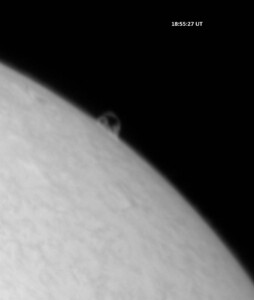 |
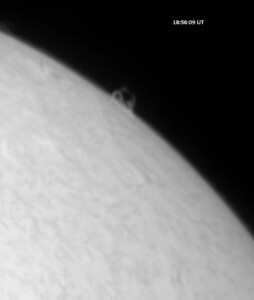 |
 |
 |
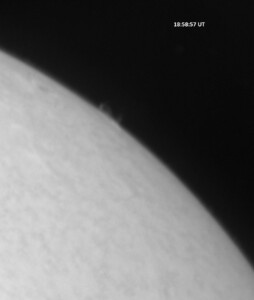 |
Each of the following four images cover 13.8’x13.8′ on the Sun with celestial north up, west right. The red continuum images are presented in the left column and the H-alpha images are in the right column. Each is a 0.5 second exposure made at the time indicated on the image.
Solar activity is likely to remain at moderate levels with M-class flares probable along with a slight chance of X-class flares through 24 May. The source of these flares would likely be AR 13683, 13679, and 13685. Old AR 13663 is anticipated to rotate into view on 23 May, and old AR 13664 is expected to rotate into view on 26 May.
May 21, 2024
Solar activity has been at low levels but bumped up to moderate levels with an M1.9/1N flare from AR 13679 at 19:31 UT (shortly after we closed for observations for the day). AR 13685 has grown slightly but had only produced a few low-level C-class flares. AR 13683 produced a C6.7 flare at 5:54 UT on 20 May, and this generated a CME and filament eruption, but most of the material may have been reabsorbed back into the Sun. AR 13679 and 13684 had some growth but remained quiet (prior to the M1 flare from the former this afternoon). In fact, today’s events have mostly come from AR 13683. AR 13686 produced some low level C-class flares yesterday but was completely quiet today. The remaining visible spot groups were quiet, stable, inactive, and/or in decay.
Each image below covers 15.8’x13.8′ on the Sun with celestial north up, west right. The red continuum images are presented in the left column and the H-alpha images are in the right column. Each is a 0.5 second exposure made at the time indicated on the image.
Solar activity is likely to be moderate, with isolated M-class flares possible, and a slight chance for X-class flares through 23 May.
May 20, 2024
We resume daily solar observations after a break due to storms and other events. The Sun has quieted down dramatically since AR 13664 rotated over the western limb. It’s last recorded X-flare occurred at 8:40 on 15 May, an X3.2. This was less than a day after the region produced an X8.7 around 16.57 UT on 14 May (a look visually a few minutes after the flare’s peak revealed no white light signature). Then, what would become AR 13685 produced an X2.9 six hours later. That was the last X-flare up through 20 May. The region produced an M7.2 at 17:21 UT on 17 May, then the below mentioned M-class flares on 19 May.
Solar activity was at moderate levels: it was moderate yesterday due to an M1.9/1N at 19/1344 UTC, an M2.5/1B at, 19/1756 UTC, and an M1.6/1n at 19/2159 UTC. AR 13685 had rotated onto the solar disk, grew, and is now the largest and most magnetically complex region on the disk. AR 13683 produced a C6.7 flare early today at 05:54 UTC
Except where indicated otherwise, each image below covers 13.8’x13.8′ on the Sun with celestial north up, west right. The red continuum images are presented in the left column and the H-alpha images are in the right column. Each is a 0.5 second exposure made at the time indicated on the image.
Solar activity is likely to be moderate, with M-class flares possible, and a slight chance for X-class flares through 22 May.
———————————————————————————————————————-
May 9, 2024
Solar activity continues to be at high levels due to the continued major flares coming from AR 13664. The weather yesterday and today has been much cloudier and hazier than expected and only in the late afternoon hours had the skies cleared enough to allow for some imaging, but the quality is lower than normal due to the thick haze and smoke present. AR 13664 grew some more and merged (and absorbed) AR 13668 and the two together will be referred to as AR 13664. This AR produced many M-class flares and three X-class flares in the last 36-48 hours, the most recent being an X1.1 at 17:44UT. The largest of these was an X2.2/3B flare. All of these flares have sent many Coronal Mass Ejections toward Earth, as is shown in the animated GIF below (click on the image for animation) from spaceweather.com. The bright dot on the right edge is Venus and the less bright dot on the left edge is Jupiter. All of these CME’s are merging into each other, a phenomena known as cannibalization, an these are expected to strike the Earth’s magnetic field in the early UT hours of 11 May.
AR 13664 now exceeds 1500 millionths in size and is easily visible with the (properly protected) unaided eye. AR 13663 is in the process of rotating out of view and is in the process of decaying, losing its magnetic delta configuration. It continues to produce isolated M-class flares and optical flares. The other five spotted active regions are stable. In addition to all this, a 35 degree long filament erupted from the northeast quadrant of the Sun’s disk, producing a CME that is moving off in the northeasterly direction away from Earth.
The first image is an afocal image, 1/250 second exposure, through the eyepiece of a 4.5 inch telescope to show the full solar disk and immense size of 13664. The second and third images are red continuum, 0.5 second exposures. The lower right image is a 1.0 second H-alpha exposure. Due to the significant haze and murkiness of the sky at the time of imaging the H-alpha contrast is greatly reduced and image artefacts (i.e. “extra spots”) are greatly enhanced. The images were recorded at the time indicated and each in the bottom row cover 13.8’x13.8′ on the sky. The images are oriented so that celestial north is up, west is right in each image. Solar north is rotated 22.7 degrees right or clockwise with respect the celestial north in each of the gray telescopic images.
 |
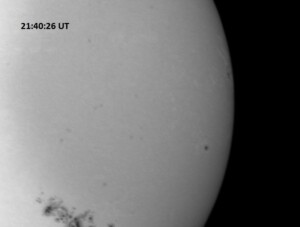 AR 13666 (below center close to limb) is featured in this continuum image. The other images below focus primarily on AR 13664. AR 13666 (below center close to limb) is featured in this continuum image. The other images below focus primarily on AR 13664. |
 |
 |
The Sun is expected to persist at high to very high levels through 11 May, with M-class flares expected and X-class flares likely due to the flare potential of AR 13664.
May 7, 2024
Solar activity remained at high levels, with AR 13663 producing the vast majority of the M-class flares. The largest of these was an M5.1 at 6:16 UT today. Since then, many additional M-class flares–including an M8.2 at 16:30 UT (the very moment we opened the dome) from AR 13663. AR 13664 also produced some M-class flares today, four in all. We observed an M2.1 from 13664 at 20:22 UT. This was followed by an M3.3 from AR 13663 at 21:26 UT. From 20:14 UT to this writing (23:05 UT) the X-ray background level has been above M1.0, slowly undulating since the M3.3, and another M3.3 from 13664 (possibly just a bump up of the X-ray background as the optical event did not appear too impressive). Both AR 13663 and 13664 remain magnetically complex and the largest regions on the disk. AR 13668 has grown some also, but remained inactive. The remaining spotted active regions remain stable or are in gradual decay.
The first column below displays the red continuum images (each 0.5 second exposure) and the second column the H-alpha images (each also a 0.5 second exposure). The images were recorded at the time indicated and each covers 13.8’x13.8′ on the sky. The images are oriented so that celestial north is up, west is right in each image. Solar north is rotated 22.7 degrees right or clockwise with respect the celestial north in each image.
The Sun is expected to stay at moderate to high activity levels through at least 9 May. M class flares are expected and a high chance of X-class flares continues, due to the flaring potentials of AR 13663 and 13664.
May 6, 2024
Since our last observing session three days ago, the sun has become “hyperactive”. There were four X-class flares (X1.6, X1.2, X1.2, and X4.5) and numerous M-class flares since 2 May, all from AR 13663. This region produced an X4.5/3B flare at 6:35 UT today, which is one of the strongest solar flares of the current solar cycle so far. This region produced 8 M-class flares from 12:30 UTC on 5 May to 12:30 UTC on 6 May. Since then it has quieted down considerably but is still expected to produce M-class and possibly more X-class flares. This region has been the most active so far of this current solar cycle. The below image is an animation of the X4.5 flare as observed by the Solar Dynamics Observatory Satellite.
AR’s 13663 and 13664 continue to be the largest, most complex regions on the visible solar disk. They grew slightly over the last day or so. The 8 additional spotted active regions were mainly stable or in slow decay.
The first column below displays the red continuum images (each 0.5 second exposure) and the second column the H-alpha images (each also a 0.5 second exposure). The images were recorded at the time indicated on each. The red continuum images each cover 18.0’x13.8′ on the sky; the images H-alpha images each cover 13.8’x13.8′. The images are oriented so that celestial north is up, west is right in each image. Solar north is rotated 22.9 degrees right or clockwise with respect the celestial north in each image.
The Sun is expected to stay at moderate to high activity levels through at least 8 May. M class flares are expected and a high chance of X-class flares continues, due to the flaring potentials of AR 13663 and 13664.
May 2, 2024
After some heavy rainfall and severe thunderstorms, the skies unexpectedly cleared by mid-afternoon, allowing for an observing session.
The Sun reached moderate levels of activity on 1 to 2 May, with three M1 flares occurring: AR 13663 produced an M1.8/SN at 22:31 UT on 1 May, and an M1.0/SN at 2:19 UT on 2 May; AR 13654 produced an M1.8/SN at 14:32 UT on 1 May. This region is rotating over the WSW limb of the Sun while AR 13663 grows rapidly. AR 13664 also produced an M2.7 flare just before we were on-band for H-alpha observations. This region would go on to produce an X1.6 /1B flare at 2:19 UT on 3 May, along with the multiple M-class flares.
AR 13664 rotated into view and grew and it was the source for many C-class flares. Then it produced multiple M-class flares, including an M4.4/SB at 8:11 UT on 3 May.
The first column below displays the red continuum images (each 0.5 second exposure) and the second column the H-alpha images (each also a 0.5 second exposure). The images were recorded at the time indicated on each. The images on the first row each cover 18.0’x13.8′ on the sky; the images in the second row each cover 13.8’x13.8′. Each image is oriented so that celestial north is up, west is right in each image. Solar north is rotated 23.8 degrees right or clockwise with respect the celestial north in each image.
Solar activity is likely to be moderate with a chance for X-class flares through 5 May.
April 30, 2024
Solar activity reached moderate levels today AR 13654 produced an M1.6 flare at 1:14 UT on 30 April. It later produced a pair of M1 flares 1 hour 22 minutes apart: an M1.2/SF at 15:11 UT, and an M1.3/SF at 16:33 UT. We observed this last one almost in its entirety. In addition, this region also produced numerous C-class flares (and is the only active region flaring today), including a C8.5/1N, also observed from our facility. This region continues to grow and become more complex as it rotates closer to the western edge of the Sun. The remaining five spotted active regions currently visible on the solar disk are either stable or in decay.
Aside from two optical sub-flares at 20:07 and 20:15 UT (and possibly more that may have not been reported yet), since the M1.3 that we observed earlier (see below image), the Sun had become quiet, through at least 23:15 UT, 30 April.
The first column below displays the red continuum images (each 0.5 second exposure) and the second column the H-alpha images (each also a 0.5 second exposure). The images were recorded at the time indicated on each; each image covers 13.8’x13.8′ on the sky except where indicated otherwise. Each image is oriented so that celestial north is up, west is right in each image. Solar north is rotated 24.1 degrees right or clockwise with respect the celestial north in each image.
Solar activity is expected to be low with a chance for M-class flares through 2 May.
April 29, 2024
Most of the many active regions / spot groups visible on the solar disk last week have rotated out of view, with only the “southeast complex” remaining. This is now rotating toward the southwestern limb and AR 13654 has grown significantly since last week. It produced two M-class flares early today: an M2.5 flare at 0:48 UT today and an M3.7 flare at 1:11 UT today. This region continues to grow today. We observed a C8.6/1N flare from start to finish this afternoon during the observing session. Aside from the AR 13654 and 13656 pair, with AR 13655 the single spot south of the pair, a small clutch of sunspots have rotated onto the northeastern disk. There are four very small active regions of one to two spots each, and (aside from 13654), all the visible active regions were stable or in decay
Each of the below images are 0.5 second exposures, were obtained at the times indicated, and cover 13.6’x13.6′ on the sky. Celestial north is up, west is right in each image; solar north is rotated 24.2 degrees clockwise from celestial north.
Solar activity is expected to be low through 1 May with a chance for M-class flares.
April 24, 2024
Solar activity remained at moderate levels with a slight decrease over the last 36 hours or so. There were four low-level M-class flares observed, then three near-M-class flares (upper level C) and an M-class flare is in progress as of this writing (22:57 UTC< 24 April). There still remains 18 spot groups on the visible disk of the Sun, including a complex of six groups toward the Southwest. AR 13650 has decayed considerably; AR 13643 has grown a bit; and AR 13645 has decayed some but produced the largest flare yesterday and today: an M2.9 at 17:44 UT on 23 April. AR 13654 experienced changes in its magnetic flux pattern. The other spot groups are stable or slowly changing. The current event was an M2.0 flare that just peaked at 22:59 UT, but it is difficult to ascertain where it came from as no region shows any obvious brightening. There was some interesting surging prominence activity on the limb just ahead of the southwestern active region complex which may have been the source.
The images were obtained at the times indicated on the image. The left column contains the red continuum images, and the right column contains the H-alpha line centered images. Each image is a 0.5 sec exposure and covers 13.8’x13.8′ on the sun unless otherwise indicated. Celestial north is up, west is right in each image. Solar north is rotated right/clockwise by 25.0 degrees.
Solar activity is expected to be moderate to high, with M-class flares expected and a chance for an X-class flare through 26 April.
April 23, 2024
There continues to be 18 spotted active regions/sunspot groups on the visible solar disk. There were also an abundance of M-class flares overnight, sending solar activity levels to the high range. Since yesterday there were a total of nine M-class flares coming from various active regions, the most recent of which was an M2.9/1N from AR 13645 at 17:44 UT (several hours after it clouded over at our location after this morning’s brief session). AR 13654 produced the largest of these, an M3.6 today at 3:19 UT. Decaying AR 13638 produced an M1.5 flare yesterday at 21:16 UT. AR 13645 produced two additional M1 flares yesterday at 13:35 UT and 14:55 UT and has shown some growth. AR 13646 produced an M1.6 flare at 15:19 yesterday and became larger and more magnetically complex. AR 13654 also produced an M3.0 flare today at 8:21 UT and grew some. AR 13656 is in decay but it managed to produced an M2.8 flare yesterday at 15:50 UT and an M1.0 flare yesterday at 16:30 UT.
A filament erupted just south of disk center overnight at 3:30 UT on 23 April. There was no coronal mass ejection observed from this event.
The images were obtained at the times indicated on the image. The left column contains the red continuum images, and the right column contains the H-alpha line centered images. Each image is a 0.5 sec exposure and covers 13.8’x13.8′ on the sun unless otherwise indicated. Celestial north is up, west is right in each image. Solar north is rotated right/clockwise by 25.1 degrees.
Solar activity is expected to be moderate to high, with M-class flares expected and a chance for an X-class flare through 25 April.
April 22, 2024
There are 18 spotted active regions/sunspot groups, most of which are stable and unremarkable. However, solar activity has been at moderate levels in recent days due to the large number of low-level M-class flares. AR 13645 produced two M1.0/1F flares at 12:59 UT on 21 April and 8:13 UT on 22 April, but became mostly stable after a short period of minor growth. AR 13638 produced an M2.2/1N flare at 15:14 UT on 21 April and an M3.4/SN flare at 21:52 UT on 21 April, and then started to decay a bit. AR 13646 and 13652 showed growth yesterday. AR 13645 produced another M-class flare just before this morning’s observing session: an M1.6/1N that peaked at 13:35 UT. This was followed by an M1.1/1F/SF that occurred at 14:55 UT from AR 13646 (while we were collecting the white-light sequence of images). Then AR 13656 produced an M2.8/SF that peaked at 15:50 UT (the decay part of this event is shown below). There was an M1.0 from an undetermined region at 16:30 UT today, then presently another M-class flare, an M1.6 event, is coming from AR 13638.
Observations of all these events are limited this week due to various end-of-semester commitments.
The images were obtained at the times indicated on the image. The left column contains the red continuum images, and the right column contains the H-alpha line centered images. Each image is a 0.5 sec exposure and covers 18.0’x13.8′ on the sun unless otherwise indicated. Celestial north is up, west is right in each image. Solar north is rotated right/clockwise by 25.4 degrees.
Solar activity is expected to be low, with M-class flares expected and a chance for an X-class flare through 24 April.
April 19, 2024
We had thought that the skies, cloudy all day (in spite of partly sunny conditions) were going to clear at last late afternoon only to cloud back up less than 20 minutes later. This was enough to conduct a quick follow-up, continuum-only session to document the visible sunspot groups on the Sun. Activity has dropped from moderate earlier today to low as the M-class flares have stopped for the time being. The largest recently was an M2.1 flare at 4:53 UT from AR 13647. This region also produced an M1.0 at 13:06 UT, the last M-flare until now (22:49 UT).
Each of the below images were obtained at the times indicated and the images cropped as noted. The images were cropped to remove the artefacts from “having too many spots” on the Sun, preventing good flats being obtained. Celestial north is up, west is right in each image; solar north is rotated 25.6 degrees clockwise from celestial north.
Solar activity is expected to be moderate, with M-class flares expected and a slight chance for X-class flares.
April 18, 2024
After lacking spots for a while, the Sun has now 12 spotted regions on its visible disk, including a cluster of four just south and east of disk center. Solar activity was at moderate levels, with AR 13643 producing 3 M-class events yesterday and today. The largest was an M2.2/SF at 2:48 UT today, and the most recent (up till 23:17 UT) from this region was an M1.3 at 7:37 UT. AR 13647 produced a long duration M1.6 peaking at 20:16 UT. Several other regions contributed C-class and optical sub-flares today. But most of the visible regions were either stable or in decay. There were a series of eruptions from near AR 13638 yesterday after 17:30 UT and these produced multiple CMEs, which are expected to miss Earth.
When many spots are present near the middle of the solar disk, it becomes difficult to get a good flat field image for calibration. Hence the bright speckles that appear in the lower left corners of the below images, resulting from the spots intruding on the flat fields. This will continue until these spots move out of the central zone of the solar disk.
The first column below displays the red continuum images (each 0.5 second exposure, of the same zone, the first unlabeled, the second labeled) and the second column the H-alpha images (each a 0.5 second exposure). The images were recorded at the time indicated on each; The red continuum images cover 15.3’x13.8′, and the H-alpha images cover 13.8’x13.8′ on the sky and is oriented so that celestial north is up, west is right in each image. Solar north is rotated 26.1 degrees right or clockwise with respect the celestial north in each image.
Solar activity is expected to be moderate with M-class flares likely and a slight chance for X-class flares through 20 April.
April 12, 2024
Solar activity returned to low levels after yesterday’s M5.4 flare from an active region just over the east limb of the Sun. That same region likely produced a C8.9 flare today at 17:55 UT (GONG H-alpha images of the time did not show any of the visible active regions flaring). AR 13634 produced a C5.5 / SF at 3:27 UT early today. This, and AR 13635, have shown slight growth, and these, along with AR 13636, have contributed fairly regular C-class and optical sub-flares today.
The filament that erupted yesterday produced a CME which is expected to deliver a glancing impact on Earth’s magnetic field sometime on 14 April. Another filament, a 17-degree long one, began erupting today around 0:20 UT but has yet not shown signs of producing a significant CME.
The first column below displays the red continuum images (each 0.5 second exposure) and the second column the H-alpha images (each a 0.5 second exposure). The images were recorded at the time indicated on each; Each image covers 13.8’x13.8′ on the sky and is oriented so that celestial north is up, west is right in each image. Solar north is rotated 26.1 degrees right or clockwise with respect the celestial north in each image.
Solar activity is expected to be low with a chance for M-class flares through 13 April.
April 11, 2024
Solar activity was at low levels today until an impulsive M5.4 flare at 17:06 UT raised it to high levels. This was the first M-class flare in several weeks and likely from AR 13615, which is expected to rotate over the eastern limb in a day or two. There had been numerous C-class flares observed yesterday and again today, mostly from regions beyond the east and west limbs. AR 13628 has decayed some and has been quiet. AR 13633 is also decaying but remains the most complex region on the visible solar disk, magnetically speaking. This region was a source of C-class activity. AR 13635 produced most of the C-class activity today, with AR 13636, 13633, and 13634 contributing some of the activity.
A filament, approximately 15 degrees long, lifted off the solar disk (north of disk center) between 5:15 and 6:05 UT today. It remains to be seen if it produced a CME or not (it likely has) and if this is headed toward Earth.
The first column below displays the red continuum images (each 0.5 second exposure) and the second column the H-alpha images (each a 0.5 second exposure). The images were recorded at the time indicated on each; Each image covers 13.8’x13.8′ on the sky and is oriented so that celestial north is up, west is right in each image. Solar north is rotated 26.1 degrees right or clockwise with respect the celestial north in each image.
Solar activity is expected to be low with a slight chance for M-class flares through 11 April. The chance for isolated M-class flares increases on 12-13 April due to the anticipated return of old AR 13615.
April 5, 2024
C-class flares returned early today for the first time since late day 1 April. Solar activity seems to be stirring again with two new active regions emerging onto the disk since yesterday. A region beyond the ESE limb produced a C3.8 flare at 3:05 UT. AR 13630 produced a C2.0 at 13:07 UT this morning. Three C1 flares came from undisclosed regions, possibly the same one that is about to rotate into view. There are five spotted regions on the Sun today, all of them small and quiet, though AR 13629 is growing slowly. The largest region continues to be AR 13628, with an area of 110 MSH.
The first column below displays the red continuum images (each 0.5 second exposure) and the second column the H-alpha images (each a 0.5 second exposure). The images were recorded at the time indicated on each; Each image covers 13.8’x13.8′ on the sky and is oriented so that celestial north is up, west is right in each image. Solar north is rotated 26.2 degrees right or clockwise with respect the celestial north in each image.
Solar activity is expected to be low with a slight chance for C-class flares through 7 April.
April 4, 2024
Aside from a B5 (17:26 UT) and a B8 (18:23 UT) today, there have been no solar flares over the last couple of days. All four visible spotted active regions are small and magnetically simple.
The first image is a red continuum image; the second image is an H-alpha image, each image a 0.5 second exposure covering 13.8’x13.8′ on the Sun. The images were recorded at the time indicated and are oriented so that celestial north is up, west is right in each image. Solar north is rotated 26.3 degrees clockwise in these images.
 |
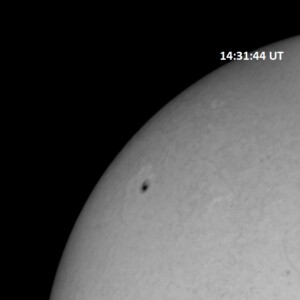 |
Solar activity is expected to remain low with only a slight chance of an M-class flare through 6 April.
April 3, 2024
Solar activity continues to be very low. The large spot first noted yesterday as a notch in the solar limb rotated into view and became AR 13628. AR 13624 and 13626 became more well defined. AR 13627 and an unnumbered, single, tiny spot make a total of five spots visible on the solar disk.
The first image is a white-light image taken with a SeeStar S50 telescope. The second is a red continuum image and the third is an H-alpha image, The second image is a 0.25 second exposure and third images is a 0.5 second exposure, each covering 13.8’x13.8′ on the Sun. The second and third images were recorded at the time indicated and are oriented so that celestial north is up, west is right in each image. Solar north is rotated 26 degrees clockwise in these images.
 Full disk white light image showing the overall solar disk. Full disk white light image showing the overall solar disk. |
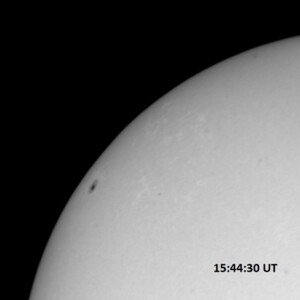 Detail of northeast disk highlighting AR 13628. Detail of northeast disk highlighting AR 13628. |
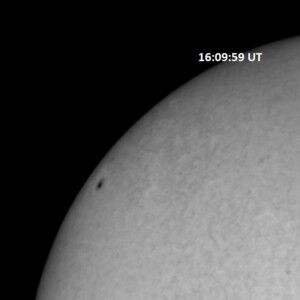 H-alpha image of the same part of the Sun. H-alpha image of the same part of the Sun. |
Solar activity is expected to be low, with a slight chance for M-class flares through 5 April.
April 2, 2024
After a “final” M3 class flare on 1 April peaking at 1:30 UT, the Sun had become totally quiet. The X-ray background fluctuated around the B9/C1 level the rest of 1 April, then dropped below C1 late on 1 April and continued a gradual decline that continues to this writing. Currently the X-ray background is at the B4 level and solar activity is characterized as very low. AR 13625, which grew and became active over the weekend, has rotated out of view. New region AR 13627 was observed today and is pictured below; it was the only visible spot on the solar disk.
Upon closer inspection another, much larger spot complex is JUST STARTING to make itself visible on the solar limb and will rotate into better view over the next two days. This should lift solar activity back to “low” levels and perhaps return a few flares to the daily solar routine.
The first image is a white light full-disk solar image taken afocally through a small telescope showing the lack of features on today’s Sun. The second image, also a full disk image, was taken yesterday on Mars by the Perseverance Rover. This image (from Spaceweather.com) shows the large spot groups that graced the Earth-facing side of the Sun two weeks ago. AR 13615 is still as large and complex as ever (but no farside CME’s have been reported so it may be in a quiet phase).
The bottom two images are today’s PVSO images, the bottom left image is the red continuum image of the northeast solar disk. The large active region about to appear (arrowed) shows as a “dent” in the solar limb. the second image (lower right) is the H-alpha image of the same part of the Sun. Each of the two PVSO images are 0.5 second exposures recorded at the time indicated on each. Each PVSO image covers 13.8’x13.8′ on the sky and is oriented so that celestial north is up, west is right in each image. Solar north is rotated 26 degrees right or clockwise with respect the celestial north in each image.
Solar activity is expected to be low with a slight chance for M-class flares through 4 April.
March 28, 2024
Solar activity increased to high levels early today as AR 13615 produced an M7.1/1N flare at 6:29 UT. This region remains the largest and most complex region visible on the solar disk , covering an area of 960 millionths of a solar hemisphere. This flare did not generate a CME, but a C8.4 flare from this same region at 9:43 UTC today did generate a CME. The remaining regions, all on the western half of the solar disk (except for tiny AR 13620) are small, simple and mainly quiet. AR has been the source of all the flare activity so far today, including another M-class flare, an M6.1/1N at 15:56 UT, and a C8.4/SF at 17:07 UT today. Observations began after 18:00 UT this afternoon. AR 13615 produced an M1.1 flare at 19:31 UT and an X1.1/3B at 20:56 UT. Both events were observed in their entirety during this afternoon’s observing session.
The first image is a red continuum image; the second image is an H-alpha image, each image a 0.5 second exposure covering 13.8’x13.8′ on the Sun. The images were recorded at the time indicated and are oriented so that celestial north is up, west is right in each image. Solar north is rotated 25.9 degrees clockwise in these images.
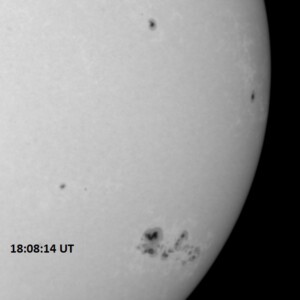 |
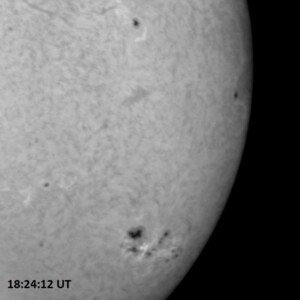 |
Solar activity is expected continue to be moderate to high, with the chance for an X-class flare, primarily due to AR 13615, through 29 March. This region rotates over the western limb on 30 March, decreasing probabilities to just a chance for M-class flares.
March 27, 2024
The sun’s activity reached high levels yesterday due to the large number of M-class flares. Five of these came from AR 13615, the largest of which was an M1.9 at 13:30 UT on 26 March. This region continues to be the largest, most complex region on the visible solar disk and was responsible for the majority of the activity. This region was the source for numerous C-class and optical sub-flares today, plus two M1.1 flares at 1:44 and 6:41 UT today. Since the second M-flare there had been no further M-class flares through at least 23:30 UT today. AR 13615 is showing signs of decay, however, so its flare potential may be decreasing as it rotates closer to the western limb. The four other spotted active regions were mostly stable.
A filament erupted just north of AR 13620 yesterday at 14:05 UT. We were observing at that time but the focus was on AR 13615. The filament generated a CME which may graze the Earth’s magnetic field early on 31 March.
The first image is a white-light image taken afocally through a 11.4 cm reflector. The second is a red continuum image and the third is an H-alpha image, The second and third images are each a 0.5 second exposure covering 13.8’x13.8′ on the Sun. The images were recorded at the time indicated and are oriented so that celestial north is up, west is right in each image. Solar north is rotated 25.6 degrees clockwise in these images.
Solar activity is expected to continue to be moderate, with a chance for X-class flares through 29 March due mainly to the flare potential of AR 13615.
March 26, 2024
The Sun continued at moderate levels of activity today, with four M-class flares produced by AR 13615 between 0:36 and 13:46 UT today, 26 March. The largest of these was an M1.8 at 0:36 UT today. The string of M-flares ended just as we opened for the observing session this morning and only C-class flares have occurred occasionally through 21:50 UT today. Shortly after that, AR 13615 produced an M1.6 flare that peaked at 21:58 UI (after we stopped observations for the day). This region has begun to decay, but remains the largest on the visible disk. The remaining spotted groups, quite small in comparison, were stable and quiet. The emerging flux of spots noted yesterday afternoon just south and west of AR 13615 had decayed completely by this morning.
The first image is a red continuum image; the second image is an H-alpha image, each image a 0.5 second exposure covering 13.8’x14.6′ on the Sun. The images were recorded at the time indicated and are oriented so that celestial north is up, west is right in each image. Solar north is rotated 25.6 degrees clockwise in these images.
Solar activity is expected to be moderate with M-class flares likely and a chance for X-class flares through 28 March. AR 13615 has the potential to produce large flares during this time.
March 25, 2024
Solar activity was at moderate levels due to M-class flares from AR 13615. The largest event in the last 24 hours or so was an M4.4/SB that occurred at 6:44 UT this morning, 25 March. At around 1:30 UT on 23 March, AR 13614 and 13615 combined to produce an X1.1 flare, which was the result of a pair of sympathetic solar flares from these regions. AR 13614 started with a larger flare, which triggered a smaller flare in 13615. This came from the likelihood that the two active regions were connected by a bundle of magnetic field loops, which resulted in a long duration X1.1 flare, complete with a CME that impacted yesterday (24 March) producing major G4 level geomagnetic storms. Since this event, there had been a lot of M-class flares over the weekend, at least 21 from 4:40 UT 23 March to 13:35 UT, 24 March. Since then, the activity subsided, the waning activity interrupted by the afore-mentioned M4 flare event.
AR 13615 was the largest region with an estimated area of 1130 millionths of a solar hemisphere. AR 13619 grew slightly, and the rest of the spotted active regions were either stable or in decay. There were a total of seven spotted active regions with a possible new region emerging near S19 W32, just southwest of AR 13915. This has not yet been confirmed.
The first image is a red continuum image; the second image is an H-alpha image, each image a 0.5 second exposure covering 13.8’x17.1′ on the Sun. The images were recorded at the time indicated and are oriented so that celestial north is up, west is right in each image. Solar north is rotated 25.6 degrees clockwise in these images.
Solar activity is expected to be moderate with M-class flares likely and a chance for X-class flares through 27 March. AR 13615 has the potential to produce large flares during this time.
March 22, 2024
The Sun was at low activity levels until this afternoon’s M4 / SN flare, which coincided with our short observing session. This flare came from AR 13615 which is the most active and complex region on the visible solar disk, responsible for an M7 flare at 7:36 UT on 20 March. It was the source of two more M-class flares and many C-class flares, including a C5.9 that happened at 20:12 UT today, only 20 minutes before the peak of the M4.2 that was observed this afternoon (our observations started one minute prior to the X-ray peak of the M4, then continued through its decay). AR’s 13618 and 13619 gradually developed, with the remaining active regions either stable or in slow decay.
The first image is a red continuum image covering 13.8’x13.8′ on the solar disk; the second image is an H-alpha image focused on AR 13615, covering 12.1’x13.8′ on the Sun. The images, each a 0.5 second exposure, were recorded at the time indicated and are oriented so that celestial north is up, west is right in each image.
Solar activity is expected to be low with an increasing chance for M-class flares through 24 March.
———————————————————————————————————————————
March 8, 2024
Solar activity continues to be low. AR 13599 is the largest, most complex active region on the visible solar disk, covering 140 MSH and sporting a complex ‘beta-gamma-delta’ magnetic configuration. The region has decayed a bit but is still producing nearly all of the flares over the last two days. The largest of these was a C6.7 at 12:07 UT on 7 March. Only a few low level C-class flares since until an M1.3 occurred at 21:26 UT from AR 13599. This just pushed solar activity back into the moderate range and is the first M-class flare in more than a week. All the other regions were unremarkable. All of them are located within the central region of the Sun’s disk and can fit in a single frame as shown below.
This will be the last observing session until at least 18 March (likely longer) due to Spring Break and other factors.
The first image is a red continuum image of five active regions (labeled); the second image is an H-alpha image of the same region. The images, each a 0.5 second exposure, were recorded at the time indicated on each; Each image covers 18.0’x13.8′ on the sky and is oriented so that celestial north is up, west is right in each image. Solar north is rotated 23 degrees right or clockwise with respect the celestial north in each image.
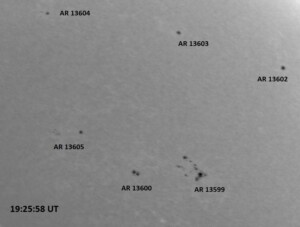 The six visible spotted regions are recorded in one frame on the sky. The six visible spotted regions are recorded in one frame on the sky. |
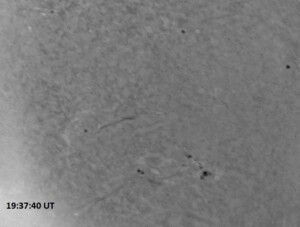 A few filaments are added to the scene in this H-alpha view. The glow at lower left is an ongoing issue with the CCD chip. A few filaments are added to the scene in this H-alpha view. The glow at lower left is an ongoing issue with the CCD chip. |
Solar activity is expected to be low with an increasing chance for M-class flares through 10 March.
March 6, 2024
Solar activity remains low, with only a few low-level C-class flares occurring both yesterday and today. AR 13599 and 13604 showed some growth, while the other four regions were either stable or in decay. AR 13595 has rotated out of view, and AR 13591 is nearing the western limb of the Sun and will be out of visibility in another day or so. A filament erupted in the southeast quadrant of the disk yesterday, this produced a coronal mass ejection.
The first image is a red continuum image of five active regions (labeled); the second image is an H-alpha image of the same region. The images, each a 0.5 second exposure, were recorded at the time indicated on each; Each image covers 18.0’x13.8′ on the sky and is oriented so that celestial north is up, west is right in each image. Solar north is rotated 22.8 degrees right or clockwise with respect the celestial north in each image.
Solar activity is expected to be low with a slight chance for M-class flares through 8 March.
March 5, 2024
Low solar activity continues with seven small spotted regions currently on the visible solar disk. C-class flares came from AR’s 13595, 13598, 13599, 13600, and 13602. AR’s 13598 and 13595 continue to decay as they exit the visible disk. Today was completely quiet with only a few C1 flares after 1400 UT today. There was a C2.6 from AR 13598 at 11:25 UT, the largest today so far.
The first column below displays the red continuum images (each 0.5 second exposure) and the second column the H-alpha images (each a 0.5 second exposure). The images were recorded at the time indicated on each; Each image covers 13.8’x13.8′ on the sky and is oriented so that celestial north is up, west is right in each image. Solar north is rotated 22.5 degrees right or clockwise with respect the celestial north in each image.
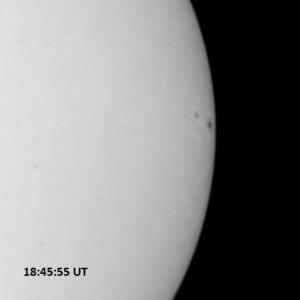 AR 13595 about to rotate out of view. AR 13595 about to rotate out of view. |
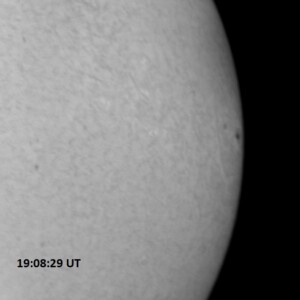 Same view in H-alpha. Same view in H-alpha. |
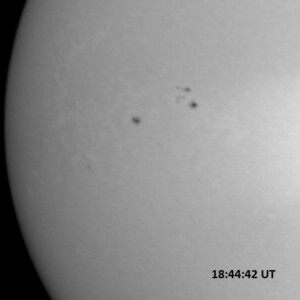 AR 13599 (“stacked” spots, right) and 13600 (single spot, left). AR 13599 (“stacked” spots, right) and 13600 (single spot, left). |
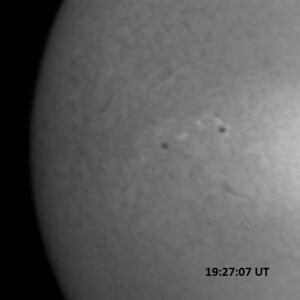 AR 13600 and 13599 plus a filament or two. AR 13600 and 13599 plus a filament or two. |
Solar activity is expected to be low with a slight chance for M-class flares through 7 March.
March 4, 2024
Solar activity has been low for five days now. The last M-class flare was the long-duration event that peaked at 18:50 UT on 28 February. Since then the largest event was a C6.6 on 2 March at 12:50. More recently, low-level C-class flares occurred from AR 13598, 13599, and 13602. ARs 13595 and 13598 each continue to decay as they are about to rotate over the western limb. The remaining regions were mainly quiet and unremarkable.
The first column below displays the red continuum images (each 0.5 second exposure) and the second column the H-alpha images (each a 0.5 second exposure). The images were recorded at the time indicated on each; Each image covers 13.8’x13.8′ on the sky and is oriented so that celestial north is up, west is right in each image. Solar north is rotated 22.5 degrees right or clockwise with respect the celestial north in each image.
Solar activity is expected to be low with a chance for M-class flares through 5 March, decreasing to a slight chance on 6 March.
March 1, 2024
Solar activity remains low. AR 13590 produced most of the C-class flare activity over the last two days. It maintains a complex structure as it prepares to rotate out of view. AR 13595 and 13598 are becoming more complex and grew in size and sunspot count. The other regions were quiet and stable.
The first image is a red continuum image of the western disk of the Sun; the second image is an H-alpha image of the same region. The images, each a 0.5 second exposure, were recorded at the time indicated on each; Each image covers 13.8’x13.8′ on the sky and is oriented so that celestial north is up, west is right in each image. Solar north is rotated 21 degrees right or clockwise with respect the celestial north in each image.
Solar activity is expected to be low with a chance for M-class flares through 3 March and a slight chance for an X-class flare through 2 March.
February 28, 2024
After several days of inactivity, AR 13590 finally produced a notable flare event. This was a “slow motion”, long duration M1.5 flare that started around 16:55 UT, peaked near 18:54 UT and ended around 23:00 UT. This is the firs M-class flare in three days, during which time this region was expected to produce M-class flares and possibly one or two more X-class flare. The region did begin flaring again, four C-class events prior to the M1 flare. Low level C-class flares also came from AR 13594, 13595, and 13596. AR 13595 is growing steadily and is beginning to take on more complex gamma magnetic field configurations. A C5.1/SF flare came from a spotless region east of AR 13592. A filament erupted and produced a CME, which was observed off the south center solar disk by SOHO at 11:00 UT on 27 February.
Aside from AR 13590 and 13595, all the other four spotted active regions were unremarkable. Another, unnumbered spotted region emerged near N7E20, east of AR 13594. All the spot regions form a distinct “T” shape across the solar disk.
The first column below displays the red continuum images (each 0.5 second exposure) and the second column the H-alpha images (each a 0.5 second exposure). The images were recorded at the time indicated on each; Each image covers 13.8’x13.8′ on the sky (except where indicated otherwise) and is oriented so that celestial north is up, west is right in each image. Solar north is rotated 21 degrees right or clockwise with respect the celestial north in each image.
Solar activity is expected to be low with a chance for M-class flares and a slight chance for an X-class flare through 1 March.
February 27, 2024
https://www.swpc.noaa.gov/news/sunspot-region-3590-evolution-february-19-27th on the evolution of AR 13590.
Solar activity is now at low levels. AR 13590 provided the largest flare over the last day with a C3.4 at 7:42 UT this morning. This would be the last recorded flare that this region produced from then to this writing (0:15 UT, 28 February). Other regions produced optical subflares: AR 13591, 13595, and 13596. AR 13595 produced the most of any region today, including a C1.5 at 14:35 UT and a C1.7 at 20:00 today (not observed since the focus was on AR 13590 today).
The first column below displays the red continuum images (each 0.1 second exposure) and the second column the H-alpha images (each a 0.5 second exposure). The images were recorded at the time indicated on each; Each image covers 13.8’x13.8′ on the sky and is oriented so that celestial north is up, west is right in each image. Solar north is rotated 21 degrees right or clockwise with respect the celestial north in each image.
Solar activity is expected to be low with a chance for M-class flares and a slight chance for an X-class flare through 29 February.
February 26, 2024
Solar activity was moderate yesterday with a single M2.0/1N flare from AR 13590. This region has grown to 1450 MSH, the largest of the current solar cycle. Since this M-class event yesterday, there have been no further events through 22:45 UT 26 February. The largest since the M2 flare was a C3.6 flare, which has not yet been listed in the event log. The other five numbered active regions were unremarkable.
Each image was taken at the time indicated; each was a 0.5 second exposure and is cropped to 13.8’x13.8′ in size. Celestial north is up, west is right in each image (Solar north is rotated 20.7 degrees clockwise from celestial north. The first image is a red continuum, taken through a thin sheet of cirrostratus. The remaining H-alpha images were taken through relatively clear skies.
 |
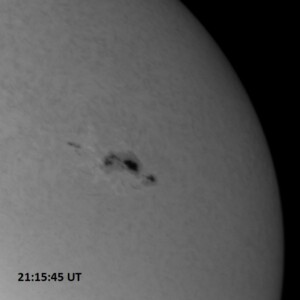 |
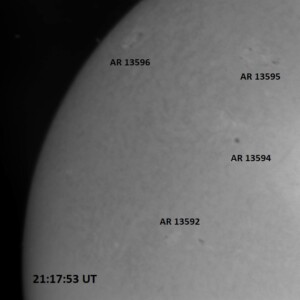 |
Solar activity is expected to stay moderate , with M-class flares still likely, and a chance for X-class flare activity, through 28 February.
February 24, 2024
AR 13590 continues to grow and dominate the visible solar hemisphere. Solar activity was high, with seven M-class flares since yesterday, two of which happened earlier today. The largest of these was an M4.5 at 6:34 UT today. There was also an M3.6 at 11:19 UT today. This would be the last M-class flare for today. We conducted a short follow-up observing session this afternoon to document the ongoing development of AR 13590, which is pictured in 3 of the 4 images below.
Three of the four images below are continuum images. The first is a wide field view of AR 13590. The second, immediately right of it is a closeup of the region. The third, immediately below the first, is a view of AR 13590 in H-alpha. Finally, the fourth is an image o the three active regions (top to bottom) AR 13594, 13592, and 13591. Each are 0.5 second exposures and are oriented so that celestial north is up, west is right. The white spots in the images are artifacts from the image processing.
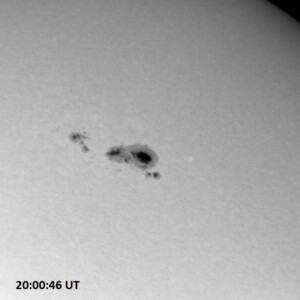 |
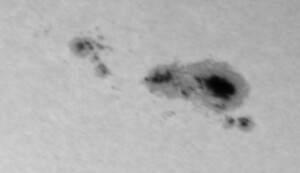 |
 |
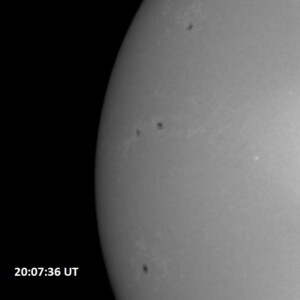 |
Solar activity is expected to remain at moderate levels with M-class flares likely and a chance of X-class flares through 26 February 2024.
February 23, 2024
Solar activity today retreated back to moderate levels. As of 23:45 UT on 23 February, there have been no further X-flares from AR 13590. Interestingly, none of the three X-flares from AR 13590 have produced coronal mass ejections. The region remains large and magnetically complex and has the potential for more strong flare production. AR 13594 produced 3 M-class flares: an M1.0 at 13:28 UT today; an M1.4 at 15:53 UT; and the largest of the three, an M2.6/1N at 17:47 UT. The image below was obtained as part of a series that documented the development of this flare from start to finish. It was recorded between the optical peak of 17:43 UT and the X-ray peak of 17:47 UT. The region also produced a number of C-class flares, one of which (a C5) was observed at PVSO.
Five new sunspot groups appeared since yesterday, bringing the total to seven, five of which are numbered. Two are tiny groups near the west limb, and three are small groups that just rotated over the east limb. One of these, AR 13591, produced an M1.5 flare at 0:14 UT on 22 February.
The first column below displays the red continuum images (each 0.1 second exposure) and the second column the H-alpha images (each a 0.5 second exposure). The images were recorded at the time indicated on each; Each image covers 13.8’x13.8′ on the sky and is oriented so that celestial north is up, west is right in each image. Solar north is rotated 20 degrees right or clockwise with respect the celestial north in each image.
Solar activity is expected to be high through 25 February with M-class flares likely and a chance for X-class flares.
February 22, 2024
Solar activity reached high levels with a pair of X flares from AR 13590 at 23:07 UT on 21 Feb and again at 6:32 UT on 22 Feb. Today it produced an M4.8 flare which peaked at 20:46 UT (shown in the bottom left image below). This was followed shortly by an X6.3/3B event which peaked at 22:34 UT. Both events were observed in their entirety at the PVSO. In fact, the X6 was the largest flare of the current solar cycle and the largest flare ever observed at PVSO! The bronze colored image below is from the Solar Dynamics Observatory in extreme UV. Former region AR 13575 is just beginning to rotate into view and it has a history of large flares, it may contribute to the activity in coming days.
The first image displays a red continuum image of AR 13590; the rest of the images are in H-alpha. Each image is a 0.5 second exposure, with the time indicated on each. Each image covers 13.8’x13.8′ on the sky and is oriented so that celestial north is up, west is right in each image. Solar north is rotated 19 degrees right or clockwise with respect the celestial north in each image.
Solar activity is expected to be high through 25 February with M-class flares likely and a chance for X-class flares from AR 13590 and possibly from the returning AR 13575.
February 21, 2024
Even with a growing and complex sunspot group AR 13590 (area of 760 MSH), solar activity remained low with only regular low-level C-class flares today. Another region, AR 13586 (90 MSH), is simple and stable and AR 13584 is difficult to distinguish as it decays.
But at 23:07 UT today, AR 13590 produced an X1.8 flare. This happened after we had closed for the day so we did not image this event. The below image was from the Solar Dynamics Observatory satellite, and the flare is the bright spot in the upper left part of the disk.
The first column below displays the red continuum images (each 0.1 second exposure) and the second column the H-alpha images (each a 0.5 second exposure). The images were recorded at the time indicated on each; Each image covers 13.8’x13.8′ on the sky and is oriented so that celestial north is up, west is right in each image. Solar north is rotated 18.8 degrees right or clockwise with respect the celestial north in each image.
Solar activity is expected to be low with a chance for M-class flares through 23 February.
February 20, 2024
There continues to be low solar activity with no M-flares observed anywhere through at least 21:05 UT, 20 February. AR 13583 produced a few C-class flares as it rotated out of view. AR 13590 is the largest on the visible disk, covering 530 MSH; AR 13586 is second with an area of 160 MSH. AR 13583 had an area of 170 MSH but it just rotated out of visibility. AR 13590 produced the largest flare of the last two days, a C5.7 at 12:47 UT yesterday. The other three spotted active regions were quite unremarkable. A c2.8 flare was observed by our solar observatory to have originated at AR 13584; this event peaked at 15:56 UT. We observed the tail end of another event: a C2.7 flare from AR 13590, peaking at 17:12 UT. Other than these events, the sun remains very quiet.
The first image displays a red continuum image of AR 13590; the rest of the images are in H-alpha. Each image is a 0.5 second exposure, with the time indicated on each. Each image covers 13.8’x13.8′ on the sky and is oriented so that celestial north is up, west is right in each image. Solar north is rotated 19 degrees right or clockwise with respect the celestial north in each image.
Solar activity is expected to be low with a chance for M-class flares through 22 February.
February 19, 2024
AR 13576 rotated over the southwestern limb of the Sun three days ago and as it did so, it produced an X2.5 flare at 6:53 UT on 16 February. This was followed by an M2.9 at 22:10 UT on the same date. Since that last M-class flare, there has been no further M- or X-class activity up until this writing (21:37 UTC 19 February). Most of the currently visible sunspot groups are small and quiet. Yesterday, C-class activity came from AR 13576 (from beyond the western limb), 13583, and 13590. The latter AR is rotating into view on the ENE limb and it appears to be a large region. The largest flares today were a C6.7 at 9:40 UT today from AR 13590, and a C5.7 at 12:47 UT today, also from AR 13590. AR 13683 contributed two flares today: a C1.9 at 1:47 UT, and a C2.6, at 6:40 UT today. Solar activity continued to be low, with few low-level C-class flares, through the rest of today, through 21:37 UT
The first column below displays the red continuum images, and the second column the H-alpha images, each a 0.5 second exposure. The images were recorded at the time indicated on each; Each image covers 13.8’x13.8′ on the sky and is oriented so that celestial north is up, west is right in each image. Solar north is rotated 18.8 degrees right or clockwise with respect the celestial north in each image.
Solar activity is expected to be low with a chance for M-class flares through 21 February.
February 14, 2024
AR 13582 produced an M1.0 flare at 3:10 UT today, followed by an M1.0 flare at 7:35 UT today. Since then, these regions, along with AR 13584, produced quite a few C-class flares, the largest of which was a C7.5 at 17:56 UT today (image of the flare captured through thin cirrus appears immediately below, 13.8’x13.8′ in size on the sky).
AR 13483 continues to grow in size overall, but it had seen some decay in the middle part. A new spot is rotating into view on the NE limb of the Sun. The remaining active regions were quiet and unremarkable. There are currently eight spotted regions on the visible solar disk, six of which are numbered. The largest of these continues to be AR 13576, with an area of 600 Millionths of a Solar Hemisphere (MSH). Second and third place are AR’s 13583 and 13582, with areas of 270 and 240 MSH respectively. The remaining regions were 50 MSH or smaller each.
The first image is a red continuum of most of the active regions currently visible on the Sun; it is a 0.5 second exposure. The second image is an H-alpha image of the same region, also a 0.5 second exposure. Both are recorded at the time indicated on the image, cover 13.8’x18.0′ on the sky, and are oriented so that celestial north is up, west is right (solar north is rotated 16.5 degrees counterclockwise/right of celestial north).
Solar activity is likely to reach moderate levels, with a slight chance for X-class flares through 16 February.
February 13, 2024
Ever since the long duration M2.6 flare from a hidden active region over the NE limb, the Sun has been quiet, with only a C4.9/SF flare from AR 13583 at 1:38 UT today. An unspecified source produced a C5.0 at 7:59 UT today. This is the largest flare today through 21:00 UTC 13 February. AR’s 13582 and 13583 continued a slower pace of growth while AR 13576 appeared to have decayed some (but still maintains a complex magnetic configuration). This region was the target of a day long flare watch today at PVSO. All the other regions on the Sun were quiet and inactive. The AR over the NE limb has not yet revealed itself.
The first image is a red continuum of most of the active regions currently visible on the Sun; it is a 0.5 second exposure. The second image is an H-alpha image of the same region, also a 0.5 second exposure. Both are recorded at the time indicated on the image, cover 13.8’x17.1′ on the sky, and are oriented so that celestial north is up, west is right (solar north is rotated 16.5 degrees counterclockwise/right of celestial north).
Solar activity is likely to reach moderate levels from time to time, with a slight chance for X-class flares through 15 February.
February 12, 2024
The Sun remains rather active, with mid-to high-level M-class flares occurring nearly every day. AT 13:10 UT on 9 February, AR 13575, which had rotated over the limb a day earlier, produced an X3.3 flare. AR 13576 had been the source of many M-class flares, mostly low level, but one was almost an X-class: an M9.0 at 23:07 UT on 10 February. This was followed by an impulsive M6.5/2B at 3:48 UT on 12 February. This region also produced a C6.9 flare at 5:54 UT, 12 February. An active region just beyond the NE limb produced an M1.0 flare at 22:45 UT on 11 February. Since the last observing session, AR 13582 and 13583 emerged on the visible solar disk (only two days ago they first appeared) and grew rapidly. AR 13576 did show some decay.
Today, AR 13583 and 13576 were the only two active regions to generate solar flares, with an M1.1 coming from AR 13576 at 13:08 and an M1.4/1F coming from the same region at 15:48 UT. When the weather cleared and the seeing settled to allow observations at PVSO to resume (around 20:00 UT) these regions had quieted down considerably. There continued to be activity on the northeast limb, however, that we followed. This was the source of a long-duration M2.6 flare that peaked at 21:17 UT.
The first image is a red continuum of most of the active regions currently visible on the Sun; it is a 0.25 second exposure. The second image is an H-alpha image of the same region, a 0.5 second exposure. Both are recorded at the time indicated on the image, cover 13.8’x18.0′ on the sky, and are oriented so that celestial north is up, west is right (solar north is rotated 16.5 degrees counterclockwise/right of celestial north).
Solar activity is likely to reach moderate levels from time to time, with a slight chance for X-class flares through 14 February.
February 7, 2024
The Sun once again achieved high levels of activity overnight with a M1.3 flare at 18:49 UT on 6 February and a long duration M5.1/SF at 3:31 UT on 7 February, both from AR 13575. This flare produced a coronal mass ejection that was observed five minutes after the peak of the M5 flare. A SOHO GIF sequence of the CME is shown below (click to animate).
AR 13575 is in decay but still maintains enough magnetic complexity (referred to as a “delta” configuration) to produce further flares. AR 13576 maintains its complexity but is decreasing in areal coverage, now down to 540 MSH from over 700 two days ago. AR 13571 is the third largest spot group on the disk (110 MSH, after 13575’s 250 MSH) but has been completely quiet. All the other spotted and numbered active regions (a total of 10 visible) are quiet and stable.
The first column within the table below displays the red continuum images, and the second column the H-alpha images, each a 0.5 second exposure. The images were recorded at the time indicated on each; the images of AR 13575 cover 13.8’x13.8′ on the sky, and the images of AR 13576 cover 15.9’x13.8′ on the sky. All five are oriented so that celestial north is up, west is right in each image. Solar north is rotated 14 degrees right or clockwise with respect the celestial north in each image.
The below image shows the M1 flare observed today about two minutes prior to its X-ray peak flux. It was a rather long-duration event and the most powerful so far since last night’s M5.1 (through 23:05 UTC, 7 February).
It is likely that solar activity will continue at moderate levels with occasional M-class flares and a chance for an isolated X-class flare through 8 February. AR 13575 has begun to rotate over the SW limb, and as it is carried further and further out of view by solar rotation, the flare probabilities will decrease to a chance for M-class flares and a slight chance for X-class flares on 9 February and possibly afterwards.
February 6, 2024
Solar activity continued at moderate levels with an M2.2 at 2:28 UT today and a long duration M4.2 flare peaking at 3:12 UT today. Both of these were from AR 13575, and both of these flares generated CMEs. Slight decay and some separation occurred in the smaller leader spots of AR 13575. The same occurred in the trailing spots of 13576. Both continue to be the largest (AR 13575 is 270 MSH and AR 13576 is 610 MSH) and most complex sunspot groups visible on the solar disk. The other spots were small, quiet, unremarkable.
We monitored AR 13576 the entire day, but the region only produced C-class and optical subflares. The largest during our session was a C6.2 at 18:35 UT. A C5.1 and C6.2 also occurred during our session, then everything quieted down after the M1.3 that came from AR 13575. We are only able to monitor one of these regions so we did not observe this flare.
The first column below displays the red continuum images, and the second column the H-alpha images, each a 0.5 second exposure. The images were recorded at the time indicated on each; Each image in the top row covers 13.8’x13.8′ on the sky, and each in the bottom row cover 18.0’x13.8′ on the sky, and are oriented so that celestial north is up, west is right in each image. Solar north is rotated 14 degrees right or clockwise with respect the celestial north in each image.
Solar activity is likely to continue at moderate to high levels, with occasional M-class flares and a chance for an isolated X-class flare through 7 February. The chance for X-class flares decrease on 8 February as AR 13575 rotates over the SW limb.
February 5, 2024
Two large active regions are now visible on the Sun. AR 13575 developed late last week and has grown in size and complexity. AR 13576 was observed on Mars last week by the Perseverance rover and has rotated into view three days ago. Both have increased the probability of M-class flares occurring. Over a 12 hour period from 12UT 4 Feb until 12UT 5 Feb there were over a dozen M-class flares, mostly from AR 13576. The largest of these was an M2.7 at 22:37 UT on 4 February. The region continued to produce most of today’s flares, including two M flares within two hours of each other and many C-flares.
This image (click for animation) shows the development of AR 13576 (lower left part of the Sun’s disk). AR 13575 is in the lower right part of the Sun’s disk. AR 13575 covers 350 millionths of a solar hemisphere (MSH) while 13576 covers twice as much area, 700 MSH. The other six spotted regions were unremarkable.
The first column below displays the red continuum images, 0.25 second exposures; and the second column shows the H-alpha images, each of these a 0.5 second exposure. The images were recorded at the time indicated on each; Each image covers 13.8’x13.8′ on the sky and are oriented so that celestial north is up, west is right in each image. Solar north is rotated 14 degrees right or clockwise with respect the celestial north in each image.
Solar activity is likely to reach moderate to high levels, with M-class flares expected and an increased chance for X-class flares through 7 February. This is due to the flare potentials of AR 13575 and 13576.
February 1, 2024
Solar activity remains at low levels today with only C-class flare activity. AR’s 13571 and 13567 were the only two named regions which produced C-class flares, the largest of which (so far, as of 21:00 UT on 1 Feb.) was a C3.0 from an unspecified location. More regions continue to rotate into view or emerge on the eastern half of the disk, and these are shown below, with the numbered regions labeled. The C3 event was a long-duration event from a region of enhanced flux near the solar meridian. This region produced a coronal mass ejection which is Earth-bound and due to arrive late on
The first column below displays the red continuum image, and the second column the H-alpha image, each a 0.5 second exposure. The images were recorded at the time indicated on each and are oriented so that celestial north is up, west is right in each image. Solar north is rotated 12 degrees right or clockwise with respect the celestial north in each image.
Solar activity is likely to remain low the next three days, but (primarily) AR 13567 (along with other regions) will keep a chance of M-flares in place through 3 February.
January 31, 2024
The Sun continued at low activity levels with only C-class flares yesterday and today. The largest of these was yesterday’s C5 event that came from AR 13559, which had just rotated out of view. AR 13567 is currently the largest and most complex active region on the visible disk and was the source of a C4.5 at 8:29 UT today, the second largest since yesterday. Today there are nine spot groups on the visible disk of the Sun (four have emerged or rotated into view since yesterday) but only five of these are currently numbered. All of these were unremarkable today.
The first column below displays the red continuum images, and the second column the H-alpha images, each a 0.5 second exposure. The images were recorded at the time indicated on each; Each image covers 13.8’x13.8′ on the sky and are oriented so that celestial north is up, west is right in each image. Solar north is rotated 12 degrees right or clockwise with respect the celestial north in each image.
Solar activity is likely to remain low the next three days, but (primarily) AR 13567 will keep an elevated chance of M-flares in place through 2 February.
January 30, 2024
Solar activity remains low after yesterday’s brief surge of activity overnight. There were only occasional C-flares. AR 13559 has rotated out of view. AR 13566 emerged a day or so ago and was numbered, and the larger region rotating into view was also numbered as AR 13567. There were two simple spots visible but were not numbered yet. A total of five spotted active regions are visible on the solar disk.
The first column below displays the red continuum images, and the second column the H-alpha images, each a 0.5 second exposure. The images were recorded at the time indicated on each; Each image covers 13.8’x13.8′ on the sky and are oriented so that celestial north is up, west is right in each image. Solar north is rotated 11 degrees right or clockwise with respect the celestial north in each image.
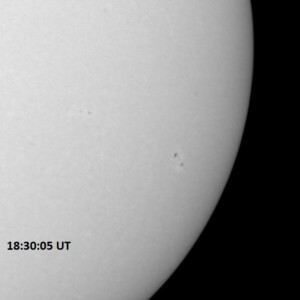 |
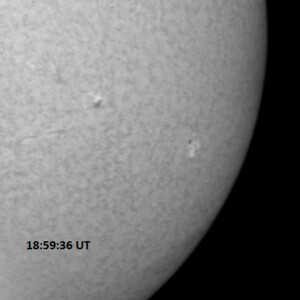 |
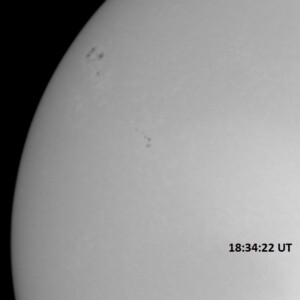 |
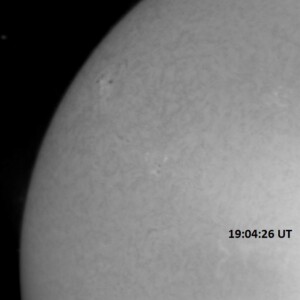 |
Solar activity is expected to be low, with a chance for M-class flares though 1 February.
January 29, 2024
The extended period of weather unfavorable for observation was largely the cause of a 10 day hiatus in solar observations. Last week saw a period which included 13 M-class flares over a 1.5 day period, from late 22 January to early 24 January. Nearly all of these were from AR 13561. After one more M-class flare late 24 January, the activity subsided to include only C-class flares (two of which were nearly M-class early on 27 January), which became less frequent and lower in magnitude. The silence was interrupted early this morning by a pair of M-class flares from departing region AR 13559. The first was an M1.2/SF at 1:40 UT and an M6.7 at 4:38 UT, which generated a solar particle event that is ongoing as of this writing (22:45 UT 29 January).
The number of sunspots has decreased since last week as the active longitudes rotate over the western limb of the sun. Only five numbered ARs are currently visible, plus three no-name groups or individual spots. One of the numbered regions is rotating over the limb and two more have nearly lost their spots. Since a C5.9 that was observed in AR 13559 this morning at the observatory, the x-ray flux background has nearly flatlined at the C1 level, through this writing.
The first column below displays the red continuum images, and the second column the H-alpha images, each a 0.5 second exposure. The images were recorded at the time indicated on each; Each image covers 13.8’x13.8′ on the sky and are oriented so that celestial north is up, west is right in each image. Solar north is rotated 11 degrees right or clockwise with respect the celestial north in each image.
Solar activity is expected to be low, with a chance for M-class flares from now through 31 January. There was an increasing chance for M-flares today, 29 January, due to AR 13559, but those chances decrease as the region rotates over the limb.
January 19, 2024
Solar activity continued to be low, with only low-level C-class flare activity. AR 13559 has grown some, and a new flux or bundle of magnetic fields has emerged southwest of AR 13555. The rest of the 11 numbered regions were either stable or in decay.
The first column below displays the red continuum images, and the second column the H-alpha images, each a 0.5 second exposure. The images were recorded at the time indicated on each; The top two images each cover 13.8’x18.0′ on the sky, and the second row images each cover 13.8’x13.8 in apparent size. Celestial north is up, west is right in each image.
Solar activity is expected to be low, with a chance for M-class flares from now through 21 January.
January 18, 2024
The Sun is maintaining an extended period of low activity. This is the 7th day in a row with low activity and no M-class flares. The largest flare of the last six days was a C9.5 that happened at 12:06 UT on 14 January. More recently the larges flare recently was a C5 that happened at 4:08 UT on 18 January and came from AR 13553. Despite the large number of sunspot groups (9 as of this afternoon’s count), there has not been any significant activity.
The first column below displays the red continuum images, and the second column the H-alpha images, each a 0.5 second exposure. The images were recorded at the time indicated on each, and each cover 13.8’x13.8 in apparent size, except where indicated otherwise. Celestial north is up, west is right in each image.
Solar activity is expected to be low, with a chance for M-class flares through 20 January.
January 12, 2024
Solar activity remained at moderate levels with four low-level M-class flares. The largest of these was an M1.5 at 17:52 UT on 11 January, from AR 13539. This region became stable and also produced several C-class flares. AR13540 and 13547 were stable and inactive; AR 13541 decayed some, and new regions 13548 and 13549 were inactive as well.
The first column below displays the red continuum images, and the second column the H-alpha images, each a 0.5 second exposure. The images were recorded at the time indicated on each, and each cover 13.8’x13.8 in apparent size. Celestial north is up, west is right in each image.
Solar activity is expected to be mainly at low levels with a chance of M-class flares through 14 January.
January 11, 2024
Solar activity reached and remained at moderate levels yesterday into today, with an AR from just beyond the SE limb producing an M1.1 flare at 12:55 UT on 10 January. That region has rotated into view today. AR 13538 was the source of an M1.7 flare at 23:28 UT on 10 January. AR 13538 produced an M1.3 flare today at 12:51 UT, and an M1.2 flare today at 19:23 UT (while clouds were delaying our opening for today’s observations). AR 13539 produced an M1.5 flare at 17:52 UT. AR 13538 was also the source of some high-level C-class flares today.
AR continues to grow as it approaches the western limb but it it about to rotate out of view in another day or so. AR 13539, following 13538 toward the western limb, also grew and developed some; this was the source of C-clas flares. The remaining regions (ten now visible, plus three un-numbered regions that emerged onto the disk and a fourth, yet to be numbered, rotated into view) were mainly quiet and stable. Filaments continue to launch off the Sun: one started to do so quickly at 20:28 UT yesterday, on the east limb of the Sun, this produced a C5.6 flare that peaked at 20:41 UT on 10 January; another filament was observed to lift off at 5:30 UT on 11 January.
The first column below displays the red continuum images, each a 0.5 second exposure. The second column includes the H-alpha images, each 1.0 second exposure. The images were recorded at the time indicated on each, and cover the size noted in the caption. Celestial north is up, west is right in each image.
Solar activity is expected to at low levels with an ongoing chance of M-class flares through 13 January.
January 10, 2024
Solar activity continues to be low, with only minor C-class flares occurring. The two largest in the last two days, so far (as of 21:25 UT, 10 Jan.) was a C9.6 at 3:25 UTC today from AR 13538, and an M1.4 at 12:55 UT today, from an unspecified location. Today, the C-flares have been coming from AR’s 13538 (5 events, the most of any region today), 13536 (one event this afternoon), 13540 (one optical sub-flare) and 13546 (two events). There are a total of 11 numbered spotted active regions on the visible solar disk today, but only 10 of them were observed this morning during the daily sunspot counts. AR’s 13538 and 13539 are slowly growing, as is AR 13546, with the rest of these spot groups either stable or in decay.
Filaments continue to lift off the Sun: one just beyond the SE limb and the other (around 45 degrees long) just south of AR 13541. Both started doing so just after 14:00 UTC. An eruptive prominence, in the shape of a tall loop, was observed from PVSO at 21:14. This feature had faded almost entirely by 21:18 UT.
The first column displays the red continuum images of each of the visible spotted active regions on the solar disk. Each of these images is a 0.5 second exposure. The second column displays H-alpha line centered images of the same zones on the Sun depicted by the continuum images. Each of these is 1.0 second exposure. Each image covers 13.8’x13.8′ on the sun and has celestial north up, west right (solar north is rotated two degrees clockwise from celestial north).
Solar activity is expected to be low, with a continuing chance for M-class flares from now through 12 January.
January 9, 2024
AR 13536 rotated into view on December 31 and produced an X5.0/3B flare at 21:49 UT, the largest of the current solar cycle. Since then, it had rotated into better view and generated several more M-class flares before quieting down. The most recent M-class flare was a M3.9 that occurred at 1:56 UT on 4 January. Since this event, there had been no further M-class flares (all C-class) up until the time of this posting (20:00 UT 9 January). The largest event in the past two days was a C5.7 that happened at 15:50 UT on 8 January from AR 13538. This region is growing some, in contrast with AR 13536, which is slowly decaying. AR’s 13539, 13542, and 13544 were quiet and stable; AR 13540 decayed some; ARs 13541 and 13543 grew slightly; and AR 13545 rotated into view. Another group, soon-to-be numbered AR 13546, emerged east of the 13540/13541 pair.
Another event of note was an erupting filament, which began to liftoff near the southeast limb at 17:00 UTC on 8 January. This 24 degree long filament the produced a Coronal Mass Ejection, which was first seen by SOHO LASCO satellite imagery at 00:48 UT on 9 January.
Four individual images are displayed below, with two copies of each of the continuum image. Each of the images is a 0.5 second exposure. The first column contains the continuum images of the east and west solar disk, showing all the visible spotted active regions currently on the solar disk. The second/middle column are the same images as the left column, but with the active regions/sunspot groups labeled. The right most column includes the H-alpha line center images of each zone on the Sun. The UT of image acquisition is provided in one corner of each image. Each frame covers 13.8’x13.8′ on the sky and is oriented so that celestial north is up, west is right. Solar north is offset from celestial north by two degrees to the right.
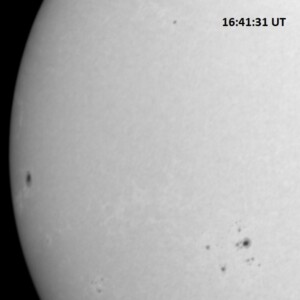 |
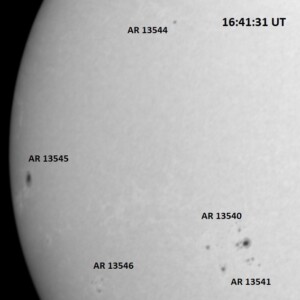 |
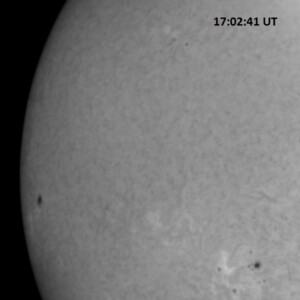 |
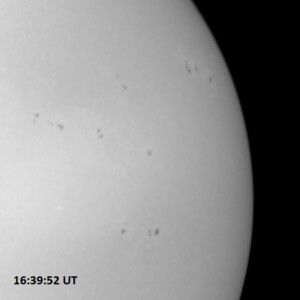 |
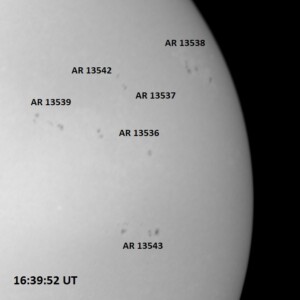 |
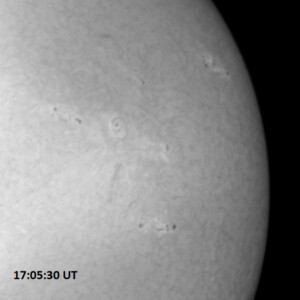 |
Solar activity is expected to be at low levels, with a chance for M-class flares and a slight chance for X-class flares through 11 January.
==========================================================




